geoengineering
description: deliberate and large-scale intervention in the Earth’s climate system
143 results
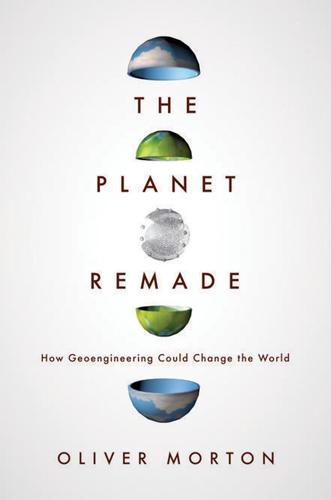
The Planet Remade: How Geoengineering Could Change the World
by
Oliver Morton
Published 26 Sep 2015
The Concert’s approach seeks to build on the general benefits such clubs can provide by making it possible to link climate geoengineering to pledges on mitigation, and possibly to other things, too. The link between geoengineering and mitigation is normally taken to be an either/or – the existence of geoengineering is taken to mean a lowered likelihood of mitigation. But, as the legal scholar Edward Parson has argued, some forms of linkage with climate geoengineering could make mitigation easier to coordinate, and thus mean that the world sees greater reductions in emissions. This is not true for all geoengineering scenarios. As Parson points out, if geoengineering is seen only as a response to an emergency at some unspecified time in the future, attempts to link it to mitigation actions in the present – for example, by saying that if people mitigate strongly today they will be allowed to geoengineer if it becomes really necessary, or that if they don’t they won’t – look entirely impractical.
…
The reason I think this approach exacerbates the moral-hazard problem is that it gets rid of prohibitions against talking about geoengineering without providing an incentive to work hard on finding ways in which geoengineering could actually be made to work – by which I mean not just how it could deliver climate benefits, but how it could do so in a just and responsible manner. My feeling is that most of the moral hazard posed by geoengineering is experienced up front; the very fact that there is geoengineering research is what creates the hazard. But not all geoengineering research is equally well suited to reducing further risks. Risk reduction depends on finding – indeed, designing – approaches that might work and approaches that definitely don’t work.
…
But the intervention and the mess are not indistinguishable, and this seems to me a last way in which human intervention in the nitrogen cycle deserves to be seen as geoengineering. In debates on geoengineering the climate, one often hears the idea that geoengineering is already under way, in that humans are already doing huge amounts to the Earth’s surface, atmosphere and biogeochemical cycles. This is sometimes used as an argument for doing purposeful geoengineering, on the basis that it would just be a continuation of what is going on already, but more thoughtfully and to a better end. It is sometimes used as an argument against geoengineering, on the basis that the mess shows that humans can’t handle such planetary processes, and that trying to fix the problems of this ‘geoengineering’ with deliberate geoengineering is likely to be both fruitless and wrongheaded.

This Changes Everything: Capitalism vs. The Climate
by
Naomi Klein
Published 15 Sep 2014
Voices from Africa,” presentation at “The Ethics of Geoengineering: Investigating the Moral Challenges of Solar Radiation Management,” University of Montana, Missoula, October 18, 2010. 26. Alan Robock, Martin Bunzl, Ben Kravitz, and Georgiy L. Stenchikov, “A Test for Geoengineering?” Science 327 (2010): 530; Alan Robock, Luke Oman, and Georgiy L. Stenchikov, “Regional Climate Responses to Geoengineering with Tropical and Arctic SO2 Injections,” Journal of Geophysical Research 113 (2008): D16101. 27. Robock, Bunzl, Kravitz, and Stenchikov, “A Test for Geoengineering?” 530. 28. Martin Bunzl, “Geoengineering Research Reservations,” presentation to the American Association for the Advancement of Science, February 20, 2010; Fleming, Fixing the Sky, 2. 29.
…
But you’d have to deploy these methods on a scale large enough to impact the global climate system to be certain about how, for instance, spraying sulfur in the Arctic or the tropics will impact rainfall in the Sahara or southern India. But that wouldn’t be a test of geoengineering; it would actually be conducting geoengineering.26 Nor could the necessary answers be found from a brief geoengineering stint—pumping sulfur for, say, one year. Because of the huge variations in global weather patterns from one year to the next (some monsoon seasons are naturally weaker than others, for instance), as well as the havoc already being wreaked by global warming, it would be impossible to connect a particular storm or drought to an act of geoengineering. Sulfur injections would need to be maintained long enough for a clear pattern to be isolated from both natural fluctuations and the growing impacts of greenhouse gases.
…
Rob Nixon, an author and University of Wisconsin English professor, has evocatively described the brutality of climate change as a form of “slow violence”; geoengineering could well prove to be a tool to significantly speed that up.43 Geoengineering as Shock Doctrine All of this may still seem somewhat abstract but it’s critical to reckon with these harrowing risks now. That’s because if geoengineering were ever deployed, it would almost surely be in an atmosphere of collective panic with scarce time for calm deliberation. Its defenders readily concede as much. Bill Gates describes geoengineering as “just an insurance policy,” something to have “in the back pocket in case things happen faster.”
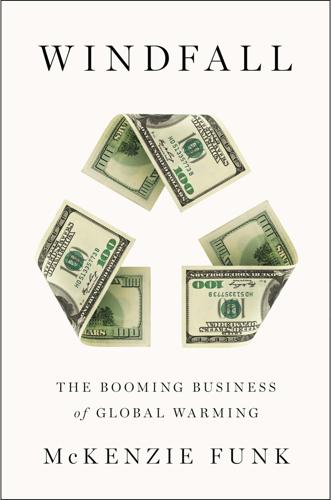
Windfall: The Booming Business of Global Warming
by
Mckenzie Funk
Published 22 Jan 2014
Triage meant that usually only the most commercializable ideas got through. “If an idea is one of the top few in a certain area,” Tegreene said, “then we start patent applications on it.” Knowing all the steps involved, I still found myself wondering why they had gone to the trouble of filing for geoengineering patents. • • • ADVOCATES OF GEOENGINEERING, or at least of geoengineering research, tend to fall into three categories: scientists deeply afraid of runaway climate change; free-market advocates deeply afraid of mandated carbon cuts; and the capitalists or philanthrocapitalists who sustain them both. To find all three, I had only to visit two Washingtons—Washington, D.C., and Washington State.
…
Beginning in 2006, independent of his foundation but in keeping with its focus on techno-fixes, Gates received ad hoc tutoring sessions from Caldeira and another prominent geoengineering researcher. Beginning in 2007, after the pair lamented that there was little money for even the most basic geoengineering research, he provided some. His informal support eventually took on a formal name—the Fund for Innovative Climate and Energy Research, or FICER—and to date it has given out $5.1 million for assorted meetings and research projects. Gates money paid for a turning point in recent geoengineering history. A series of private dinners at the margins of the 2008 American Geophysical Union conference, attended by Caldeira, Wood, one of the AEI co-directors, and more than a dozen senior scientists, was “the moment when the conversation moved from ‘Can we do it?’
…
Myhrvold didn’t need to make the case that geoengineering was desirable. He made it seem inevitable; we wouldn’t manage to do anything else. I felt myself succumbing to the logic. It didn’t matter, I realized, whether or not IV was secretly hoping to turn a profit—whether or not its assertions that it did not “expect or intend” to make money off geoengineering were as misleading as its assertions about patent lawsuits. If one of Myhrvold’s inventions could save the planet, it was beside the point that he might get richer in the process. • • • I DID NOT fully understand what might be saved by geoengineering until one January afternoon in Seattle, on a day that was warmer than average, but not abnormally so, and rainier than average, but not abnormally so, and a climate scientist named Alan Robock led a seminar at the University of Washington.

Under a White Sky: The Nature of the Future
by
Elizabeth Kolbert
Published 15 Mar 2021
“a broad highway to hell”: This assessment comes from Tim Flannery, cited in Mark White, “The Crazy Climate Technofix,” SBS (May 27, 2016), sbs.com.au/topics/science/earth/feature/geoengineering-the-crazy-climate-technofix. “unimaginably drastic”: Holly Jean Buck, After Geoengineering: Climate Tragedy, Repair, and Restoration (London: Verso, 2019), 3. and also as “inevitable”: Dave Levitan, “Geoengineering Is Inevitable,” Gizmodo (Oct. 9, 2018), earther.gizmodo.com/geoengineering-is-inevitable-1829623031. a brief downturn in global temperatures: “Global Effects of Mount Pinatubo,” NASA Earth Observatory (June 15, 2001), earthobservatory.nasa.gov/images/1510/global-effects-of-mount-pinatubo.
…
A chemist by training, Keutsch is one of the leading scientists with Harvard’s Solar Geoengineering Research Program, an effort funded, in part, by Bill Gates. The premise behind solar geoengineering—or, as it’s sometimes more soothingly called, “solar radiation management”—is that if volcanoes can cool the world, people can, too. Throw a gazillion reflective particles into the stratosphere and less sunlight will reach the planet. Temperatures will stop rising—or at least not rise as much—and disaster will be averted. Even in an age of electrified rivers and redesigned rodents, solar geoengineering is out there. It has been described as “dangerous beyond belief,” “a broad highway to hell,” “unimaginably drastic,” and also as “inevitable.”
…
So if there’s pressure from the public to do something fast, my concern is that there will be no tools at hand other than stratospheric geoengineering. And if we start doing research at that point, I am concerned it’s too late, because with stratospheric geoengineering, you’re interfering with a highly complex system. I will add that there are a number of people who do not agree with this. “When I started this, I was perhaps, oddly, not as worried about it,” he observed a few minutes later. “Because the idea that geoengineering would actually happen seemed quite remote. But, over the years, as I see our lack of action on climate, I sometimes get quite anxious that this may actually happen.

Whole Earth Discipline: An Ecopragmatist Manifesto
by
Stewart Brand
Published 15 Mar 2009
Here I’ll draw mainly on a 2008 paper he wrote for the Oxford Review of Economic Policy titled “On the Regulation of Geoengineering.” People imagine, Victor says, that what is needed is a “legally binding regulatory treaty” like the Montreal Protocol governing harm to the ozone layer. But he thinks that “most treaties on geoengineering will be useless or actively harmful because, at present, experts and governments do not know enough about the scope and hazards of possible geoengineering activities to frame a meaningful treaty negotiation.” He especially worries about treaties that would make geoengineering taboo, because “a taboo is likely to be most constraining on the countries (and their subjects) who are likely to do the most responsible testing, assessment, and (if needed) deployment of geoengineering systems.
…
He especially worries about treaties that would make geoengineering taboo, because “a taboo is likely to be most constraining on the countries (and their subjects) who are likely to do the most responsible testing, assessment, and (if needed) deployment of geoengineering systems. A taboo would leave less responsible governments and individuals—those most prone to ignore or avoid inconvenient international norms—to control the technology’s fate.” Because the cost of some geoengineering schemes is so low, Victor predicts, “A lone Greenfinger, self-appointed protector of the planet and working with a small fraction of the Gates bank account, could force a lot of geoengineering on his own.” The way to head off unilateral geoengineering and premature treaties, Victor suggests, is with a growing body of norms rather than rules:Meaningful norms are not crafted from thin air.
…
The three days of discussion basically reaffirmed the “Oxford Principles” first proposed in a 2009 memorandum to the British Parliament by Steve Raynor from Oxford University:• Geoengineering regulated as a public good • Public participation in geoengineering decision-making • Disclosure of geoengineering research and open publication of results • Independent assessment of impacts • Governance before deployment In other words, one way to geoengineer wrong would be for a private company to start injecting sulfur dioxide into the stratosphere without disclosing research plans or research results, without outside monitoring of effects, and without permission of a public governance body.
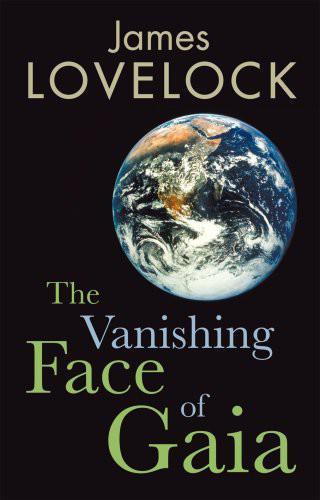
The Vanishing Face of Gaia: A Final Warning
by
James E. Lovelock
Published 1 Jan 2009
The response of the biosphere to climate and compositional change is even less well understood. We may soon need geoengineering applied empirically, because careful observation and measurement show that even today some parts of climate change, for example sea‐level rise, are happening faster than the gloomiest of the forecasts. GEOENGINEERING TECHNIQUES Geoengineering methods fall into three main categories: physical means of amelioration such as the manipulation of the planetary albedo (the amount of sunlight reflected back to space); biological geoengineering that includes tree planting, the fertilization of ocean algal ecosystems with iron, the direct synthesis of food from inorganic raw materials and the production of biofuels; and, finally, active or Gaian geoengineering that involves the use of the Earth’s ecosystem to power the process, or to change the nature of climate feedback from positive to negative.
…
Moreover the observed positive feedback on heating makes it unlikely to slow or stop before the next stable state is reached. Through geoengineering we may ameliorate some of the early consequences of heating but I greatly doubt that we have the wisdom or intelligence to reverse it. Like the skier who accidentally starts an avalanche, there is little we can do to stop its destructive course. So are all our efforts to become carbon neutral, to put on sandals and a hair shirt and follow the green puritans pointless? Can we go back to business as usual for a while and be happy while it lasts? We could – but not for long. Apart from a lucky break of a natural or a geoengineered kind, in a few decades the Earth could cease to be the habitat of 7 billion humans; it will save itself as it dispatches all but a few of those who now live in what will become the barren regions.
…
Does this mean that we can cure global heating by adding some other gas or material that does the opposite and cools? Scientists, including me, think that we may have little option but to try; but surely it is much better to try as a planned experiment than as a panic response to, for example, the simultaneous flooding of several coastal cities. If geoengineering is defined as purposeful human activity that significantly alters the state of the Earth, we became geoengineers soon after our species started using fire for cooking, land clearance, and smelting bronze and iron. There was nothing ‘unnatural’ in this; other organisms have been massively changing the Earth since life began 3.5 billion years ago. Without oxygen from photosynthesizers, for example, there would be no fires.
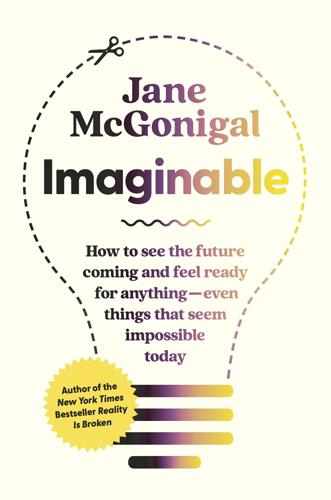
Imaginable: How to See the Future Coming and Feel Ready for Anything―Even Things That Seem Impossible Today
by
Jane McGonigal
Published 22 Mar 2022
Future Simulation #3 1 “From Wet Waste to Flight: Scientists Announce Fast-Track Solution for Net-Zero-Carbon Sustainable Aviation Fuel,” National Renewable Energy Laboratory, March 15, 2021, https://www.nrel.gov/news/program/2021/from-wet-waste-to-flight-scientists-announce-fast-track-solution-for-net-zero-carbon-sustainable-aviation-fuel.html. 2 Jack Williams, “The Epic Volcano Eruption That Led to the ‘Year without a Summer,’ ” Washington Post, June 10, 2016, https://www.washingtonpost.com/news/capital-weather-gang/wp/2015/04/24/the-epic-volcano-eruption-that-led-to-the-year-without-a-summer/. 3 “What Is Geoengineering?,” Oxford Geoengineering Programme, accessed August 27, 2021, http://www.geoengineering.ox.ac.uk/www.geoengineering.ox.ac.uk/what-is-geoengineering/what-is-geoengineering/. 4 Based on a Google Scholar search for scientific papers published between 2016 and mid-2021 with the keywords “geoengineering” and “climate change.” 5 Daisy Dunne, “Explainer: Six Ideas to Limit Global Warming with Solar Geoengineering,” Carbon Brief, September 5, 2018, https://www.carbonbrief.org/explainer-six-ideas-to-limit-global-warming-with-solar-geoengineering; Aylin Woodward, “We’re Altering the Climate So Severely That We’ll Soon Face Apocalyptic Consequences.
…
Here Are 11 Last-Ditch Ways We Could Hack the Planet to Reverse That Trend,” Business Insider, April 20, 2019, https://www.businessinsider.com/geoengineering-how-to-reverse-climate-change-2019-4. 6 Jeff Tollefson, “US Urged to Invest in Sun-Dimming Studies as Climate Warms,” Nature, March 29, 2021, https://www.nature.com/articles/d41586-021-00822-5. 7 Solar Radiation Management Governance Initiative, accessed August 27, 2021, https://www.srmgi.org/. 8 Dana Varinsky, “Silicon Valley’s Largest Accelerator Is Looking for Carbon-Sucking Technologies—Including One That Could Become ‘the Largest Infrastructure Project Ever,’ ” Business Insider, October 27, 2018, https://www.businessinsider.com/silicon-valley-accelerator-y-combinator-startups-remove-co2-2018-10. 9 David Fork and Ross Koningstein, “Engineers: You Can Disrupt Climate Change,” IEEE Spectrum, June 28, 2021, https://spectrum.ieee.org/energy/renewables/engineers-you-can-disrupt-climate-change. 10 “Climate-Related Geoengineering and Biodiversity: Technical and Regulatory Matters on Geoengineering in Relation to the CBD; COP Decisions,” Convention on Biological Diversity, March 23, 2017, https://www.cbd.int/climate/geoengineering/. 11 Natalie L. Kahn and Simon J. Levien, “Indigenous Group Petitions Harvard to Shut Down Controversial Geoengineering Project to Block Sun,” Harvard Crimson, June 27, 2021, https://www.thecrimson.com/article/2021/6/27/saami-council-petition-shut-down-scopex/. 12 “What Is Stratospheric Aerosol injection and Why Do We Need to Govern It?
…
Could a future like this really happen? Let’s look at some of the signals of change and future forces behind “The Ten-Year Winter.” Geoengineering, once considered a fringe idea, is becoming a serious scientific discipline. The Oxford Geoengineering Programme defines it as “the deliberate large-scale intervention in the Earth’s natural systems to counteract climate change.”3 In the past five years, more than 13,500 peer-reviewed scientific papers on geoengineering ideas have been published.4 Proposals include sending a giant mirror into orbit to reflect sun away from the earth; using genetically engineered E. coli bacteria to produce enzymes that convert carbon dioxide into a less harmful substance; and spraying salt water into the clouds above the sea so that they become just a little bigger and brighter, enough to cool specific areas of the planet while leaving the rest unchanged.5 The geoengineering idea that’s furthest along, with the biggest potential impact, is solar radiation management (SRM), in which sulfate particles are injected into the atmosphere—just as described in “The Ten-Year Winter.”

How to Spend a Trillion Dollars
by
Rowan Hooper
Published 15 Jan 2020
Most climate scientists shudder at the thought. One leading advocate of geoengineering angrily told me it was ‘illegitimate’ to spend my money on solar radiation management and that it would be the precise opposite of good governance. Even many of those who work on it say that the best use of geoengineering would be to find a way to avoid doing it and, failing that, we should use it only when it is tied to reductions in carbon emissions (and limit it to removing what we’ve already put into the atmosphere). As we’ll see, there is a lot of interest among billionaires in various geoengineering schemes, but something that affects the entire planet must be something regulated and governed democratically, and we can tie that sort of oversight into our spending.
…
If we want to interfere with the Earth system on this scale, it’s not enough to ensure that any attempt does more good than harm – we have to compensate those people adversely affected. Any budget will factor in these kinds of payments to the total cost. But we may need to try some kind of geoengineering scheme – or at least to prepare the way, to have the possibility of setting one in motion, if (or when) it is essential. In 2019, johan Rockström of the Potsdam Institute for Climate Impact Research in Germany, said that the climate emergency was so severe that we should consider geoengineering.2 It is in some sense already too late. A rise in sea level is already locked in, while the decline of many mountain glaciers and two huge glaciers in western Antarctica has passed the point of no return – they will melt, even if we stopped carbon emissions tomorrow.3 The same may be true for the massive Greenland ice sheet, the second largest ice sheet in the world, after the one that covers Antarctica.4 And there is so much ice on Greenland that if it all melted, it would raise sea levels around the world by six metres.
…
In 1965, when US President Lyndon Johnson’s Science Advisory Committee flagged the dangers of greenhouse gas emissions, they didn’t recommend reducing fossil fuel use. They instead suggested increasing the reflectivity of the Earth to offset the heating. In other words, geoengineering. The Convention on Biological Diversity defines this as ‘a deliberate intervention in the planetary environment of a nature and scale intended to counteract anthropogenic climate change and/or its impacts’. Now, we’re going to look at three different kinds of engineering solutions. First, ideas inspired by Krakatoa. ‘Solar geoengineering’ is the term given to proposals to screen out some of the sunlight reaching the surface of the planet. Some people call this solar radiation management (SRM), which may give the impression that manipulating the atmosphere is simply a case of adjusting the dimmer switch on the Sun.
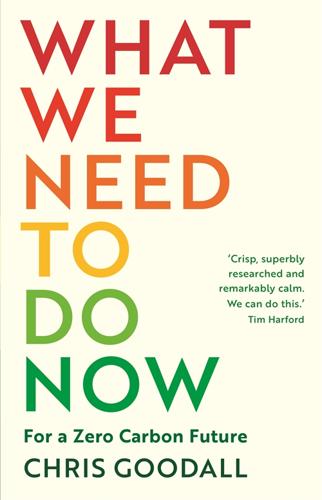
What We Need to Do Now: A Green Deal to Ensure a Habitable Earth
by
Chris Goodall
Published 30 Jan 2020
RESERVATIONS ABOUT GEOENGINEERING Many environmentalists are wholly opposed to geoengineering. They point out the risks of unexpected effects, particularly from large experiments that affect the amount of solar radiation arriving at the surface, and note that scientists do not fully understand the climate system nor can predict what will happen. But, whatever our concerns about the possible disruption to rainfall, it needs to be pointed out that global heating is already hugely affecting where and how much it rains. Professor Joanna Haigh, a leading climate scientist, says that geoengineering also introduces ‘moral hazard’.
…
This is only in part about reforestation, alerting us more widely to the damage to the environment caused by sheep grazing and offering climate-friendly solutions for the restoration of our environment. It provides much of the background for discussion of woodland in this book. GEOENGINEERING Oliver Morton, The Planet Remade: How Geoengineering Could Change the World (Granta, 2016). The best analysis of how the world should think about geoengineering, as Morton dissects the feasible and unfeasible options. CLIMATE CHANGE MITIGATION I hugely admire the work of Carbon Brief (www.carbonbrief.org), a website that publishes detailed and insightful analysis of what is going on in the UK and elsewhere in the fields of renewable energy and the science of climate change.
…
This, again, will help counterbalance remaining greenhouse gas emissions. 9 Introduce a meaningful carbon tax, remitting its proceeds to the less well-off, with the principal objective of incentivising the big fossil fuel companies to switch from oil and gas to zero carbon energy. Capitalism can and should be the servant of the energy transition. 10 Research and plan geoengineering techniques. The world will need to have safe, equitable means to artificially hold down global temperatures. Although ‘geoengineering’ has its risks, we probably have no alternative if we want to keep global temperatures from rising more than 1.5 or 2 degrees celsius. Even the fastest action now looks insufficient to avert dangerous amounts of climate breakdown without measures to block a portion of the sun’s energy.
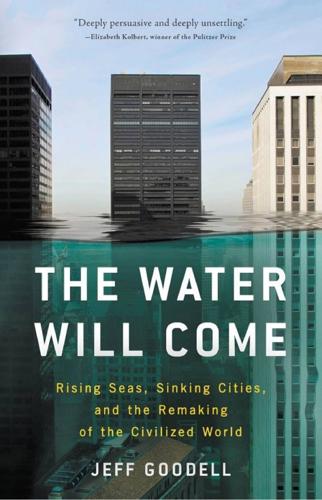
The Water Will Come: Rising Seas, Sinking Cities, and the Remaking of the Civilized World
by
Jeff Goodell
Published 23 Oct 2017
When Wood made his presentation in Aspen a decade ago, very few people had heard of geoengineering. Now it is openly debated in the climate and energy world. Mainstream scientists are cautiously acknowledging that geoengineering could indeed be an important tool in the what-the-hell-do-we-do-about-climate-change toolbox. As the IPCC’s most recent report concluded, “Models consistently suggest that [solar geoengineering] would generally reduce climate differences compared to a world with elevated greenhouse gas concentrations and no [solar geoengineering].” Other scientists, including the United Kingdom’s Royal Society and the United States’ National Academy of Sciences, support further research.
…
You don’t have to be a science fiction writer to see how geoengineering—or even the threat of geoengineering—could lead to conflict and even climate wars. Of course, no one would be talking about geoengineering as a solution to sea-level rise (or anything else) if the world had gotten serious about cutting greenhouse gas emissions thirty years ago when scientists first began to raise the alarm. And just to be clear: despite what some conspiracy theorists may believe, the Illuminati are not spraying particles into the atmosphere right now. Nor are any large-scale field research programs under way. Most of what we know about geoengineering comes from computer models, as well as a few modest laboratory experiments.
…
Other ideas, such as pumping billions of tons of ocean water onto Antarctica, where it would freeze and lower sea levels, or re-creating an ice-age landscape (complete with genetically engineered beasts that would be a cross between elephants and woolly mammoths) in Siberia to help reflect sunlight and keep the tundra frozen, may be provocative thought experiments, but few scientists take them seriously. Wood was a bit optimistic about the costs of a full-scale geoengineering program—David Keith, a Harvard professor who has thought deeply about how to design and implement a geoengineering program, estimates that instead of costing $100 million a year, it would cost more like $2 billion a year. If that sounds like a lot, consider that global subsidies for the fossil fuel industry are about a thousand times that ($1 trillion a year). Wood, being the technology-happy guy he is, also downplayed the risks of geoengineering during his talk at Aspen. Although reflecting away some sunlight before it hits the Earth could slow the melting of the ice sheets on the surface, it would be a very long time before this had any impact on the warming of the oceans, which is the most immediate threat to the big glaciers in West Antarctica.
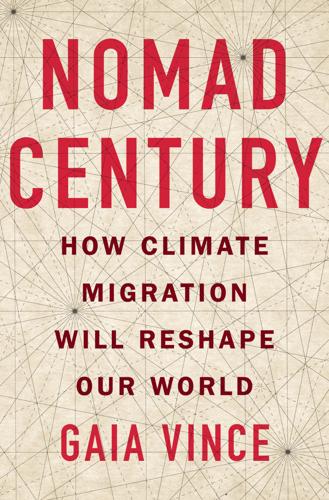
Nomad Century: How Climate Migration Will Reshape Our World
by
Gaia Vince
Published 22 Aug 2022
* * * Given what’s at stake, I’ve no doubt we will start deploying tools to reflect the sun’s heat away from Earth to maintain global temperatures at safe levels. Today, this form of geoengineering – deliberate and large-scale intervention in the Earth’s climate system – remains taboo in a way that increasing temperatures via emissions is not. Let’s be clear: planet-scale land-use change, vast atmospheric pollution, the release of massive stores of fossil carbon that heats the atmosphere and oceans … these certainly amount to geoengineering even if it is not labelled as such. In our attempts to restore the planet to a more liveable state, we should be using all the tools we have.
…
There is a Solar Radiation Management Governance Initiative, but it lacks authority and has no clear mandate.23 There are those who believe that if we take the ‘easy’ option of cooling by geoengineering, we won’t put in the same effort to reduce carbon dioxide emissions. There is certainly no shortage of emitters trying to avoid or delay decarbonization commitments using carbon offsets as a tactic, so regulators must take precautions that geoengineering is used in addition to, not instead of, emission reduction. There is also a moral queasiness from some sectors about using technology to fix the global heating caused by our ‘bad’ polluting behaviour; a puritanical zeal in insisting people drastically curb their lifestyles, for instance advocating negative growth, as a – perhaps morally better?
…
Madge, ‘Temporary exceedance of 1.5°C increasingly likely in the next five years’, Met Office website, 27 May 2021. 18. https://www.arcticiceproject.org 19. Yuanchao Fan, Jerry Tjiputra, Helene Muri, et al., ‘Solar geoengineering can alleviate climate change pressures on crop yields’, Nature Food 2:5 (2021), pp. 373–81. 20. Phoebe L. Zarnetske, Jessica Gurevitch, Janet Franklin, et al., ‘Potential ecological impacts of climate intervention by reflecting sunlight to cool Earth’, Proceedings of the National Academy of Sciences 118:15 (2021). 21. Peter Irvine, Kerry Emanuel, Jie He, et al., ‘Halving warming with idealized solar geoengineering moderates key climate hazards’, Nature Climate Change 9:4 (2019), pp. 295–9. 22.
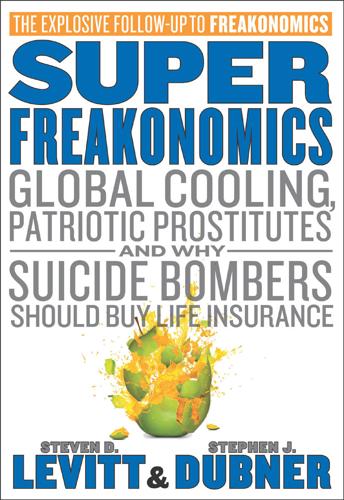
SuperFreakonomics
by
Steven D. Levitt
and
Stephen J. Dubner
Published 19 Oct 2009
But being a scientist who prefers data to dogma—even if the environmental dogma in this case lay close to his heart—Caldeira ran a climate model to test Wood’s claims. “The intent,” he says, “was to put an end to all the geoengineering talk.” He failed. As much as Caldeira disliked the concept, his model backed up Wood’s claims that geoengineering could stabilize the climate even in the face of a large spike in atmospheric carbon dioxide, and he wrote a paper saying so. Caldeira, the most reluctant geoengineer imaginable, became a convert—willing, at least, to explore the idea. Which is how it comes to pass that, more than ten years later, Caldeira, Wood, and Myhrvold—the onetime peacenik, the onetime weapons architect, and the onetime Viking fanboy—are huddled together in a former Harley-Davidson repair shop showing off their scheme to stop global warming.
…
The sulfur dioxide would eventually settle out in the polar regions but in such relatively small amounts that there, too, significant harm was unlikely. If a problem did arise, Crutzen wrote, the sulfur injection “could be stopped on short notice…which would allow the atmosphere to return to its prior state within a few years.” Another fundamental objection to geoengineering is that it intentionally alters the earth’s natural state. To that, Myhrvold has a simple answer: “We’ve already geoengineered the earth.” In just a few centuries, we will have burned up most of the fossil fuel that took 300 million years of biological accumulation to make. Compared with that, injecting a bit of sulfur into the sky seems pretty mild. As Lowell Wood points out, sulfur isn’t even the optimal chemical for a stratospheric shield.
…
Bluth et al., “Stratospheric Loading of Sulfur from Explosive Volcanic Eruptions,” Journal of Geology, 1997; Brian J. Soden et al., “Global Cooling After the Eruption of Mount Pinatubo: A Test of Climate Feedback by Water Vapor,” Science, April 2002; and T.M.L. Wigley, “A Combined Mitigation/Geoengineering Approach to Climate Stabilization,” Science, October 2006. INTELLECTUAL VENTURES AND GEOENGINEERING: This section is primarily drawn from a visit we made to the Intellectual Ventures lab in Bellevue, Washington, in early 2008, and from subsequent interviews and correspondence with Nathan Myhrvold, Ken Caldeira, Lowell Wood, John Latham, Bill Gates, Rod Hyde, Neal Stephenson, Pablos Holman, and others.

The God Species: Saving the Planet in the Age of Humans
by
Mark Lynas
Published 3 Oct 2011
Most Greens also emphatically object to geoengineering—the idea that we could consciously alter the atmosphere to counteract climate change, for example by spraying sulphates high in the stratosphere to act as a sunscreen. But the objectors seem to forget that we are already carrying out massive geoengineering every day, as a hundred million people step into their cars, a billion farmers dig their plows into the soil, and 10 million fishermen cast their nets. The difference seems to come down to one of intent: Is unwitting and bad planetary geoengineering really better than witting and good planetary geoengineering? I am not so sure.
…
This challenge is one of the most critical questions facing humanity today, because it forces us to confront the unavoidable necessity of having to manage the planet intelligently. In my view, the arguments against intentional geoengineering are strong but run the risk of amounting to a demand that we should merely stick to inadvertent geoengineering—that we should, in other words, go ahead and remove the aerosol sunshade anyway, and then just see what happens. I cannot readily accept that accidental planetary management is necessarily better than deliberate planetary management, so I think it is premature to reject geoengineering as a short-term and limited climate mitigation option. This is particularly the case given the likely cheapness and technological feasibility of adding sulfates to the stratosphere.
…
Soden et al., 2002: “Global Cooling After the Eruption of Mount Pinatubo: A Test of Climate Feedback by Water Vapor,” Science, 296, 5568, 727–730. 44. A. Robock et al., 2010: “A Test for Geoengineering?,” Science, 327, 530–1. 45. K. Trenberth and A. Dai, 2007: “Effects of Mount Pinatubo Volcanic Eruption on the Hydrological Cycle as an Analog of Geoengineering,” Geophysical Research Letters, 34, L15702. 46. O. Morton, 2007: “Climate Change: Is This What It Takes to Save the World?,” Nature, 447, 132–6. 47. But see, for example, A. Robock, 2008: “20 Reasons Why Geoengineering May Be a Bad Idea,” Bulletin of Atomic Scientists, 64, 2, 14–18. 48. Crutzen, cited above. 8: OCEAN ACIDIFICATION 1.
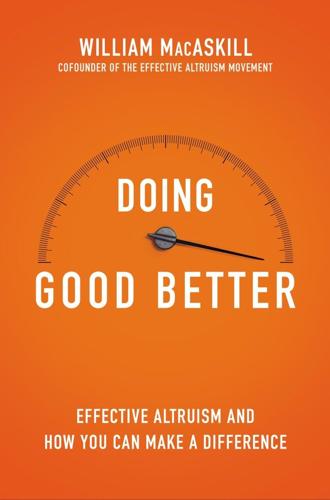
Doing Good Better: How Effective Altruism Can Help You Make a Difference
by
William MacAskill
Published 27 Jul 2015
About $11 million per year is spent on research into geoengineering (see below). Tractability: Fairly tractable. The most pressing need is to fund further research into both assessing the likelihood of worst-case scenarios and to developing strategies to reduce the chance of the worst-case scenarios. One potential opportunity is research into geoengineering, which could be used as a measure of last resort. Geoengineering is the attempt to deliberately cool the planet, for example by pumping sulfates (which are gasses that reflect sunlight and in turn cool the planet) into the stratosphere. Geoengineering itself may pose significant risks such as depletion of the ozone layer, but if it turns out we’re facing very large temperature increases, then the risks may be justified.
…
Geoengineering itself may pose significant risks such as depletion of the ozone layer, but if it turns out we’re facing very large temperature increases, then the risks may be justified. Moreover, geoengineering is cheap enough that in the future, individual countries could unilaterally undertake risky geoengineering projects. It would therefore be desirable to have a good understanding of the impacts and risks of geoengineering ahead of time. However, it may be that increased research into this area could detract from other mitigation and adaptions strategies. What promising organizations are working on this? The University of Oxford Geoengineering Programme advocates to conduct transparent and socially informed research into the social, ethical, and technical aspects of geoengineering.
…
The University of Oxford Geoengineering Programme advocates to conduct transparent and socially informed research into the social, ethical, and technical aspects of geoengineering. The Solar Radiation Management Governance Initiative provides advice on the regulation of geoengineering, seeking to ensure that research into solar radiation management (one form of geoengineering) is conducted in a responsible manner. General mitigation of climate change is also a way to reduce catastrophic risk, so Cool Earth and ClimateWorks, previously mentioned, are also promising charities in this area. Other global catastrophic risks What’s the problem? There are a number of low-probability risks that could have disastrous outcomes.
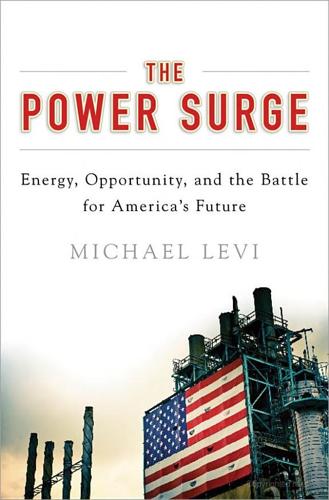
The Power Surge: Energy, Opportunity, and the Battle for America's Future
by
Michael Levi
Published 28 Apr 2013
But faced with the prospect of runaway climate change, geoengineering might become the preferred option. And, unlike slashing global emissions, it could be done by any one country that decided it made sense.29 Yet people would be wrong to conclude that a combination of fossil fuels and geoengineering could deliver a safe climate while avoiding any need for cleaner energy technologies. Scientists who study geoengineering consistently come to the same conclusion: the more greenhouse gases the world pumps into the atmosphere, the more geoengineering the world will need, and the more risk of unpleasant side effects the world will incur.
…
Scientists who study geoengineering consistently come to the same conclusion: the more greenhouse gases the world pumps into the atmosphere, the more geoengineering the world will need, and the more risk of unpleasant side effects the world will incur. Even worse, the simultaneous pursuit of endless fossil-fuel combustion and ever greater geoengineering could create a dangerously brittle system: if geoengineering were ever stopped, the planet’s temperature would quickly skyrocket, with potential 194 • THE POWER SURGE consequences far worse than what would have occurred had geoengineering not been pursued in the first place.30 All of this makes slicing emissions almost as valuable even if geoengineering is pursued. Moreover, no one knows precisely what the climate dangers out there are. There is a genuine chance that efforts to cut emissions will be too late to make a decisive difference, but there is also ample possibility that they will be enough.
…
Congressional Budget Office, “The Budget and Economic Outlook: Fiscal Years 2012 to 2022,” Washington, D.C., January 2012. 25 . Gretchen Weber, “Concerns Abound as Geoengineering Conference Opens,” Climate Watch, March 21, 2010, http://blogs.kqed. org/climatewatch/2010/03/21/concerns-abound-as-geoengineering-conference-opens/. 26. Bjorn Lomborg, Cool It: The Skeptical Environmentalist’s Guide to Global Warming (New York: Knopf Doubleday, 2008). 27. For a summary, see Jay Michaelson, “Geoengineering: A Climate Change Manhattan Project,” Stanford Environmental Law Journal 17, no. 1 (1998); Alan Robock, “20 Reasons Why Geoengineering May Be a Bad Idea,” Bulletin of the Atomic Scientists 64, no. 2 (2008). 28.
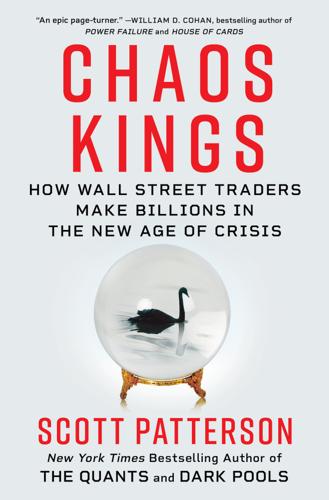
Chaos Kings: How Wall Street Traders Make Billions in the New Age of Crisis
by
Scott Patterson
Published 5 Jun 2023
If the project were halted, there’d be the possibility of sudden shock heating of the planet, causing untold chaos, damage, and death—an effect New Yorker journalist Elizabeth Kolbert described as like “opening a globe-sized oven door” in her 2021 book, Under a White Sky. Another argument against geoengineering is that it creates a stark moral hazard. If it works, there’s the chance that the costly worldwide effort to reduce carbon emissions will lose support. Is it any surprise that former ExxonMobil CEO (and Trump’s first secretary of state) Rex Tillerson thinks geoengineering is a great idea? There are also the unknown side effects, such as acid rain. What would the impact be on crops? Rainfall? Would some parts of the world suffer more? Almost certainly. Some models estimate geoengineering could eliminate or shorten the Asian monsoon season, on which two billion people depend for their food.
…
The precautionary principle would seem to warn strongly against even considering geoengineering. It’s global, systemic, and could have exponential societal and environmental ramifications and unknown ecological tipping points. Still, a number of climate scientists have been reaching the harrowing conclusion, after years of warning about the danger of global warming, that we might have no other choice. Gernot Wagner, one of the coauthors of Litterman’s EZ-Climate model, has been pushing for a reassessment of geoengineering. In his 2021 book Geoengineering: The Gamble, he wrote that when he first heard about it two decades ago, he thought it was nuts.
…
But millions will die if humanity doesn’t solve the climate problem—which is also a ruin problem. And so, with geoengineering, the question boils down to one kind of existential risk versus another. “There are risks associated with geoengineering,” Litterman told me. “But there are risks associated with warming the planet. We’ll figure it out. It’s stupid, because we didn’t have to do it.” Perhaps it’s too late, he said. Perhaps we have no choice but to roll the dice—the risk is exploding, fast. Rupert Read, for his part, argues that geoengineering is a bad bet made in bad faith. In his view, it’s a way to avoid facing up to the reality of pending climate catastrophes.
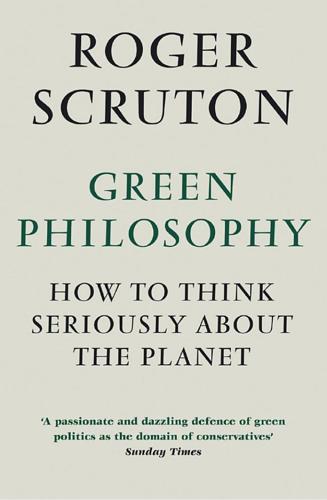
Green Philosophy: How to Think Seriously About the Planet
by
Roger Scruton
Published 30 Apr 2014
For advocates of this kind of geo-engineering see Singer, S. Fred; Starr, C.; Revelle, R., ‘What To Do About Greenhouse Warming: Look Before You Leap’, Cosmos, 1991, pp. 28–33. John Latham, ‘Amelioration of global warming by controlled enhancement of the albedo and longevity of low-level maritime clouds’, Atmospheric Science Letters, 2002, pp. 52–8. 78 See Robock’s testimony on geo-engineering to the House Committee on Science and Technology, Nov. 5th 2009, available on the Rutgers website at http://www.csp.rutgers.edu/csp-posts/archives/77. 79 See Dale Jamieson, ‘The Ethics of Geo-Engineering’, People and Place, 1.2, 13 May 2009.
…
Some scientists have suggested that we can explain the apparent constancy of global surface temperature between 1998 and 2008 by the presence of such factors, and notably by the large amounts of sulphate aerosols released from the coal-fired power stations of China.77 To use these facts as a basis for geo-engineering naturally raises problems of its own, and the suggestion has been the target of serious criticism, notably by the climatologist Alan Robock at Rutgers University.78 And it is surely true that, in our current state of ignorance, we cannot be certain of the side effects. Nevertheless the suggestion deserves serious consideration, not least because it promises to buy time, during which the search for clean energy might be brought to a successful conclusion. Geo-engineering of that kind is often dismissed out of hand – even with a measure of indignation.79 For it seems to be letting us off the hook too easily, allowing us not merely to go on producing greenhouse gases but to add to our sins by producing something else as an antidote.
…
Nevertheless, it is, in the circumstances, singularly unhelpful to warn against impending catastrophe while denouncing the most viable-seeming defence against it. There is evidence that certain kinds of geo-engineering are likely to be many times more cost effective than emission controls, with the added advantage that their effect will be manifest immediately, and not after years or decades – during which the climate may reach one of the ‘tipping points’ that the alarmists fear.80 At the very least, we should be researching this option, if only as ‘Plan B’. Moreover, some forms of geo-engineering – carbon sequestration from the atmosphere, for example – will simply undo the damage, rather than adding a new form of damage to the old.

On the Future: Prospects for Humanity
by
Martin J. Rees
Published 14 Oct 2018
This could involve a ‘plan B’—being fatalistic about continuing dependence on fossil fuels but combating the effects of releasing CO2 into the atmosphere via a massive investment in carbon capture and storage at all fossil-fuel-powered power stations. More controversially, the climate could be actively controlled by geoengineering.20 The ‘greenhouse warming’ could be counteracted by (for instance) putting reflecting aerosols in the upper atmosphere, or even vast sunshades in space. It seems feasible to throw enough material into the stratosphere to change the world’s climate—indeed, what is scary is that this might be within the resources of a single nation, or perhaps even a single corporation. The political problems of such geoengineering may be overwhelming. There could be unintended side effects. Moreover, the warming would return with a vengeance if the countermeasures were ever discontinued, and other consequences of rising CO2 levels (especially the deleterious effects of ocean acidification) would be unchecked.
…
(Note, however, that a different kind of remedy—direct extraction of CO2 from the atmosphere—wouldn’t arouse disquiet. This doesn’t now seem economically feasible, but it is unobjectionable because it would merely be undoing the geoengineering that humans have already perpetrated through burning fossil fuels.) Despite its unappealing features, geoengineering is worth exploring to clarify which options make sense and perhaps quench undue optimism about a technical ‘quick fix’ for our climate. It would also be wise to sort out the complex governance issues raised—and to ensure that these are clarified before climate change becomes so serious that there is pressure for urgent action.
…
‘Cuba’s 100-Year Plan for Climate Change’, Science 359 (2018): 144–45. 19. In the United Kingdom the case for the circular economy has gained traction through the advocacy of a widely admired high-profile figure, the around-the-world sailor Ellen MacArthur. 20. An excellent survey of geoengineering is Oliver Morton, The Planet Remade: How Geoengineering Could Change the World (Princeton: NJ: Princeton University Press, 2016). CHAPTER 2. HUMANITY’S FUTURE ON EARTH 1. Robert Boyle’s archives, and this document in particular, are discussed by Felicity Henderson in a 2010 Royal Society Report. 2. This list can be found online at https://www.telegraph.co.uk/news/uknews/7798201/Robert-Boyles-Wish-list.html. 3.
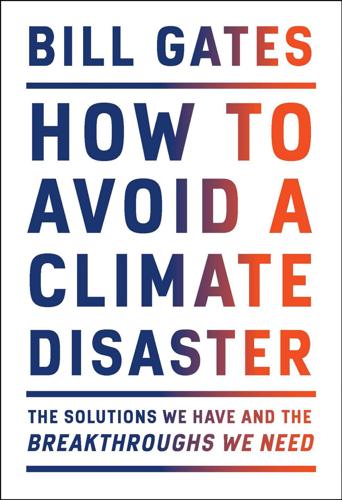
How to Avoid a Climate Disaster: The Solutions We Have and the Breakthroughs We Need
by
Bill Gates
Published 16 Feb 2021
Some critics attack geoengineering as a massive experiment on the planet, though as the proponents of geoengineering point out, we’re already running a massive experiment on the planet by emitting huge amounts of greenhouse gases. What’s fair to say is that we need to better understand the potential impact of geoengineering at a local level. That’s a legitimate concern that deserves much more study before we even consider testing geoengineering at scale in the real world. Also, because the atmosphere is literally a global concern, no single nation could decide to try geoengineering on its own. We’d need some consensus.
…
If it starts looking as if we’re headed toward one of these tipping points, you’re going to hear more about a set of bold—some would say crazy—ideas that fall under the umbrella term “geoengineering.” These approaches are unproven, and they raise thorny ethical issues. But they’re worth studying and debating while we still have the luxury of study and debate. Geoengineering is a cutting-edge, “Break Glass in Case of Emergency” kind of tool. The basic idea is to make temporary changes in the earth’s oceans or atmosphere that lower the planet’s temperature. These changes wouldn’t be intended to absolve us of the responsibility to reduce emissions; they’d just buy us time to get our act together. For a few years, I’ve been funding some studies on geoengineering (this funding is tiny compared with the work on mitigation and adaptation that I’m supporting).
…
Scientists know that these particles would scatter sunlight and cause cooling, because they’ve watched it happen: When an especially powerful volcano erupts, it spews out a similar type of particle and measurably drives down the global temperature. Another approach to geoengineering involves brightening clouds. Because sunlight is scattered by the tops of clouds, we could scatter more sunlight and cool the earth by making the clouds brighter, using a salt spray that causes clouds to scatter more light. And it wouldn’t take a dramatic increase; to get the 1 percent reduction, we’d only need to brighten clouds that cover 10 percent of the earth’s area by 10 percent. There are other approaches to geoengineering; they all have three things in common. One, they’re relatively cheap compared with the scale of the problem, requiring up-front capital costs of less than $10 billion and minimal operating expenses.
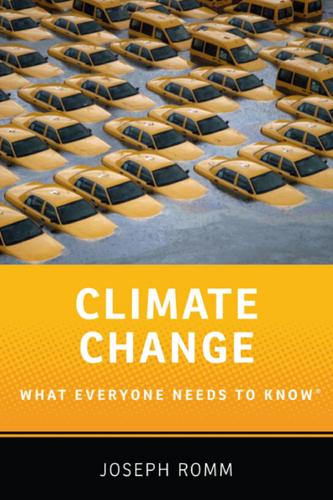
Climate Change
by
Joseph Romm
Published 3 Dec 2015
If we go beyond 4°C, we move into an unrecognizable world where we will need a different word entirely than “adaptation.” What is geoengineering and can it play a major role in reducing the impact of climate change? Geoengineering is not a well-defined scientific term. The broader definition is, “the large-scale manipulation of the Earth and its biosphere to attempt to counteract the effects of human-caused global warming.” The term is so ill-defined and potentially misleading that the U.S. National Academy of Sciences decided to reject the term “geoengineering” entirely and split its comprehensive peer-reviewed 2015 report on the subject into two: a 235-page report on “Carbon Dioxide Removal and Reliable Sequestration” and a 141-page report on “Reflecting Sunlight.”
…
There is significant potential for unanticipated, unmanageable, and regrettable consequences in multiple human dimensions from albedo modification at climate altering scales, including political, social, legal, economic, and ethical dimensions. The Academy does endorse a program of mostly basic research into albedo modification in order to better “understand” it. That said, leading experts explained in the journal Science in 2010, “Stratospheric geoengineering cannot be tested in the atmosphere without full-scale implementation.” In the article, “A Test for Geoengineering?”, researchers explained that “weather and climate variability preclude observation of the climate response without a large, decade-long forcing. Such full-scale implementation could disrupt food production on a large scale”—for two billion people.
…
Why did scientists and governments decide 2°C (3.6°F) was the limit beyond which climate change becomes “dangerous” to humanity? What kind of greenhouse gas emissions reductions are needed to achieve a 2°C target? What would the economic cost of meeting the 2°C target be? What happens if we miss the 2°C target? Can we adapt to human-caused climate change? What is geoengineering and can it play a major role in reducing the impact of climate change? 5 Climate Politics and Policies What climate policies are governments around the world using to fight climate change? What is a carbon tax? What are cap-and-trade and carbon trading? What is China doing to restrict carbon dioxide emissions?
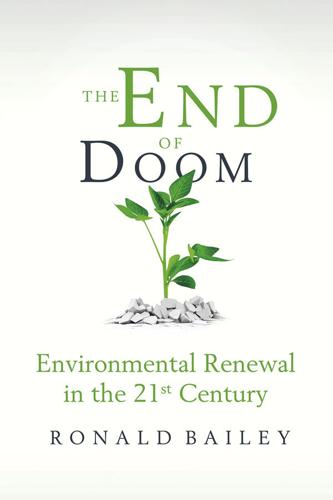
The End of Doom: Environmental Renewal in the Twenty-First Century
by
Ronald Bailey
Published 20 Jul 2015
One suspects that the biggest risk that opponents fear is that geoengineering might actually work well. “If humans perceive an easy technological fix to global warming that allows for ‘business as usual,’ gathering the national (particularly in the United States and China) and international will to change consumption patterns and energy infrastructure will be even more difficult,” observed Rutgers University environmental scientist Alan Robock. Should global temperatures take off steeply, deploying any geoengineering plan would be rife with international political difficulties. For example, the novel climate created by geoengineering would likely shift rainfall patterns, with significant differential impacts on the agricultural sectors of various countries.
…
“Prudence demands that we consider”: Ken Caldeira, “We Should Plan for the Worst-Case Climate Scenario.” The Bulletin of the Atomic Scientists, July 29, 2008, thebulletin.org/has-time-come-geoengineering/we-should-plan-worst-case-climate-scenario. The National Academy of Sciences: Committee on Geoengineering Climate: National Research Council, Climate Intervention: Reflecting Sunlight to Cool the Earth, February 2015, National Academy of Sciences Press, 234 pp. www.nap.edu/catalog/18988/climate-intervention-reflecting-sunlight-to-cool-earth; and Committee on Geoengineering Climate: National Research Council, Climate Intervention: Carbon Dioxide Removal and Reliable Sequestration, National Academy of Science Press, February 2015, 140 pp. www.nap.edu.
…
An Emergency Backup Plan to Cool the Planet Say that the world has adopted measures that will lead to the massive deployment of low- and no-carbon energy technologies, but it turns out that global warming starts to occur at a much faster pace than climate models had projected. To prepare for just such a situation, some researchers have suggested various geoengineering techniques that could be deployed to slow the rise in temperatures until the low-carbon economy can take hold. “Prudence demands that we consider what we might do if cuts in carbon dioxide emissions prove too little or too late to avoid unacceptable climate damage,” asserted climatologist Ken Caldeira in a 2008 roundtable on geoengineering in The Bulletin of the Atomic Scientists. What should we do? “We need a climate engineering research and development plan,” declared Caldeira.

The Uninhabitable Earth: Life After Warming
by
David Wallace-Wells
Published 19 Feb 2019
That the poem eventually became a touchstone of free-market thinking, and a major influence on Adam Smith, is all the more remarkable given that it first gained popularity in the aftermath of the South Sea Bubble. “designer climates”: “If geoengineering worked, whose hand would be on the thermostat?” asked Alan Robock in Science, in 2008. “How could the world agree on an optimal climate?” Ten years later, his student Ben Kravitz wrote, on the Harvard geoengineering program’s blog—yes, Harvard has a geoengineering program, and yes, they have a blog—“it may be possible to meet multiple, simultaneous objectives in the climate system.” Twenty-two percent: Jakub Nowosad et al., “Global Assessment and Mapping of Changes in Mesoscale Landscapes: 1992–2015,” International Journal of Applied Earth Observation and Geoinformation (October 2018).
…
The negative effect on plant growth would entirely cancel out the positive effect on global temperature, according to another 2018 paper; in other words, at least in terms of agricultural yield, solar geoengineering would offer no net benefit at all. Once we began such a program, we could never stop. Even a brief interruption, a temporary dispersal of our red sulfur umbrella, could send the planet plunging several degrees of warming forward into a climate abyss. Which would make whatever installations were sustaining that umbrella quite vulnerable to political gamesmanship and terrorism, as its advocates themselves would acknowledge. And yet many scientists still describe geoengineering as an inevitability—it’s just so cheap, they say. Even an environmentalist billionaire, going rogue, could make it happen on their own.
…
Climatic Change 77 (2006): pp. 211–19, https://doi.org/10.1007/s10584-006-9101-y. “devil’s bargain”: Eric Holthaus, “Devil’s Bargain,” Grist, February 8, 2018, https://grist.org/article/geoengineering-climate-change-air-pollution-save-planet. millions of lives each year: This estimate of deaths from air pollution comes from the World Health Organization. tens of thousands of additional premature deaths: Sebastian D. Eastham et al., “Quantifying the Impact of Sulfate Geoengineering on Mortality from Air Quality and UV-B Exposure,” Atmospheric Environment 187 (August 2018): pp. 424–34, https://doi.org/10.1016/j.atmosenv.2018.05.047.
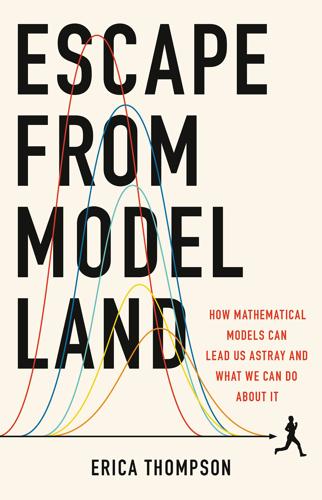
Escape From Model Land: How Mathematical Models Can Lead Us Astray and What We Can Do About It
by
Erica Thompson
Published 6 Dec 2022
Moral hazard is here reinforced by model hazard: as soon as solar radiation management geoengineering is programmed in to any of the Integrated Assessment Models, it will immediately become a go-to technology and a key pillar of the climate policy pathways that are deemed to be politically and economically feasible. Unfortunately, in purely financial terms, a very basic implementation of stratospheric aerosol geoengineering would be relatively cheap and therefore highly attractive in cost-optimising models. If the target of climate policy remains couched in the terms of global average temperature, then stratospheric aerosol geoengineering seems to me to be now an almost unavoidable consequence and its inclusion in Integrated Assessment Models will happen in parallel with the political shift to acceptability.
…
If the target of climate policy remains couched in the terms of global average temperature, then stratospheric aerosol geoengineering seems to me to be now an almost unavoidable consequence and its inclusion in Integrated Assessment Models will happen in parallel with the political shift to acceptability. As I write this, geoengineering is still a somewhat politically and socially unacceptable concept, and therefore it is not in the models despite being a technical possibility. But as the effects and impacts of climate change become more visible and more immediate, the realisation that greenhouse gas emissions have already dangerously geoengineered our planet may make the prospect of deliberate intervention more palatable. Geoengineering is increasingly featuring in near-future climate fiction by bestselling authors like Kim Stanley Robinson and Neal Stephenson, and Integrated Assessment Models are essentially just a mathematical version of near-future climate fiction.
…
Working our way through the chain of consequences, we are now seeing that global temperatures continue to rise, so the plausible next step in this depressing series is the replacement of carbon dioxide removal with ‘geoengineering’ by solar radiation management – usually meaning a large-scale project of spraying aerosols into the upper atmosphere to cool the Earth by reflecting sunlight. Again, this is set out by McLaren and Markusson: If politicians continue to demand scenarios that deliver 1.5C or even 2C as carbon budgets are consumed, it seems highly likely that modellers will have little choice but to include [geoengineering by solar radiation management] in the next generation of models. All of these can-opener technologies contain a problem of ‘moral hazard’ – the difficulty that once there is perceived to be a quick fix, less effort is put into actually solving the root problem.

The Climate Book: The Facts and the Solutions
by
Greta Thunberg
Published 14 Feb 2023
. / Resilient, biodiverse forests should be left alone and considered a ‘bridging technology’ – buying time for other sectors to decarbonize. 4.8 What about Geoengineering? Niclas Hällström, Jennie C. Stephens and Isak Stoddard ‘Geoengineering’ is the intentional technological manipulation of the Earth’s atmosphere and ecosystems at scales so large that it would interfere with and alter global climate systems. Most geoengineering technologies are still only speculative ideas, yet they are extremely controversial. Geoengineering is not intended to reduce production of fossil fuels or emissions of greenhouse gases, the root causes of global warming.
…
Around the world, there are growing calls for an immediate international ban on the advancement of solar geoengineering technology (see www.solargeoeng.org), and many are working to strengthen the existing geoengineering moratorium under the UN Convention on Biological Diversity. Attempts to advance real-world research and experimentation on solar geoengineering are consistently met with fierce resistance from Indigenous peoples, scientists and civil society organizations, who warn that humanity must not head down the slippery slope of normalization (see www.stopsolargeo.org and www.geoengineeringmonitor.org). Attempts at repackaging the contested term ‘geoengineering’ into new, less tarnished terms, such as ‘climate intervention’, ‘climate repair’ and ‘climate protection technologies’, shows the ways in which certain actors are attempting to obfuscate the discourse around these controversial technologies.
…
Attempts at repackaging the contested term ‘geoengineering’ into new, less tarnished terms, such as ‘climate intervention’, ‘climate repair’ and ‘climate protection technologies’, shows the ways in which certain actors are attempting to obfuscate the discourse around these controversial technologies. All geoengineering schemes are attempts to manipulate the Earth with the same domineering mindset that got us into the climate crisis in the first place. The implications of vested interests mainstreaming the idea of geoengineering by discussing it as if it were a viable option may be as dangerous as the impacts of actually deploying geoengineering. Suggesting that geoengineering is a ‘plan B’ provides convenient excuses for the fossil fuel industry, tech billionaires and other promoters of these ideas to delay and derail the fundamental societal transformations that are urgently needed.
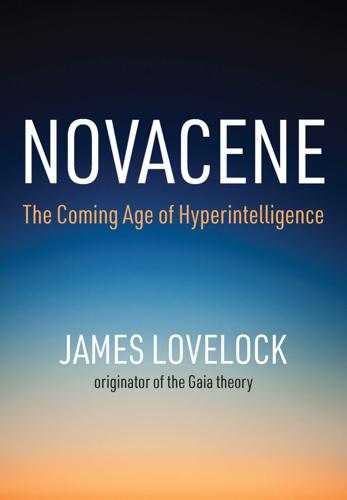
Novacene: The Coming Age of Hyperintelligence
by
James Lovelock
Published 27 Aug 2019
This idea mimics the known cooling effect of volcanic eruptions, which similarly inject sulphur gases into the stratosphere. In addition, launching a rocket to deflect an incoming asteroid also amounts to geoengineering. We could do these things now, but the cyborgs could do them better and with greater accuracy and control. Yet still there would be risks involved. Perhaps the best account yet given of the practices and drawbacks of geoengineering is in The Planet Remade: How Geoengineering Could Change the World by Oliver Morton. His analysis makes it clear that geoengineering is something we might have to use as a last-ditch measure. If we look at a future self-regulated planet from a physical viewpoint, we see that a huge cooling effect is available simply by changing the planetary albedo – the degree to which it reflects sunlight.
…
I know it is outrageous to think of pollution as good, but, on the shorter timescale of a lifetime, southern England during our brief interglacial period has been, and to some extent still is, a stunningly beautiful place. But this, too, is a product of pollution. During interglacials, carbon dioxide levels in the atmosphere rise and it is this that has provided the gentle, temperate climate of my homeland. If we look on the pre-industrial climate as a beneficial result of Gaian geo-engineering, it might seem a desirable state to go back to. But I do not think that the interglacial period represents the state preferred by Gaia. To me, the ice core record (evidence gathered by drilling down into ancient ice) suggests that the planet probably prefers a state of continuous glaciation. To put it more bluntly, Gaia prefers it cool.
…
This is why I believe the idea of a war between humans and machines or simply the extermination of us by them is highly unlikely. Not because of our imposed rules, but because of their own self-interest, they will be eager to maintain our species as collaborators. They will, of course, bring something new to the party, probably in the field of geoengineering – large-scale projects to protect or modify the environment. Such projects will be well within the capacity of electronic life. Cyborgs might be attracted to heat-reflecting mirrors in space of the kind described by the astrophysicist Lowell Wood. This would be a single, 600,000-square-mile wire-mesh structure or many smaller mirrors.

Life on the Rocks: Building a Future for Coral Reefs
by
Juli Berwald
Published 4 Apr 2022
Peter said that despite the looming reality of climate change, it wasn’t all hopeless. Technological solutions existed. These ideas were known as geoengineering. I winced again, internally, at the mention of geoengineering, which I had always thought of as a last resort, something to try when all else failed, and I was glad when one of the follow-up questions from the audience was about “unintended consequences,” pointing out that when we had tried to fix our environmental mistakes in the past, we’d often made things worse. Peter said he’d studied many different geoengineering ideas. These included shooting sulfates into the stratosphere to reflect the sun’s rays, or adding fertilizers to the ocean to stimulate photosynthesis, which uses up carbon dioxide.
…
Cancellation A Farewell to Ice: Peter Wadhams, A Farewell to Ice: A Report from the Arctic (New York: Oxford University Press, 2017). GO TO NOTE REFERENCE IN TEXT geoengineer our way out: Andrew Revkin, “Scientists Focused on Geoengineering Challenge the Inevitability of Multi-millennial Global Warming,” Medium, September 2, 2016, https://revkin.medium.com/geoengineering-proponents-challenge-the-inevitability-of-multi-millennial-global-warming-cef6e54b365c. GO TO NOTE REFERENCE IN TEXT high bleaching probability: Renee Cluff, “Reef Scientists on Alert for Great Barrier Reef Bleaching,” Tropic Now, February 18, 2020, https://www.tropicnow.com.au/2020/february/18/reef-scientists-on-alert-for-great-barrier-reef-bleaching.html.
…
It was about the coral’s underlying problem: the warming climate. And he was proposing an audacious idea. Dan was slated to talk about building an ecosystem-scale air conditioner to lower the temperature of the ocean around the Great Barrier Reef. The idea belonged in a field known as geoengineering. Geoengineering ideas weren’t new, but they have long been considered last-ditch efforts, ideas no one would seriously consider unless we had to. Were we at that point? I hit the registration button. 2 Crazy Ideas Driving off the tip of the peninsula that is Florida, you hit a series of small islands known as the Keys.
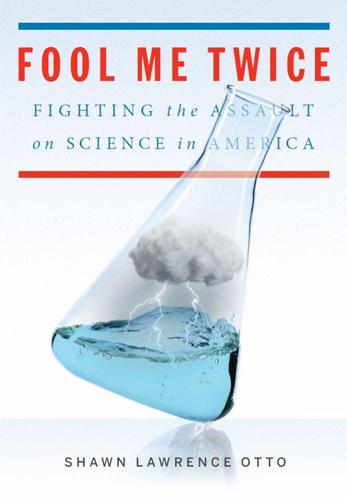
Fool Me Twice: Fighting the Assault on Science in America
by
Shawn Lawrence Otto
Published 10 Oct 2011
If we can’t get to agreement through diplomacy, what about our favorite market economics idea—privatize it? What if we give Exxon-Mobil’s geoengineering division a stake in this? Or let’s say it’s BP Geoengineering—Beyond Petroleum. It comes in and says, Look, we know you can’t agree, we’ll do a multiparty contract, monetize the whole thing, and give you a guarantee. Just sign here, problem solved. The world would, literally, be its oyster, and ultimately the corporation that supplied the world’s sulfur jones would become the dominant force on Earth. Geoengineering may seem on the surface like an idea that we should keep in our back pocket in case the real problem of carbon control can’t be solved, but it is a bit like taking up a crack habit to counter the effects of your drinking problem, and it will lead to equal ruin.
…
It could rightfully be considered the second wave in the anti-climate-change propaganda campaign, in which a counternarrative is presented to confute and divide the thinking of one’s opponents. The counternarrative in the climate wars is called “geoengineering,” and it may just be the most dangerous idea yet. Two years into his presidency, the president was briefed on ways to tackle climate change, and the report didn’t even mention carbon taxes, or cap and trade, or even reducing greenhouse-gas emissions; it recommended geoengineering—using technology to directly intervene in Earth’s climate system by spreading chemicals across millions of square miles of the Atlantic Ocean to reflect sunlight into space and force down Earth’s temperature.
…
The hole in the ozone layer worsened after the Pinatubo eruption, but it’s located over Antarctica. The problem is that a lot of the geoengineering work would have to be done in the Northern Hemisphere, since that’s where the effects of climate change are most felt. So we’d see a substantial weakening of the ozone layer there. With most of Earth’s population in this hemisphere, the rates of death from skin cancer and blindness from glaucoma would skyrocket. The third known risk—the mother of all known risks, one might say—is that once you start geoengineering, you can’t stop. If we stabilize the temperature but keep putting carbon into the atmosphere, the chemistry of the atmosphere will get more and more out of balance, and like any addict, we’ll have to keep upping our dose of sulfur to maintain the same effect.
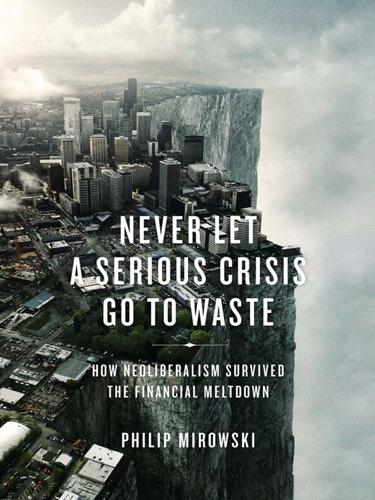
Never Let a Serious Crisis Go to Waste: How Neoliberalism Survived the Financial Meltdown
by
Philip Mirowski
Published 24 Jun 2013
It encompasses such phenomena as Earth albedo enhancement through “solar radiation management” (injecting reflective particles into the stratosphere, space mirrors, desert covering); CO2 sequestration (through ocean seeding or churning, burying biochar, introduction of special genetically modified organisms, or CO2 extraction at point of emission); and direct weather modification (hygroscopic cloud seeding, storm modification). Geoengineering has close ties to the Neoliberal Thought Collective. The American Enterprise Institute has a full-time geoengineering project, and a number of other neoliberal think tanks, such as Cato, the Hoover Institution, and the Competitive Enterprise Institute, have produced studies. Chicago School SuperFreakonomics has come out in hearty open endorsement. Of course, it might seem a bit tactless for units that have prior histories of support for climate denial now getting behind geoengineering; but that simply demonstrates that this is another component of a full-spectrum neoliberal project.
…
But as that intentional consequence becomes clear, it gets displaced by the long-game neoliberal solution. The final neoliberal fallback is geoengineering, which derives from the core neoliberal doctrine that entrepreneurs, unleashed to exploit acts of creative destruction, will eventually innovate market solutions to address dire economic problems. This is the whiz-bang futuristic science fiction side of neoliberalism, which appeals to male adolescents and Silicon Valley entrepreneurs almost as much as do the novels of Ayn Rand. Geoengineering is a portmanteau term covering a range of intentional large-scale manipulations of the earth’s climate, often proposed to counteract existing man-made climate change, such as global warming.
…
This speaks louder than any public relations claims about the nominal public-spirited character of the project: geoengineering is not really about saving the planet; it is instead mostly about laying claim to privatization of the global troposphere. Once the relevant corporations and scientists get all their legal property claims in a row, and unless environmentalists can mount some further serious obstacles, I have no doubt something like SPICE will go forward. But in the meantime, temporary failure of this or that particular geoengineering project is entirely consistent with the success of the neoliberal political project.
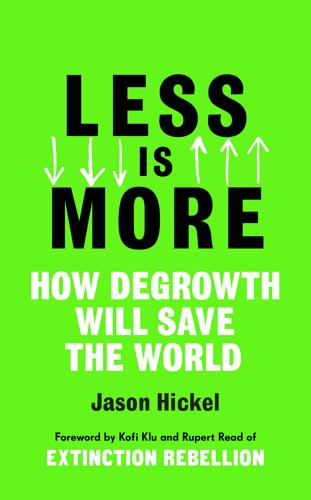
Less Is More: How Degrowth Will Save the World
by
Jason Hickel
Published 12 Aug 2020
Ecosystems would fall under tremendous strain and huge numbers of species would be wiped out.25 Scientists regard this approach to be too risky to implement, and – like all geo-engineering schemes – a dangerous distraction from the objective of cutting emissions fast. It’s worth pausing to reflect on the growing fascination with geo-engineering. What’s interesting about it is that it embodies the very same logic that got us into trouble in the first place: the idea that the living planet, rendered as mere ‘nature’, is nothing but a set of passive materials that can be subdued, conquered and controlled. Geo-engineering represents dualism taken to astonishing new extremes, unimaginable by Bacon and Descartes, where the planet itself must be bent to the will of man so that capitalist growth can continue indefinitely.
…
Geo-engineering represents dualism taken to astonishing new extremes, unimaginable by Bacon and Descartes, where the planet itself must be bent to the will of man so that capitalist growth can continue indefinitely. The fatal flaw of geo-engineering is that it seeks to solve the ecological crisis with the very same thinking – the very same hubris – that created it in the first place. But perhaps more immediately, the problem with geo-engineering is that it is ecologically incoherent. Solar radiation management is only a partial response to the crisis we face. It would do nothing to slow the pace of ocean acidification, or deforestation, or soil depletion, or mass extinction. And this brings us to the next point.
…
for a discussion. 18 World Bank, The Growing Role of Minerals and Metals for a Low-Carbon Future, 2017. 19 ‘Leading scientists set out resource challenge of meeting net zero emissions in the UK by 2050,’ Natural History Museum, 2019. 20 According to data from www.miningdataonline.com. 21 Amit Katwala, ‘The spiralling environmental cost of our lithium battery addiction,’ WIRED, 2018. 22 Jonathan Watts, ‘Environmental activist murders double in 15 years,’ Guardian, 2019. 23 Derek Abbott, ‘Limits to growth: can nuclear power supply the world’s needs?’ Bulletin of the Atomic Scientists 68(5), 2012, p. 23–32. 24 Both of these quotes come from: Kate Aronoff, ‘Inside geo-engineers’ risky plan to block out the sun,’ In These Times, 2018. 25 Trisos, C. H. et al., ‘Potentially dangerous consequences for biodiversity of solar geo-engineering implementation and termination,’ Nature Ecology & Evolution, 2018. 26 With a small number of exceptions. See Hickel and Kallis, ‘Is green growth possible?’ 27 International Resource Panel, Decoupling 2 (UN Environment Programme, 2014). 28 Guiomar, Calvo et al., ‘Decreasing ore grades in global metallic mining: A theoretical issue or a global reality?’

A New History of the Future in 100 Objects: A Fiction
by
Adrian Hon
Published 5 Oct 2020
Millions of protestors demanded a solution, and of the many that were offered–subsidized air conditioning, weather modification, mass resettlement–geoengineering seemed the only one that confronted the enormity of the problem. There had been plenty of studies examining how humans might engineer a reduction in the Earth’s temperature, with most countries favoring a “slow response mitigation” strategy of removing carbon dioxide from the atmosphere. But this strategy was very slow indeed. It was projected to take decades to make a significant impact on the climate—far too long for those who had already lost their families and friends. Faster geoengineering strategies existed, but they had all faltered due to disagreements about who should pay what and, more importantly, concerns about the deadly risks of a botched geoengineering project.
…
Faster geoengineering strategies existed, but they had all faltered due to disagreements about who should pay what and, more importantly, concerns about the deadly risks of a botched geoengineering project. The strategy India chose to revive was solar radiation management: increasing the amount of light from the sun that was reflected back into space, thereby cooling Earth. Global dimming, some called it. The crash geoengineering program of 2029 was led by India and Australia. There wasn’t time to deploy exotic concepts like a space mirror which, even if it was theoretically cheaper and safer, required brand new kinds of engineering. The two governments preferred a more down-to-earth solution that could be deployed immediately.
…
This hope of a technological solution to climate change meant that even continuous disasters—such as Hurricane Nestor, a category three storm that devastated New York in 2055, leaving much of southern Brooklyn and Queens, and lower Manhattan under water and uninhabitable for months—did not wake people up to the precariousness of the situation. Most had an ignorant or misguided faith that salvation would come, that life would not have to change too much before things got better. In fairness, surface temperatures had almost peaked by the ’50s thanks to global efforts. “We geo-engineered our way into this mess; we’ll geo-engineer our way out again,” some would say. Things didn’t get any better. They didn’t even stay the same. They got a lot worse. In July of 2058, the Canadian Space Agency issued a warning for a super-extreme melt event affecting Greenland’s ice sheet. Unfortunately, this event coincided with an unusually strong ridge of warm air.
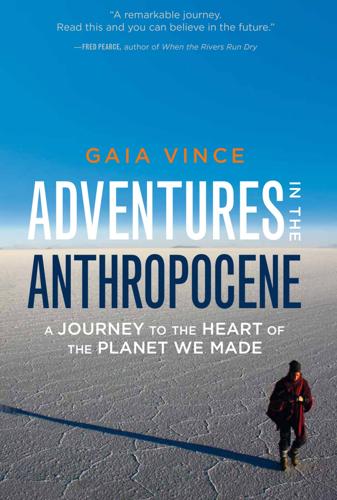
Adventures in the Anthropocene: A Journey to the Heart of the Planet We Made
by
Gaia Vince
Published 19 Oct 2014
But surely freedom of inquiry should be preserved – carrying out scientific research into whether something would work and what its consequences might be does not make a scientist an advocate for deployment, and there are scientific questions that need to be answered, such as the impact on rainfall, and whether or not it would even be technologically possible, before society can start to decide whether or not to deploy such techniques. This new, Anthropocene field of geoengineering is a fascinating area of research and the scientists working in it are some of the most remarkable and thoughtful people I’ve encountered. It is eerily reminiscent of the atomic research carried out in the 1940s – today’s geoengineers are working at the cutting edge in an exciting, entirely new science, spending their lives making discoveries and designing amazingly powerful technologies that they fervently hope will never be deployed.
…
Norphel takes a barren, high-altitude desert and turns it into a field of ice that supplies perfectly timed irrigation juice to some of the world’s poorest farmers. So far, he has built ten artificial glaciers since he retired as a government engineer in 1995, and their waters sustain some 10,000 people. It’s hard to describe what an extraordinary feat this is. In one of the most climate-change-ravaged regions, Norphel, a one-man geoengineer, has effectively conjured up water, doubling agriculture yields as assuredly as if he’d swooped in wearing a cape and stopped global warming in its tracks. In a display of energy and enthusiasm that is exhausting to witness, Norphel skips across the boulder-strewn landscape above Tashi’s village.
…
So-called ‘rock glaciers’, in which the ice sheet forms from frozen snowfall, produces a purer meltwater that is often preferred to ‘true glaciers’, which contain gathered material and melt into a milky run-off. Recreating the glaciers lost to human-produced global warming is an imaginative solution to the very real problems that alpine villagers face and, perhaps because its impact is local and grounded, this particular geoengineering technique seems uncontroversial. In richer countries, such as Switzerland, ski-resort managers already spend thousands of dollars on artificial snow and ice, and on preserving the cold stuff where it still exists, using giant reflective blankets. In 2008, a German professor constructed fifteen-metre-high, three-metre-wide wind-catching screens to channel and trap the cool winds flowing down the mountain on to the Rhône glacier in Switzerland.

The Ministry for the Future: A Novel
by
Kim Stanley Robinson
Published 5 Oct 2020
Dick: Long enough for now. Kick the can down the road a century, not bad compared to not kicking it at all. Emergency definition, in effect. Indra: This is part of why geoengineering no longer a useful word or concept. Everything people do at scale is geoengineering. Glacier slowdown, direct air capture, soil projects like 4 per 1000, they’re all geoengineering. Mary: But solar radiation management is definitely geoengineering. Indra: Sure but so what? The American heat wave has brought that one back again for sure. Indian results still debated. Claim that a double Pinatubo lowered global temperatures by three degrees for the five years following the event, a degree in the decade after that.
…
I thought we were going to be able to figure it out, but the mood in the dining hall got more and more what you might call apprehensive. Pete, this might turn out to be another fantasy solution, one of my postdocs said to me. One of those geoengineering dreams of redemption. Silver bullet fix that just shoots us in the head kind of thing. I sure hope not, I said. I like the beach. Hey, someone else said, geoengineering isn’t always just a fantasy. The Indians did that sulfur dioxide thing and that worked. Temperatures dropped for years after that. Big deal, someone else replied. It was a big deal! But it didn’t do anything to solve the bigger problem.
…
Also there were few to complain, at least in terms of locals; the total population on the coasts of the Arctic Ocean still numbered less than a million people: Inuit, Sami, Athapaskan, Inupiat, Yakut; Russian, American, Canadian, Scandinavian. The great shock of their arrival was to see that the ocean, clear of ice to the northern horizon, was yellow. Naturally this looked awful, like some vast toxic spill; in fact it was geoengineering, no doubt the most visible act of geoengineering ever, and as such widely reviled. But the solar heating of the Arctic Ocean when there was no ice covering it might be enough all by itself to tip the world irrevocably into jungle planet. All the models were in agreement on this, so the decision to try to forestall that result had been made according to Paris Agreement protocols, and the color dye released.

The Precipice: Existential Risk and the Future of Humanity
by
Toby Ord
Published 24 Mar 2020
And suppose that geoengineering fixes the climate, but produces its own 1% risk of extinction. Starting geoengineering now would be a bad idea, since its 1% risk is higher than the overall 0.05% risk. But if we only commence geoengineering if climate change turns out to be extremely severe, then geoengineering will reduce the overall risk: for we only face its 1% risk of extinction in cases where we were otherwise facing a 50% chance. This conditional geoengineering strategy would thus lower overall extinction risk from 0.05% to 0.001%. This can happen in more realistic models too. The key is waiting for a situation when the risk of using geoengineering is appreciably lower than the risk of not using it.
…
There is a broad consensus that this must play a key role in any mitigation strategy. But there are also ways of mitigating the effects of climate change after the emissions have been released. These techniques are often called geoengineering. While the name conjures up a radical and dangerous scheme for transforming our planet, the proposals in fact range from the radical to the mundane. They also differ in their cost, speed, scale, readiness and risk. The two main approaches to geoengineering are carbon dioxide removal and solar radiation management. Carbon dioxide removal strikes at the root of the problem, removing the carbon dioxide from our atmosphere and thus taking away the source of the heating.
…
It is typically cheaper than carbon dioxide removal and quicker to act, but has the downsides of ignoring other bad effects of carbon (such as ocean acidification) and requiring constant upkeep. A central problem with geoengineering is that the cure may be worse than the disease. For the very scale of what it is attempting to achieve could create a risk of massive unintended consequences over the entire Earth’s surface, possibly posing a greater existential risk than climate change itself. Geoengineering thus needs to be very carefully governed—especially when it comes to radical techniques that are cheap enough for a country or research group to implement unilaterally—and we shouldn’t rely on it as an alternative to emissions reductions.

The Heat Will Kill You First: Life and Death on a Scorched Planet
by
Jeff Goodell
Published 10 Jul 2023
When Mount Pinatubo, a volcano in the Philippines, erupted in 1991, it shot fifteen million tons of sulfur dioxide into the atmosphere and cooled the climate by about one degree for a year. A human-made geoengineering scheme would work in a similar way, and would create, to put it crudely, a thermostat knob for the Earth’s climate. “I think we have a moral obligation to take this idea seriously,” Keith told me not long after we met. “I’m not saying we should do it, but even critics who think solar geoengineering is a bad idea agree that there is no technological or scientific reason why it wouldn’t cool the planet. The big questions are, who benefits? Who suffers?”
…
There are a million reasons why this is a dangerous idea, including the fact that the particles rain out of the sky and so would have to be replenished every year or so, as well as the so-called moral hazard problem—if we can cool the planet by spraying particles into the stratosphere, why bother cutting fossil fuel pollution? Keith is hyperaware of this, and is careful to underscore that solar geoengineering (also known as solar radiation management) is not a replacement for eliminating fossil fuels, but perhaps a way to take the edge off the heat until we can reduce emissions to zero. One of the biggest concerns about solar geoengineering is how it might impact monsoons, which millions of people around the world depend on to bring water to the crops they need to survive. But the effect of dimming the sun on crops and shifting rainfall patterns is difficult to model (in fact, a number of papers have shown improved crop productivity).
…
There is also some terrible death arbitrage to calculate in any discussion about geoengineering, since adding more particles to the atmosphere will undoubtedly lead to people inhaling them. Air pollution already kills as many as ten million people each year. However, Keith argues that air pollution deaths from the added sulfur in the air would be more than offset by declines in the number of deaths from extreme heat, which would be ten to a hundred times larger. According to Keith, recent modeling of solar geoengineering suggests that the benefits would be particularly large for the poorest people in the hottest regions of the world.
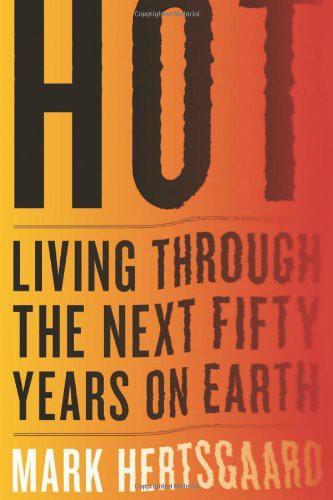
Hot: Living Through the Next Fifty Years on Earth
by
Mark Hertsgaard
Published 15 Jan 2011
Other methods for removing CO2 or nullifying its effect—often referred to as geoengineering—include deploying mirrors in space to reflect some of the sun's rays away from Earth. But such schemes are highly controversial; some scientists warn that humans don't know enough about the earth's systems to undertake geoengineering safely—they might well make a bad situation worse. "The geoengineering approaches considered so far appear to be afflicted with some combination of high costs, low leverage, and a high likelihood of serious side effects," John Holdren, President Obama's science adviser, said in April 2009. For example, some geoengineering proponents have suggested pumping large amounts of sulfur particles into the stratosphere, a higher layer of the atmosphere, just as volcanic eruptions do.
…
Invisibly small, the particles released by the eruption of Mount Pinatubo in 1991 blocked enough sunlight to stall the global rise in temperatures for the following two years. But, critics point out, Pinatubo's eruption also appears to have substantially reduced rainfall, suggesting that "major adverse effects, including drought, could arise from geoengineering solutions." White roofs are a better idea. Dubbed "geoengineering-lite" by Joseph Romm, a former U.S. assistant secretary of energy who blogs at climateprogress.org, the idea is to make roofs—and pavements—white, thus reflecting more sunlight away from the earth's surface at little or no risk. Citing research by Art Rosenfeld, the grand old man of California energy innovation, Romm reported that the average American household could counteract the ten tons of CO2 it annually emits by retrofitting one thousand square feet of roof or sidewalk with reflective surfaces.
…
Robert Watson and Mohamed El-Ashry's article on methane appeared in the Wall Street Journal of December 28, 2009. Ecoagriculture's article appeared as Chapter 3 of State of the World 2009: Into a Warming World by the Worldwatch Institute (New York: W. W. Norton, 2009). The most up-to-date discussion of geoengineering for the non-specialist reader is supplied by Jeff Goodell in How to Cool the Planet: Geoengineering and the Audacious Quest to Fix Earth's Climate (New York: Houghton Mifflin Harcourt, 2010). John Holdren's statement, uttered in May 2009, was reported by Joe Romm in a January 27, 2010, post at his Climate Progress blog; a post on January 6, 2010, describes the latest research on white roofs and pavements.

MegaThreats: Ten Dangerous Trends That Imperil Our Future, and How to Survive Them
by
Nouriel Roubini
Published 17 Oct 2022
Gernot Wagner, “Fear of Geoengineering Is Really Anxiety about Cutting Carbon,” Bloomberg, June 25, 2021, https://www.bloomberg.com/news/articles/2021-06-25/fear-of-geoengineering-is-really-anxiety-about-cutting-carbon. 40. Justin Mikulka, “3 Key Dangers of Solar Geoengineering and Why Some Critics Urge a Global Ban,” EcoWatch, December 11, 2018, https://www.ecowatch.com/solar-geoengineering-risks-climate-change-2623070339.html. 41. “Geoengineering Could Put 1bn People at Risk of Malaria: Study”, The Business Standard, May 23, 2022, https://www.tbsnews.net/bangladesh/health/geoengineering-could-put-1bn-people-risk-malaria-study-407502 42.
…
Solar power production would suffer under a white sky. And longer-term consequences are totally unknown.40 Without a breathtaking technological breakthrough, geoengineering resembles a freak-science solution to global warming. “If the prospect of injecting millions of tons of tiny artificially engineered particles into the planet’s stratosphere to create a sun shield of sorts doesn’t scare you,” says Wagner, “you haven’t been paying attention.” There is now even some scientific research that suggests that geoengineering may increase the risk of malaria for one billion people globally.41 Hope springs eternal on the greenhouse gas battlefront, but alternatives like nuclear fusion look like pipe dreams for now, even if some research progress has been made on this front.
…
To ease unfairness in combating climate change, rich countries have proposed carrots for developing countries. The 2015 Paris Agreement recommended annual transfers of $100 billion to the developing world, spare change relative to what is needed. Although these transfers look like too little too late, only a fraction of that sum has actually changed hands so far. A third option, solar geoengineering, features a friendlier price tag. It has roots in the 1991 eruption of Mount Pinatubo in the Philippines. That eruption sent a column of ash and smoke twenty-eight miles into the atmosphere. Once aloft, these aerosols, as scientists call them, deflected significant heat from the sun. Global cooling followed, lowering temperatures by 0.7 degrees C in some areas, nearly erasing a 0.8 degree increase in average global temperature since the industrial revolution began.

Blindside: How to Anticipate Forcing Events and Wild Cards in Global Politics
by
Francis Fukuyama
Published 27 Aug 2007
Another intervention that is seldom mentioned is called geo-engineering. The climate is now being modified inadvertently; geoengineering would deliberately alter the global climate. There are many different ideas about how this might be done. The most compelling method would deliberately put particles into the stratosphere that would reflect light and result in some cooling. It sounds like a fantastic idea, but it is already being done in a fashion. When power plants emit sulfur dioxide, for example, the aerosols sent into the atmosphere do cause some localized cooling. But the idea here is that geo-engineering would deliberately modify the climate on a larger scale.
…
But the idea here is that geo-engineering would deliberately modify the climate on a larger scale. Now, think about abrupt climate change. If, as will probably be the case, governments have not succeeded in mitigating the problem and are confronted with abrupt climate change, then this possible technology of geo-engineering will be important because it can cause a change in the climate much faster than mitigation can. It can be relatively inexpensive. It can be done as a big project rather than having to reduce the emissions of many different kinds of sources. However, it also introduces a new set of risks, such as ozone depletion. 2990-7 ch13 harries 152 7/23/07 12:15 PM Page 152 discussion Another problem is that global climate change would actually prove beneficial for some countries.
…
However, it also introduces a new set of risks, such as ozone depletion. 2990-7 ch13 harries 152 7/23/07 12:15 PM Page 152 discussion Another problem is that global climate change would actually prove beneficial for some countries. Imagine a situation where abrupt climate change harms one set of countries but benefits another set. This geo-engineering technology—I am thinking more than fifty years ahead—can alter the climate. If countries that are harmed by abrupt climate change use this technology, the countries that benefit will inevitably feel the affects of that choice. How does the international system operate under this new kind of arrangement? Are countries entitled and allowed to make these choices independently?
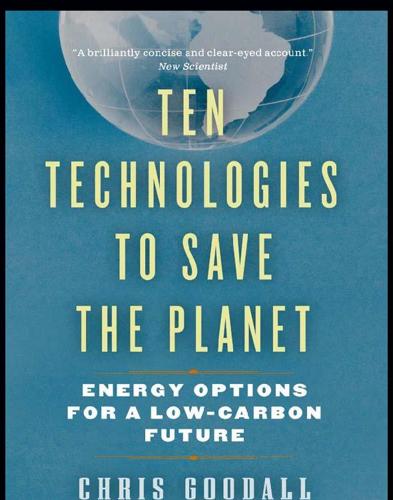
Ten Technologies to Save the Planet: Energy Options for a Low-Carbon Future
by
Chris Goodall
Published 1 Jan 2010
Reducing office electricity use should be a high priority, but rather than needing any new technology, it simply calls for proper housekeeping and intelligent purchasing of low-energy appliances. Geoengineering If all else fails, can we avert global warming by emergency techniques to remove carbon from the atmosphere or block some of the sun’s radiation reaching the earth? Some environmentalists rail against such “geoengineering” schemes, saying that they encourage the world to continue with rash and unsustainable consumption of fossil fuels. Nevertheless, rational governments and scientific institutions must carry out research into this topic.
…
The great climate scientist Wally Broecker says that our increasing greenhouse emissions are having an effect on climate analogous to poking an angry beast with a sharp stick. Geoengineering may compound the risks by poking the animal with a second stick. It is far better to reduce emissions or increase the rate of carbon capture in the soil, plants, and trees or by safe underground injection. (As we saw in Chapter 8, Broecker himself supports a scheme to chemically capture carbon dioxide from ambient air and sequester it underground, an approach that shouldn’t have any climatic side-effects.) But ruling out geoengineering entirely is surely a mistake. It is sensible contingency planning for a world that is only gradually waking up to the possible dangers of even modest further increases in atmospheric carbon dioxide levels.
…
But in the interim, after decades of minimal official interest in renewable power, Salter has switched focus. He and his colleagues are now investigating a technology to increase low-level cloud cover over the oceans. Since low clouds block the sun’s rays, Salter’s scheme might help limit global warming. This initiative is one of the ten or so “geo-engineering” projects that the more pessimistic among the scientific community are investigating in the hope of dealing with—rather than trying to avert—the consequences of the carbon dioxide buildup. This book’s epilogue looks skeptically at how we might use some of these schemes in a climate emergency.

50 Future Ideas You Really Need to Know
by
Richard Watson
Published 5 Nov 2013
ISBN 978-1-62365-195-4 Distributed in the United States and Canada by Random House Publisher Services c/o Random House, 1745 Broadway New York, NY 10019 www.quercus.com Contents Introduction POLITICS & POWER 01 Ubiquitous surveillance 02 Digital democracy 03 Cyber & drone warfare 04 Water wars 05 Wane of the West ENERGY & ENVIRONMENT 06 Resource depletion 07 Beyond fossil fuels 08 Precision agriculture 09 Population change 10 Geo-engineering THE URBAN LANDSCAPE 11 Megacities 12 Local energy networks 13 Smart cities 14 Next-generation transport 15 Extra-legal & feral slums TECHNOLOGICAL CHANGE 16 An internet of things 17 Quantum & DNA computing 18 Nanotechnology 19 Gamification 20 Artificial Intelligence HEALTH & WELL-BEING 21 Personalized genomics 22 Regenerative medicine 23 Remote monitoring 24 User-generated medicine 25 Medical data mining SOCIAL & ECONOMIC DIMENSIONS 26 Living alone 27 Dematerialization 28 Income polarization 29 What (& where) is work?
…
Expect to see water theft emerging as a major problem, with legal action being initiated by one country, or region, against another for water shortages created by cloud seeding—the artificial, or at least premature, creation of rain from water-laden clouds via the sprinkling of, typically, dry ice or silver iodine into clouds—or geo-engineering projects. Also expect to see a shift in agriculture toward less thirsty crops. Indeed, social pressure may even make the eating of certain types of foodstuffs socially unacceptable in the future—lettuce, for example, squanders what is, after all, the most precious resource on Earth. The cost of convenience In the 1970s, the American water industry was based around sales of big bottles for home and office, until Perrier stepped in.
…
the condensed idea Too many people in some places, not enough in others timeline 10,000 BC World population 1 million 1810 World population 1 billion 1930 2 billion 1950 2.4 billion 1970 3.7 billion 1980 4.4 billion 1990 5.1 billion 2000 6.1 billion 2011 7 billion 2030 8 billion 2040 8.8 billion 2050 9.1 billion 2075 9.2 billion 10 Geo-engineering The Earth’s climate is changing and it’s probably our fault. But beyond regulation, taxation and pricing, can much be done, especially on a global scale? Can we agree who’s at fault and who or what is in charge of sorting things out? Most importantly, can we get a consensus to unleash the power of science and technology to augment our Earth’s natural systems?

More Everything Forever: AI Overlords, Space Empires, and Silicon Valley's Crusade to Control the Fate of Humanity
by
Adam Becker
Published 14 Jun 2025
See also Paris Marx, “Sam Altman’s Self-Serving Vision of the Future,” Disconnect (blog), January 24, 2024, https://disconnect.blog/sam-altmans-self-serving-vision-of-the-future/. 18 John Vidal, “Bill Gates Backs Climate Scientists Lobbying for Large-Scale Geoengineering,” The Guardian, February 6, 2012, www.theguardian.com/environment/2012/feb/06/bill-gates-climate-scientists-geoengineering; Corbin Hiar and E&E News, “Solar Geoengineering Looks to Silicon Valley for New Wave of Funding,” Scientific American, February 15, 2024, www.scientificamerican.com/article/solar-geoengineering-looks-to-silicon-valley-for-new-wave-of-funding/; Chelsea Harvey and E&E News, “Geoengineering Is Not a Quick Fix for the Climate Crisis, New Analysis Shows,” Scientific American, April 3, 2023, www.scientificamerican.com/article/geoengineering-is-not-a-quick-fix-for-the-climate-crisis-new-analysis-shows/; Paris Marx, “We Don’t Need New Tech to Fight Climate Change,” Disconnect (blog), March 23, 2023, https://disconnect.blog/we-dont-need-more-tech-to-fight-climate/. 19 Mark Zuckerberg, Tyler Cowen, and Patrick Collison, “Mark Zuckerberg Interviews Patrick Collison and Tyler Cowen on the Nature and Causes of Progress (BONUS),” November 22, 2019, in Conversations with Tyler, podcast, https://conversationswithtyler.com/episodes/mark-zuckerberg-interviews-patrick-collison-and-tyler-cowen/, transcript taken from https://patrickcollison.com/static/files/progress-mz.pdf. 20 Patrick Collison and Tyler Cowen, “We Need a New Science of Progress,” The Atlantic, July 30, 2019, www.theatlantic.com/science/archive/2019/07/we-need-new-science-progress/594946/. 21 Jason Crawford, “The Roots of Progress Is Now a Nonprofit Organization,” Roots of Progress (blog), Roots of Progress Institute, August 23, 2021, https://rootsofprogress.org/nonprofit-announcement; “About,” Roots of Progress Institute, accessed June 13, 2024, https://rootsofprogress.org/about. 22 “This Is Works in Progress,” Works in Progress, accessed June 13, 2024, https://worksinprogress.co/about/. 23 Benjamin Reinhardt, “Making Energy Too Cheap to Meter,” Works in Progress, October 12, 2022, https://worksinprogress.co/issue/making-energy-too-cheap-to-meter/(emphasis his). 24 Ben Reinhardt, “About,” BenjaminReinhardt.com, accessed June 13, 2024, https://benjaminreinhardt.com/about/. 25 Reinhardt, “Making Energy.” 26 Reinhardt, interview with author. 27 Reinhardt, “Making Energy.” 28 Reinhardt interview. 29 Trang Chu Minh, “Five Facts About Unsustainable Waste Management in Singapore,” Eco-Business, January 11, 2021, www.eco-business.com/opinion/five-facts-about-unsustainable-waste-management-in-singapore/; Robin Hicks, “How Will Singapore Defuse a 16-Year Waste Timebomb?
…
You know, if you think about a system where you can say, ‘Tell me how to make a lot of clean energy cheaply,’ ‘Tell me how to efficiently capture carbon,’ and then ‘Tell me how to build a factory to do this at planetary scale’—if you can do that, you can do a lot of other things too.”16 Altman is so confident in this “plan”—solving global warming by asking a nonexistent and ill-defined AGI for three wishes—that he’s willing to gamble our climate and our future on it. “We do need way more energy in the world,” he says. “AI is going to need a lot of energy.… I still expect, unfortunately, that the world is on a path where we’re going to have to do something dramatic with climate, like geoengineering as a Band-Aid, as a stopgap.”17 Bill Gates has also long been a proponent of geoengineering as a solution to climate change, despite its massive risks.18 (It’s hardly surprising to see Altman and Gates singing the same tune, since their fortunes are aligned through OpenAI’s contract with Microsoft.) It’s a convenient idea: permission to use as much energy as your companies need, regardless of the ecological impact, in service of a higher cause that’s always just over the horizon.
…
Terraforming Mars, with all its myriad challenges, is unequivocally more difficult than solving global warming on Earth, which merely requires that we stop pumping so much carbon dioxide and other greenhouse gases into the atmosphere (and, hopefully, find good ways of removing some of what we’ve already put there). Yet humanity has proven fairly bad at addressing global warming to date. Many of the same people who want to terraform Mars would rather find ways around the need to stop burning fossil fuels by trying to “terraform” Earth instead through geoengineering. Such plans have been floated for decades; they’ve generally been rejected for the very good reason that their full effects are difficult to predict, with a significant chance of unintended consequences that could be worse than those of global warming in the first place. Even if it is possible to terraform Mars, developing the technology to do so could make it more likely that humanity will destroy itself, not less.
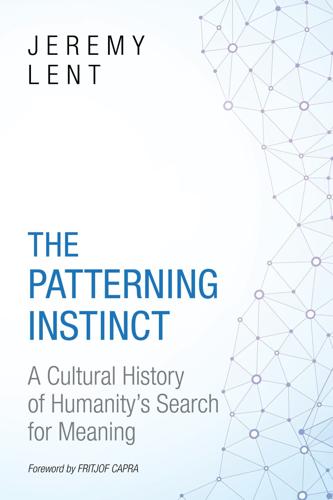
The Patterning Instinct: A Cultural History of Humanity's Search for Meaning
by
Jeremy Lent
Published 22 May 2017
They would look like natural plants except that their leaves would be black, the color of silicon, instead of green, the color of chlorophyll.”32 Engineering Our Planet What about the devastation threatened by climate change as we continue to burn through fossil fuels in endless pursuit of economic growth? Cornucopians offer a potential solution to this, too, in the form of geoengineering. Recognizing that uncontrolled carbon emissions are heating the planet with potentially catastrophic results, geoengineering proponents have proffered various global-scale proposals to counter these effects. Some schemes focus on reducing the amount of sunlight reaching the earth, floating billions of tiny strips of tinfoil in orbit around the earth to reflect the sunlight, or injecting massive amounts of sulfur dioxide into the upper atmosphere.
…
There is, also, a well-founded concern that if people believe there's an engineering solution to climate change, this would reduce the pressure to curtail use of fossil fuels and give license to continue with business as usual. Beyond these lies a deeper, philosophical concern: geoengineering is, in many ways, the ultimate realization of the root metaphors of NATURE AS MACHINE and CONQUERING NATURE that have become an integral part of modern cognition. With geoengineering, we would be turning these metaphors into our lived reality. Or is it too late anyway? Have we already come to dominate nature so extensively that our best option now is to consciously accept our role as stewards of the earth's life-support systems?
…
Humanity's dominance of Earth means that we cannot escape responsibility for managing the planet…for the foreseeable future.”35 It may seem like a relatively small step from this considered awareness of humanity's impact on the natural world to an acceptance of geoengineering in principle. Indeed, argues at least one advocate, it would be an “evasion of our ethical duties” to ignore the fact that our human activities have already affected the world to such an extent that we need to engineer a solution.36 A small step in logic, perhaps, but, to paraphrase Neil Armstrong when he walked on the moon, geoengineering would be a giant step for humankind. James Lovelock, the visionary engineer who first conceived of the earth as the self-sustaining organism he called Gaia, offers a somber prophecy for humanity.

The Stack: On Software and Sovereignty
by
Benjamin H. Bratton
Published 19 Feb 2016
Latour's unfortunate and broadly dismissive remarks on geoengineering: Bruno Latour, keynote speech (CAST Symposium: Seeing/Sounding/Sensing, MIT Media Lab, Cambridge, September 26, 2014), https://www.youtube.com/watch?v=R7hAP4wG71s. 17. The case for geoengineering is made by David Keith, A Case for Climate Engineering (Cambridge, MA: MIT Press, 2013). Nick Srncicek's review of Keith's book is at http://review31.co.uk/article/view/196/prometheanism-and-the-precautionary-principle. On the importance of preemptive international agreements governing if, when, and how geoengineering may be initiated, see David G. Victor, Global Warming Gridlock: Creating More Effective Strategies for Protecting the Planet (Cambridge: Cambridge University Press, 2011). 18.
…
For The Stack, the identification, quantification, management, visualization, and provision of energy may serve as the last instance referent of economic value, and it may in time force the evolution of a platform capable of composing and governing such a system. This in turn may put the design of the Earth layer of The Stack in the untenable position of working on behalf of the exceptional “emergencies” that most threaten the platform's coherency, such that in the decades to come, the self-amplifying logics of ecological governance demand not only geoengineering, but also incredible computational energy capture-and-distribution megastructures far beyond our current capabilities. 16. Discovering or Inventing Computation? For the relationship between computation and its terrestrial substrate, the Earth, it is never easy to separate metaphor from physics, and so for my thesis, their conceptual interrelation is perhaps just as important as their material involvements.
…
Scores of ancient geoglyphs dot landscapes on all continents, carved into the skin of the planet or assembled with rocks put in lines for the viewing benefit of aerial audiences: deities, birds, skies, and whatever else might be observing from the top of the world. Landscape is given a face.34 The advent and eventual predominance of formal agriculture permanently refixed that face's expression, helped to geoengineer the Holocene climate, and with this terraforming also brought the archaic state and urban settlement. If viewed from the sky by the geoglyphs’ audiences, agricultural megastriations might allow for a legible index of the accumulating distribution of different genres of biogovernance as distributed across the sphere; that is, different typologies of political form can be interpreted by differences in their physical landscapes viewed as geo-graphic drawings.

Why We Can't Afford the Rich
by
Andrew Sayer
Published 6 Nov 2014
The neoliberal dream is a world whose population is held to ransom by a few geoengineering companies that control the climate. Some of the projects are funded by billionaires, such as Bill Gates and Richard Branson. Branson, self-publicist and head of the Virgin group of companies, was reported to have said: ‘If we could come up with a geo-engineering answer to this problem, then Copenhagen wouldn’t be necessary. We could carry on flying our planes and driving our cars.’64 (Branson, appropriately enough, lives on an island in the Virgin Islands, avoiding UK taxes.) So banking on geoengineering also encourages complacency about our current fossil-fuel-addicted economies and lifestyles.
…
Third, there’s the long-term neoliberal solution of geoengineering. Technological optimists will always say the history of capitalism has been one of unpredicted inventions and innovations, some of them, like the internet, of vast consequence; so don’t worry, something will turn up.63 The dangers of creating unwanted side-effects by meddling with highly complex and interdependent systems of climate and the ecology, including the chemistry and life of the oceans, are huge. Nevertheless, having learnt nothing from over two centuries of imagining that we can always dominate nature, there are research projects in progress on geoengineering, and a feverish scramble for patents on technologies; the profit has to be the main thing, of course.
…
A capitalist economy in which consumption, particularly of energy, levels off and ‘enough is enough’ is an impossibility. Green growth in the rich countries of the world is a pipe dream. The idea that once we get over the financial crisis and annual compound growth resumes at 2–3% per annum we can decarbonise the economy is absurd. Carbon-capture technology is still in the experimental phase. ‘Geoengineering’ projects, such as cloud seeding or putting giant reflectors in space or fertilising the oceans to absorb more CO2 are hugely risky, and only encourage governments to stall on CO2 reduction. So is there another way out of the double crisis? Reduced consumption: sufficiency? For the rich countries at least, not growth but zero growth or even ‘de-growth’ are likely to be the only feasible ways of cutting greenhouse gases fast enough to stop runaway global warming, and that of course would mean more modest consumption, including reduced mobility, particularly for the rich and well-off.

Enlightenment Now: The Case for Reason, Science, Humanism, and Progress
by
Steven Pinker
Published 13 Feb 2018
The global burden of snakebite: A literature analysis and modelling based on regional estimates of envenoming and deaths. PLOS Medicine, 5. Keith, D. 2013. A case for climate engineering. Boston: Boston Review Books. Keith, D. 2015. Patient geoengineering. Paper presented at the Seminars About Long-Term Thinking, San Francisco. http://longnow.org/seminars/02015/feb/17/patient-geoengineering/. Keith, D., Weisenstein, D., Dykema, J., & Keutsch, F. 2016. Stratospheric solar geoengineering without ozone loss. Proceedings of the National Academy of Sciences, 113, 14910–14. Kelley, J., & Evans, M. D. R. 2016. Societal income inequality and individual subjective well-being: Results from 68 societies and over 200,000 individuals, 1981–2008.
…
Recruiting conservative and libertarian commentators who have been convinced by the evidence and are willing to share their concern would be more effective than recruiting more scientists to speak more slowly and more loudly.108 Also, the factual state of affairs should be unbundled from remedies that are freighted with symbolic political meaning. Kahan found that people are less polarized in their opinion about the very existence of anthropogenic climate change when they are reminded of the possibility that it might be mitigated by geoengineering than when they are told that it calls for stringent controls on emissions.109 (This does not, of course, mean that geoengineering itself need be advocated as the primary solution.) Depoliticizing an issue can lead to real action. Kahan helped a compact of Florida businesspeople, politicians, and resident associations, many of them Republican, agree to a plan to adapt to rising sea levels that threatened coastal roads and freshwater supplies.
…
And to reduce the amount of carbon that returns to the atmosphere when dead plants rot, we could encourage building with wood and other plant products, or cook the biomass into non-rotting charcoal and bury it as a soil amendment called biochar.96 Other ideas for carbon capture span a broad range of flakiness, at least by the standards of current technology. The more speculative end shades into geoengineering, and includes plans to disperse pulverized rock that takes up CO2 as it weathers, to add alkali to clouds or the oceans to dissolve more CO2 in water, and to fertilize the ocean with iron to accelerate photosynthesis by plankton.97 The more proven end consists of technologies that can scrub CO2 from the smokestacks of fossil fuel plants and pump it into nooks and crannies in the earth’s crust.

Everyday Utopia: What 2,000 Years of Wild Experiments Can Teach Us About the Good Life
by
Kristen R. Ghodsee
Published 16 May 2023
Alix Kates Shulman, freely available at the Anarchist Library, https://www.theanarchistlibrary.org/library/emma-goldman-socialism-caught-in-the-political-trap. 8 Karl Mannheim, Ideology and Utopia: An Introduction to the Sociology of Knowledge (1936; New York: Martin, 2015): 341–43. 9 William Samuelson and Richard Zeckhauser, “Status Quo Bias in Decision-Making,” Journal of Risk and Uncertainty 1, no. 1 (February 1988): 7–59. 10 Daniel Kahneman and Amos Tversky, “The Psychology of Preferences,” Scientific American 246, no. 1 (January 1982): 160–73. 11 Scott Timberg, “The Novel That Predicted Portland,” New York Times, December 12, 2008, https://www.nytimes.com/2008/12/14/fashion/14ecotopia.html. 12 Mannheim, Ideology and Utopia, 232–33. 13 Thomas Piketty, Capital in the 21st Century (Cambridge, MA: Harvard University Press, 2013). 14 Rutger Bregman, Utopia for Realists: How We can Build the Ideal World (New York: Little, Brown, 2017). 15 Wade Davis, “Keynote Speech: The Ethnosphere and the Academy,” 2014, https://www.wheretherebedragons.com/wp-content/uploads/2014/09/DavisEthnosphereAcademy.pdf. 16 For the full text and a video of the 1997 Apple “Think Different” ad, see: http://www.thecrazyones.it/spot-en.html. 17 See the website of the Center for Climate Repair at Cambridge University: https://www.climaterepair.cam.ac.uk. 18 Fred Pearce, “Geoengineer the Planet? More Scientists Now Say It Must Be an Option,” YaleEnviroment360, May 29, 2019, https://www.e360.yale.edu/features/geoengineer-the-planet-more-scientists-now-say-it-must-be-an-option; Pallab Ghosh, “Climate Change: Scientists Test Radical Ways to Fix Earth’s Climate,” BBC News, May 10, 2018, https://www.bbc.com/news/science-environment-48069663. 19 See the website for the Coalition for the Radical Life Extension: https://www.rlecoalition.com/about. 20 See the website for the International Society for Artificial Life: https://www.alife.org. 21 Maddy Savage, “Why Do Women Still Change Their Names?”
…
Because the people who are crazy enough to think they can change the world, are the ones who do.”16 It was an explicitly optimistic commercial message about the transformative power of utopian thinking…. So why limit such thinking to designing better Apple products? In academia, blue sky thinking underpins the discipline of geoengineering—scientists who hope to hack the earth’s weather systems in order to prevent the deleterious effects of climate change.17 The Cambridge University Center for Climate Repair suggests ocean greening, recycling CO2, refreezing the polar ice caps, and spraying aerosols of sulphate particles into the stratosphere to prevent solar radiation from reaching the planet.18 In Silicon Valley, a new breed of extreme dreamers, such as the Coalition for Radical Life Extension, is experimenting with ways to achieve human immortality.19 And those who study artificial life (in its hard, soft, and wet forms) push the boundaries of their imaginations to understand how sentience might evolve from complex systems.20 In the technology sector, entrepreneurs reap rewards when they “move fast and break things,” no matter what the costs to society as a whole.
…
In a society with less precarity and with resources more equitably distributed, we will worry less about hustling to make sure we have a bigger slice of the pie than those around us. But it works the other way, too. If we lived in wider networks of people who shared their resources, we would become less precarious. Both processes are interdependent. It may be that we will geoengineer our way out of the climate crisis, and that one day we will all share unlimited, free solar power; enjoy universal basic incomes funded by our collective ownership of the robots and algorithms that will do most necessary labor; and live in real democratic societies where “material needs no longer exist,” but none of that is possible without fundamentally rethinking the basis upon which we organize our intimate lives to free us from selfish individualism.41 Domestic transformation is therefore a key node—if not the key node—of resistance and reinvention.
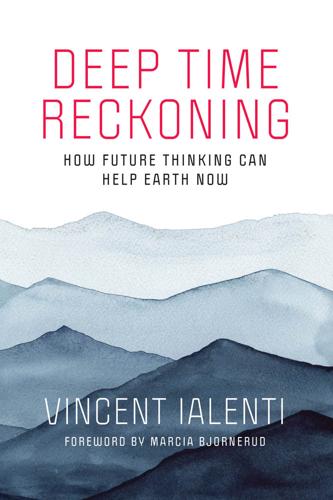
Deep Time Reckoning: How Future Thinking Can Help Earth Now
by
Vincent Ialenti
Published 22 Sep 2020
As mundane as the Safety Case experts’ office lives were, their optimism about human ingenuity’s power to secure better ecological tomorrows never ceased to shine through. Theirs was a more cautious, measured, reserved techno-optimism than that of, say, proposals to fix Anthropocene problems using geoengineering. Geoengineering proposals have included plans to put fertilizers into oceans to raise their carbon dioxide uptake, or to pump reflective particles into the atmosphere to deflect sunlight.50 Most Safety Case informants were eager to protect the Earth from radiological hazards, but were more skeptical of humanity’s environmental impacts overall.
…
Existential risk A severe future risk that could destroy global human flourishing, cripple civilizational progress, trigger human extinction, or end life on Earth. Examples include pandemic disease, a supervolcano eruption, a total nuclear war, a large asteroid impact, or a hostile insurrection of artificially intelligent machines. Geoengineering A term for proposals to technologically manipulate our planetary environment in order to strategically reduce the effects of climate change. Examples include proposals to pour fertilizers into the Earth’s oceans to raise their carbon dioxide uptake, or to pump reflective particles into the Earth’s atmosphere to deflect sunlight.
…
See also Deflation of expertise; Safety Case guarded enthusiasm for expertise, 36–40 Safety Case, 4–5, 12–13, 72–73, 107–108 and trust in technocrats, 31–36 Facilia AB, 19, 72 “Fake news,” 28 Fall of the Faculty, The (Ginsburg), 28 Farrier, David, 66 Fennovoima, 10, 100–101 Finnish Energy Industries, 10 Finnish Environmental Institute, 36 Finnish Meteorological Institute, 36 Finnish Research Programme on Nuclear Power Plant Safety (SAFIR), 73 Finnish Research Programme on Nuclear Waste Management (KYT), 10, 20, 72, 73 Finnish Society of Bioart, 2 Finns and Finland, x-xi, 9 Atomic Energy Act (1957), 21 and expertise, 30 Government Decree 736/2008, 21 Linkomies Committee, 31 Ministry of Economic Affairs and Employment, 11, 12, 34, 56 Ministry of Foreign Affairs, 32 Nuclear Energy Act (1987), 11, 21 Nuclear Energy Decree (1988), 21 nuclear waste in, 3–4 Parliament (Eduskanta), 10 Radiation Act (1991), 21 State Nuclear Waste Management Fund, 11, 19 and technocrats, 31–36 Footprints: In Search of Future Fossils (Farrier), 66 Forest analogy, Laura’s, 94–95, 98, 101, 102, 105–106, 110, 116, 120 Fortum, 10, 11, 20, 100 Francis (Pope), 109, 148 Freud, Sigmund, 16, 17 Friends of the Earth, 10 Fukushima meltdown, 27, 32 Futility, 87–89, 152 Future of Humanity Institute (Oxford), 3 Future of Life Institute, 148 Future, Secretary of the, 151 Future Sister Cities, 150 “Future Will Be Terrible, The” (exercise), 151 Galison, Peter, 23 Garfield Conservatory Fern Room (Chicago), 62 Geoengineering, 59 Geo-history, 15 Geological change, humans as agents of, 16 Geological Survey of Finland (GTK), 10, 35 George Washington University, 62 Ginsburg, Benjamin, 28 Global Deep Time Reckoning Information Repository, 154, 158–159 Gould, Stephen Jay, 3, 17 Graeber, David, 29, 151 Great Acceleration, and the Anthropocene, 15 Greenland Analogue Project, 50–51 Greenpeace, 10, 34 GTK.
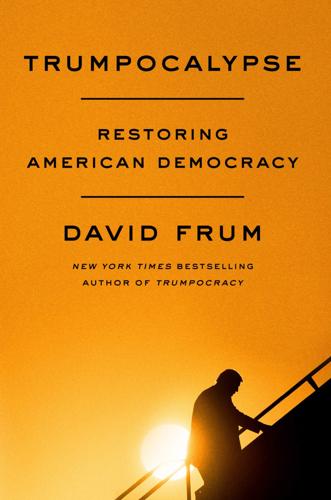
Trumpocalypse: Restoring American Democracy
by
David Frum
Published 25 May 2020
Joshua Hammer, “Is a Lack of Water to Blame for the Conflict in Syria?,” Smithsonian Magazine, June 2013, https://www.smithsonianmag.com/innovation/is-a-lack-of-water-to-blame-for-the-conflict-in-syria-72513729/. 27. Mechanism and Impacts of Geoengineering, accessed November 13, 2019, http://www.china-geoengineering.org. 28. Aditya Nalam, Govindasamy Bala, and Angshuman Modak, “Effects of Arctic Geoengineering on Precipitation in the Tropical Monsoon Regions,” Climate Dynamics 50, nos. 9 and 10 (May 2018): 3375–95, https://doi.org/10.1007/s00382-017-3810-y. 29. Jeremy Diamond, “Trump: ‘We Can’t Continue to Allow China to Rape Our Country,’” CNN, May 2, 2016, https://www.cnn.com/2016/05/01/politics/donald-trump-china-rape/index.html. 30.
…
A little more than two centuries ago, human beings learned to dig and burn this vast accumulated inheritance of ancient plants to generate power, releasing back into the atmosphere in a few decades the carbon dioxide that the planets had sucked out over geologic ages. Now we must slow, stop, and ultimately reverse this process—or else we may find that we have geoengineered a planet on which we cannot live. On the present trend, the planet will keep warming until the next century at least. The consequences of the warming are showing up much faster than expected. The European heat wave in summer 2019 melted the Greenland ice cap at a rate that was not supposed to occur until 2070.
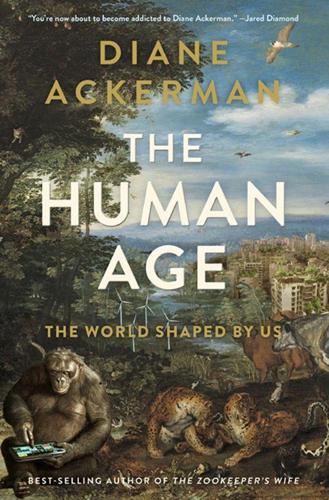
The Human Age: The World Shaped by Us
by
Diane Ackerman
Published 9 Sep 2014
Sure enough, a giant bloom of algae diatoms arose, sucking carbon dioxide from the air, and after a few weeks many diatoms carried pearls of CO2 to the bottom and died. Would it work safely on a large scale? That’s the big unknown. Geoengineering is a highly controversial plaything. We won’t know except by trying, and a bad outcome could be deadly. We’ve already been geoengineering the planet for decades, unintentionally, by saturating the air with CO2 and the oceans with fertilizer—not with good results. Geoengineering and adaptation ideas run the gamut from shucks-why-didn’t-I-think-of-that to plain nutty. The monochrome Earth method includes painting cities and roads white, covering the deserts in white plastic, and genetically engineering crops to be a paler color—all to reflect sunlight back into space.
…
San Francisco: Sierra Club Books, 1990. Blanc, Patrick. The Vertical Garden: From Nature to the City. Revised and updated ed. Trans. Gregory Bruhn. New York: W. W. Norton, 2011. Brand, Stewart. Whole Earth Discipline: Why Dense Cities, Nuclear Power, Transgenic Crops, Restored Wildlands, and Geoengineering Are Necessary. New York: Penguin, 2009. Brockman, John, ed. Culture: Leading Scientists Explore Societies, Art, Power, and Technology. New York: Harper Perennial, 2011. ———. Introduction by W. Daniel Hillis. Is the Internet Changing the Way You Think? The Net’s Impact on Our Minds and Future.
…
G., 231 bamboo, 132 Bangladesh, 51–53, 271 basil, 89, 90 Bat Bomb Project, 145 bats, 115 Bavaria, Germany, 107 Baylis, Françoise, 266 beans, 190 beavers, 135 bee balm, 125 beebots, 181 bees, 147, 166 beetles, 164, 180–81 Bell Museum of Natural History, 115 beluga whales, 135, 144 Benenson, Peter, 98 Benyus, Janine, 92 Berridge, Matt, 5–7, 25–28, 202 Bespoke Innovations, 236–37 Bhutan, 72 big agriculture, 154 Big Sur, 115 biofuels, 64 bioluminescent foliage, 83 biomimicry, 91–92 bionic fingers, 13 bionic suits, 13 bioprinting, 238, 245–46 bipolar disorder, 285 birds, 216 extinction of, 139 bird’s-foot trefoil, 166 black bears, 126 “Black Marble” photograph, 17 Blade Runner (film), 228, 253 Blanc, Patrick, 79–82, 84–85, 207 bleeding hearts, 125 Blizzard Nemo, 58 bloomers, 191 blue-jay feathers, 91 “Blue Marble” photograph, 17–18, 305 bobcats, 129 Boeing, 236 Bonassar, Lawrence, 243–52, 253 bonobos, 201–3 books, 171 Borges, Jorge Luis, 236 Borneo, 107, 132, 313 Boulogne, France, 83 Boulter, Nicky, 298–99 Bracken Cave, 145 brain, 150, 281 rewiring of, 191 scans of, 176–78 Bramel, Paula, 155 Brand, Stewart, 150 Branson, Richard, 54 Brazil, 46, 88, 123 breast milk, 301 breeding, 149–50 Breezy Point, N.Y., 45 Brittany, France, 62–63 Bronen, Robin, 48 Brooklyn Battery Tunnel, 45 Brooklyn Navy Yard, 82 Brown, Charles, 115–16 brown bears, 132 brown tree snake, 139 Budi (orangutan), 4–7, 25–26, 27, 28, 44, 122–23, 202, 269 iPad of, 4–7, 25–26, 27, 28, 71 building, heating of, 96–98 buildings, 90–94 bullfrogs, 132 burdock, 132 Burtynsky, Edward, 23–25 Bush, George W., 315 butterflies, 133, 166 Bygren, Lars Olov, 277–80 Byström, Joakim, 99 cadmium, 271 Café Trussardi, 82 California, 77, 117, 132 Callahan, Gerald N., 263 “Cambridge Declaration on Consciousness in Non-Human Animals, The,” 216 camels, 140 in war, 144, 145–46 Canada, 40, 43, 88, 124, 132, 266 Canada geese, 13, 135, 153, 194 Canadian rose, 39 Canadian War Museum, 82 cancer, 271, 316 cane beetles, 139 cane toads, 139 canning, 318 canola rapeseed, 153 Cape Town, South Africa, 78 carbon blade legs, 13 Carbon Capture Storage, 54 carbon dioxide, carbon dioxide levels, 34, 53 and acidification of oceans, 66 kelp’s ingestion of, 64 methods for pulling from air, 54 recent rise in, 36 Swedish lowering of, 99 urban gardens and, 74, 80 Carpenter, Rollo, 227 carpets, 87 cars, 87, 171, 191 cartilage, 244, 251 Case, Amber, 262 cats, 140, 146, 298 parasites of, 296–97 cattle, 194–95 Center for Nano Science and Technology, 183 Centers for Disease Control and Prevention, 298 Central Park, 78 Central Station, 96, 101 cerebral palsy, 253 Cerf, Vent, 202–4 Chamonix, France, 314 chatbots, 226–31 cheetahs, 132 chemputer, 237 Cher Ami (pigeon), 144–45 cherry tomatoes, 90 Chicago, Ill., 77, 78, 117 Chicago Botanic Gardens, 82 chicken coops, 88 childhood mortality, 13 Chile, 46, 99, 175 chimeras, 251, 262, 264–68 chimpanzees, 148, 216 China, 46, 88, 102, 124, 235 solar power in, 107 urban population of, 72 Chincoteague, 137–38 chipmunks, 126 chives, 90 chlorophyll, 53 chloroplasts, 291 Church, George, 151–52 cicadas, 41, 173–75 cilantro, 90 cingulate, 178 cities, 11, 13, 71–72 enviromental impact of, 72–73 growth of, 18–19, 72 limited species in, 113–14 nature vs., 112–17 population of, 72 as seen from space, 16–17, 18, 19 sky parks in, 77–78 City Hall, Chicago, 83 city parks, 83 clams, 57 Clarke, Ann, 157–67 Clarke, Bryan, 156–67 Cleverbot, 227–28 cliff swallows, 115–16 close work, 192 Clostridium difficile, 301–2 clouds, 12 coal, 21, 106 Coan, James, 178 cocaine, 298 cochlear implants, 253 cockatoos, 202 cod, 59–60 Cold War, 146 Collins, Francis, 289 colon disease, 302 Colorado, 40 compassion, 176 computers, 13, 87, 175, 187, 194, 197, 203, 211, 220, 222, 224, 226, 230, 256, 261, 270 condors, 132 consciousness, 200, 216, 217, 219, 228–29 cooking, 190 Copenhagen, 78 copper, 21 coral bells, 80–81 cordite, 153 corn, 71, 153 corncrakes, 133, 137 Cornell University, 209–25 corpus callosum, 177 cosmos, 125 cottontails, 129 cougars, 117 Council House 2 building, 94 courtly love, 190 cows, 71 coyotes, 117, 118 crabs, 138 “cradle to cradle,” 87 cranes, 124 Creative Machines Lab, 218, 223–24 creativity, 196 Crick, Francis, 274 crickets, 173–74 Cronin, Lee, 237 crops, 71 Crutzen, Paul, 9, 313 cucumbers, 89 cuneiform, 235 Curitiba, Brazil, 107 cyborg anthropology, 262 cyborg dragonflies, 146–47 cyborgs, 146–47, 251, 260, 262–63 daffodils, 125 Dakar, Senegal, 314 dandelions, 132 Dantuluri, Phani, 261 dark energy, 172 dark matter, 172 Darwin, Charles, 156, 268, 276 Dayak people, 107 day lilies, 125 deception, 219 Decker Yeadon, 92 deer, 133 Defense Advanced Research Projects Agency (DARPA), 146–47, 209, 225, 236, 256, 258–59 dengue fever, 302 Denmark, 101 depression, 196 Desertec, 106 diabetes, 301 diamondbacks, 118–19 dianthus, 125 Dietikon, Switzerland, 82 digoxin, 302 dinosaurs, 31, 154 Djairam, Dhiradj, 104, 105 DNA, 160, 263, 274–75, 278–79, 281, 282, 287 of extinct species, 151–52, 153–54, 160–63, 166–67 dodos, 163 dog roses, 132 dogs, 140, 144, 145–46, 147, 148, 149 dolphins, 147, 202, 204, 216 domestic animals, 11, 71, 140 Dominoni, Davide, 114 dopamine, 298 Dourada, Fazenda, 123 droughts, 41, 46 Duckworth, Tammy, 259, 260 dung beetles, 164 Dust Bowl, 41 Dutch Hunger Winter, 283 ears, 245–46 Earth: as seen from air, 20–21 as seen from space, 16–18, 19, 305 Earthmasters: The Dawn of the Age of Climate Engineering (Hamilton), 314 Eastgate Centre, 92, 93–94 echolocation, 147 École Polytechnique de Montréal, 181 eczema, 301 Edison, Thomas, 191, 306 Edmonton Airport, 83 education, 286 Edwards, Andres, 88 Eggerthella lenta, 302 Eggleson, Kathleen, 183–84 eggs, 160–61, 279 Eisenberger, Naomi, 177 electricity, 76, 78, 91, 97, 99, 100–103, 104, 184–87, 191, 213 electronic campfires, 193 elements, 34–35 elephants, 202, 217 underpass for, 124 in war, 144, 145–46 Ellis, Erle, 126 Eloxochitl, 112 emotions, 214, 222–23 empathy, 190, 219, 228 Energy Department, U.S., 64 England, 132 English ivy, 132 EnsnAired, 98 Environmental Protection Agency, U.S., 86–87 epigenetics, 279–86 Estonia, 77 eucalyptus, 132 Eureqa machine, 219–20, 221 European badgers, 124 Eve (robot), 221 Everglades, 129, 130, 133, 315 evolution, 208, 211, 219, 224, 251, 276–77, 279 microbes’ effects on, 292–93 extinction, 12 of birds, 139 of Miami blue butterfly, 131 orangutans and, 27–28 of Partula, 156–59 of plants, 315 and resurrection of species, 151–52, 153–54, 161–63, 208 of trilobites, 29, 30 extinctions, great, 60, 154, 305 eyeglasses, 171 factories, 71 false indigoes, 125 famine, 276, 277, 285, 286 Fantastic Voyage, 181 farming fish, 60 Faroe Islands, 78 farsightedness, 192 fecal transplants, 302 Ferrer, Miguel, 136 ferrets, 132 fertilizers, 36, 64 fiber optics, 97 field mice, 134 fighting, 190 finches, 156 Finger Lakes, 31, 131 fire ants, 132 fireflies, 181 fishermen, 56–60 fleecy electricity, 35 Flegr, Jaroslav, 297 floods, 41 Florida, 117, 131 Florida rosy wolfsnail, 157 flounder, 65 food, 7 Forbes, 235 Forbidden City, 235 Ford Motor Company, 87–88 forests, 54 fossil fuels, 10, 34, 51, 307 fossils, 9, 29–30, 31, 32, 33–34, 35, 36, 43, 57 Fountainhead, The (Rand), 59 foxes, 129, 133, 134 foxgloves, 125 France, 72, 124, 296, 298 Frankenstein (Shelley), 212–13 Franklin, Rosalind, 274 Fraser, Bill, 135 frogs, 80, 125, 131, 132 Frozen Ark, 155, 160, 163–64 frozen food, 317 fruit flies, 293–95 fungi, 289-90, 300 G8 Summit, 315 Gabriel, Peter, 201–3 Galileo Galilei, 220 Galveston, Tex., 50 Gambia, 131 gardening, hydroponic, 83 gardens, 38–39 urban, 74 vertical, 79–85 Gardens by the Bay, 78 gas, 106 Gaudi, Antoni, 236 geckos, 180 genetic mutations, 277 Genghis Khan, 272–73, 274 geoengineering, 53–54 geographic change, 11 Geological Society of London, 9 Geological Survey, U.S., 299 geothermal warmth, 95 Germany, 72, 78, 83, 101, 124, 132, 298 solar panels in, 106–7 Gershenfeld, Neil, 202–3 gestures, 26–27 giraffes, 276 global consciousness, 18 global warming, 11, 38–42, 154, 307–8 agriculture and, 56 in Bangladesh, 51–53 and development of seas, 64–65 evidence of, 108 extreme weather and, 36–43, 314 fishermen and, 56–57 gardens affected by, 38–39 habitats rearranged by, 133–40 human rights and, 48 glowworms, 144 glucocorticoids, 283 golden eagles, 132 Golden Lion Tamarin Conservation Program, 123 golden toads, 162 Golding, William, 162 Google, 192, 210 Google Glass, 260–61 gophers, 115 gorgonian, 38 grains, 71 Grand Canyon, 126 granite, 58–59 GraphExeter, 184–85, 317 grasshoppers, 173–74 Grassy Key, 131 great apes, 202 great auks, 151 Great Depression, 108 Greece, 124 Green Apple concept car, 103 Green Belt Corridor, 124 greenhouses, 90 Greenland, 42 green mussels, 131 Green over Grey, 83 growing season, 42 Guam, 139, 157 Guam rail, 139 Guatemala, 88 Gulag Archipelago (Solzhenitsyn), 218 Gurdon, John, 150, 160 Gut Erlasee Solar Park, 106–7 Guthrie, Barton, 261 habitat loss, 154 Haiyan, Typhoon, 46 Hamilton, Clive, 314 Hansen, James, 314 Hansmeyer, Michael, 236 Harvard University, 235 Hastings, Battle of, 190 heart, 150, 239, 248, 249, 250–51, 281 heat, 41 heaters, 87 heat recycling, 95–108 Helm, Barbara, 114 Henri, Pascal, 84 herbs, 89 Hernandez, Isaias, 264–65 herons, 193–94 Heuchera plants, 80–81 High Line, 77 Hitler, Adolf, 273 hockey, 40 Holocene, 9 Homer, 262 Honda, 236 Hong Sun Hye, 102 horse chestnut trees, 153 Horse Island, 58 horses, 137–38, 140, 145–46 hostas, 125 Hudson River, 54–55 hulls, 91 human genome, 13 Human Genome Project, 270, 274, 282, 285, 289, 300 Human Microbiome Project, 289 human rights, global warming and, 48 humans: as eusocial, 288 geographic expansion of, 10 geography changed by, 11 history of, 71 orangutan genes shared by, 3 population growth of, 10 technological changes to bodies of, 13 tools used by, 7, 9 humans, environmental effects of: climate change, see global warming and possibility of nuclear winter, 8–9 hummingbirds, 126 hunter-gatherers, 71 Huntington’s disease, 271 Hurricane Irene, 57 Hurricane Katrina, 46 hurricanes, 31, 41, 43, 55 Hurricane Sandy, see Sandy, Hurricane hybrid cars, 100 Hyde Park, 142 hydroelectronic power, 100, 107 hydroponic gardening, 83, 89, 90 Icarus, 224 icebergs, 195–96, 197 Iceland, 77 ice packs, 41–42 iCub, 218–19 iGlasses, 261 igloos, 86 iguanas, 131 Ike Dike, 50 Iliad (Homer), 262 India, 88, 107, 132, 175 Indian mongoose, 132 Indonesia, 132, 313 induced pluripotent stem cells (IPS), 150–51, 160–63 industrial farming, 60 Industrial Revolution, 34, 106, 185–86, 232, 235, 267 Inheritors, The (Golding), 162 insects, 166 insulin pumps, 253 intelligence of plants, 205–7 International Union for Conservation of Nature, 313 Internet, 199–200, 235 Inuit, 86 invasive species, 132, 154 Iran, 147 Iraq War, 258 Ireland, 132 Irene, Hurricane, 57 irises, 125 iron fertilization, 53 Island of Dr.
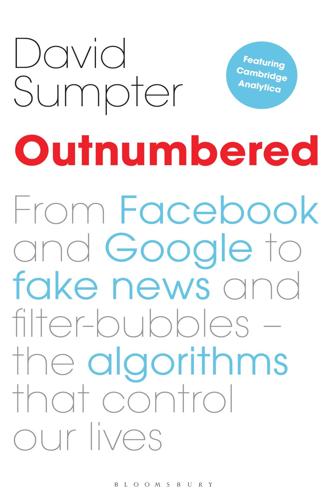
Outnumbered: From Facebook and Google to Fake News and Filter-Bubbles – the Algorithms That Control Our Lives
by
David Sumpter
Published 18 Jun 2018
I am overwhelmed by the juxtaposition of fact and fiction, trying to make sense of the jumble of ideas. I click from one video to the next, and end up spending over three hours browsing videos, each of which has been watched hundreds of thousands or even millions of times before. I watch a stern-faced presentation from a member of anti-chemtrails organisation Geoengineering Watch, about ‘the rapidly-evolving science’ behind chemtrails. I find a clip of Prince talking about how the link between chemtrails and violence inspired his songs. There is a concerned mother calmly explaining the connections between heavy metals and human health. These are rounded off by confessions from retired government officials and a woman who reportedly had her children taken away from her because she dared to reveal the truth about how our government is poisoning us.
…
It takes a few minutes before my mind clears and my scientific brain starts to work again. I don’t think I am at serious risk of being sucked into a conspiracy bubble, but watching the videos allows me to better understand those people who are. I go on to look at the dry, factual webpage curated by Harvard professor of Geoengineering, David Keith, where he carefully explains why the chemtrails conspiracy is entirely fictional. I watch a video abstract recorded by Steve J. Davis, Earth System Science professor at the University of California, who surveyed 77 scientists about the possibility of a chemtrails-like conspiracy.
…
All but one of these experts said that the so-called evidence could be explained by other wellunderstood factors. But Steve’s video had only been watched 1,720 times and I could see why. It was factual, but it lacked drama. It showed him sitting casually in his office, talking in a neutral voice about the importance of peer review. Without the agenda of an organisation like Geoengineering Watch, he didn’t feel he needed to push his side of the argument. I could understand why he presented his work in the way he did, but comparing his videos with those I watched earlier, I could also see why the scientific bubble is smaller than the conspiracy bubble. Conspiracies are much more captivating.

Grand Transitions: How the Modern World Was Made
by
Vaclav Smil
Published 2 Mar 2021
And while the recent focus on climate change has sidelined concerns about many other environmental problems that degrade and pollute the biosphere, it must be stressed that many of these undesirable changes would not be resolved even by a miraculously instant cessation of greenhouse gas emissions. Extraordinary challenges may call for extraordinary measures and that is why geoengineering—deliberate large-scale alteration of one or more processes affecting the Earth’s climate—is seen by some as perhaps the best solution to the intractable global problem of reconciling carbon-based economic growth with the concerns about global climate change. Geoengineering proposals range from constant dispersal of aerosols (sulfates or carbonates) in the stratosphere to reduce the incoming radiation and to cool the troposphere to changes of terrestrial albedo and mass-scale ocean fertilization (Keith 2013; Boyd and Vivian 2019).
…
These options are theoretically promising, but practical complications range from the rights to manage global commons and asserting national sovereignty to unforeseen and unevenly distributed negative consequences of long-term radiation or albedo alterations. I agree with what one of today’s keenest proponents of geoengineering wrote nearly a generation ago, that “we would be wise to begin with a renewed commitment to reduce our interference in natural systems rather than to act by balancing one interference with another” (Keith 2000, 280). Consequently, should the impacts of global warming unfold as recently predicted—including a further, and unevenly distributed, increase of the tropospheric temperature, a gradual ocean-level rise, and the continued retreat of mountain glaciers—then the most likely outcome during the coming decades will be a great deal of unavoidable economic, social, and environmental adaptation.
…
In United States Congress, Energy reorganization act of 1973: Hearings, Ninety-third Congress, first session, on H.R. 11510, p. 248. Bouwman, A.F. et al. 2005. G. Exploring changes in river nitrogen export to the world’s oceans. Global Biogeochemical Cycles 19. doi: 10.1029/2004GB002314 Boyd, P.W. and C.M.G. Vivian, eds. 2019. High Level Review of a Wide Range of Proposed Marine Geoengineering Techniques. Geneva: IMO. BP (British Petroleum). 2018. Energy Outlook. https://www.bp.com/en/global/corporate/energy-economics/energy-outlook.html BP. 2020. BP Statistical Review of World Energy. London: BP. https://www.bp.com/content/dam/bp/business-sites/en/global/corporate/pdfs/energy-economics/statistical-review/bp-stats-review-2020-full-report.pdf Breitburg, D. et al. 2018.

The Most Good You Can Do: How Effective Altruism Is Changing Ideas About Living Ethically
by
Peter Singer
Published 1 Jan 2015
More studies intended to strengthen the evidential base of these figures are currently under way. 13. Dale Jamieson, Reason in a Dark Time: Why the Struggle Against Climate Change Failed—and What It Means for Our Future (Oxford: Oxford University Press, 2014). GiveWell has reviewed geoengineering as an opportunity for effective philanthropy: http://www.givewell.org/labs/causes/geoengineering. Clive Hamilton expresses concerns in Earthmasters: The Dawn of the Age of Climate Engineering (New Haven: Yale University Press, 2013). 14. Aldo Leopold, “The Land Ethic,” in his A Sand County Almanac (New York: Oxford University Press, 1949). 15.
…
That raises a separate ethical question, to which I will return in chapter 15. For the moment, I will assume that climate change will have disastrous effects on many millions and perhaps billions of people but that our species will survive. It is almost certainly too late to stop or reverse climate change, at least without the use of risky geoengineering techniques.13 On the other hand, slowing climate change would be a very important goal, one that would bring huge benefits to the global poor and to all future generations. Whether we should support charities seeking to do that will depend on our estimate of the probability that our contribution will affect the ultimate outcome.

Whole Earth: The Many Lives of Stewart Brand
by
John Markoff
Published 22 Mar 2022
days. It would now put Brand on a collision course with people who had once been his close friends. * * * When it was published in October 2009, Whole Earth Discipline was viewed as a rallying cry by some and as treason by others. By endorsing vast cities, GMO foods, nuclear power, and geoengineering to forestall global warming, he threw down a gauntlet that left many Greens feeling betrayed. As he wrote, he savored the notion of going against the grain but in one sense felt the book was a reaffirmation of where he had begun with the Whole Earth Catalog four decades earlier. In the fall of 1968, he had set out by arguing, “We are as Gods and might as well get good at it.”
…
The melting of the arctic ice, Lovelock had argued, was introducing more global heating, adding that large regions of the Earth would become uninhabitable decades sooner than the then current climate models estimated. The only answer was to go to a wartime emergency footing. The world needed to prepare for climate refugees and consider geoengineering solutions to buy time. Brand called Lovelock for more detail. “People don’t realize how little time we have. The planet is on the move,” Lovelock said, explaining that global warming was on track to raise the average temperature of the planet by 5 degrees Celsius. How many humans could such a world support?
…
The lack of media attention translated into slow sales, disappointing his publisher—a striking contrast to the reception the book received in the United Kingdom when it was published there several months later. The complete gamut of newspapers reviewed the book, treating it in a serious fashion. Less than a year later, however, shortly after the paperback had been published with a new subtitle—Why Dense Cities, Nuclear Power, Transgenic Crops, Restored Wildlands, and Geoengineering Are Necessary—Brand ran into a more challenging confrontation in London. The British television network Channel 4 had produced Where the Greens Went Wrong, a documentary based largely on the themes of Whole Earth Discipline, and had invited Brand to appear on a panel in London the day after the film was scheduled to air.

The Caryatids
by
Bruce Sterling
Published 24 Feb 2009
I’m not a wreck! It’s the island that’s a wreck, and I am a solution. Yes, I had an awful time when I went down in that mine with you, I overdid that, I was stupid, but normally, I’m very emotionally stable. My needs and issues are all very clear to everyone. Plus, Herbert taught me a lot about geoengineering. I am very results-oriented.” “Sure, Vera. Sure you are. You get more done around here than anyone else does. We all love you for that devotion to duty. You’re our golden darling.” “Okay,” said Vera, growing angry at last. “Your campaign speech is impossible. That is crazy talk, that isn’t even politics.”
…
But whenever they work—that’s when the world has to take notice. The whole point of having our two-party system is to have a system for reality checks against the extremist groups.” Montalban spread his hands. “In any place but Europe, they’d teach that in elementary civics classes.” “We’re not an ‘extremist group’ here. We are rescue workers and geo-engineers.” “Of course you’re an extremist group. Of course you are! You’ve got mind-reading helmets on your heads! Look at those shaven patches on your scalp! You don’t even walk like normal people here—you all walk like you could bend over backward like crabs! Plus, this island is covered with weird labor camps that practice sensory totalitarianism!
…
These distant Australians, so painfully familiar with refugee camps, knew a lot about scanners, neural tech, and heavy machinery. World-spanning, instant connectivity was the stuff of being for a global civil society. So, somewhere up in the Acquis administrative stratosphere, cogwheels turned, galactic and distant. Six weeks later, Vera found herself meeting Herbert Fotheringay, an Australian geoengineer. A small Acquis neural corps was formed to redeem Mljet. Vera thought that Herbert had done that, while Herbert had always said that she had inspired it. Now, sitting years later in the sagging deck chair in an old boat with the island sinking into darkness, Vera knew that no single person had ever done that.
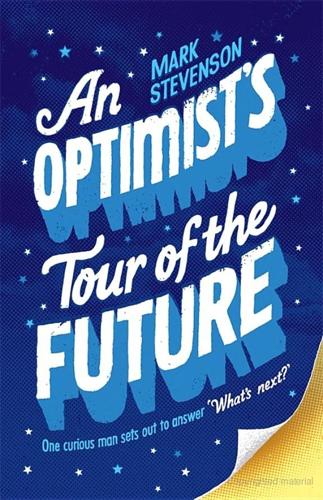
An Optimist's Tour of the Future
by
Mark Stevenson
Published 4 Dec 2010
Which naturally prompts the question ‘What can we do about it?’ The options generally presented are to do nothing (this from the sceptic camp), cut CO2 emissions (from optimistic climate activists) or engineer countermeasures to produce some kind of counteracting cooling effect. This last option is called ‘geo-engineering,’ of which the wackiest idea is launching large mirrors into orbit. Geo-engineering is usually suggested by pessimistic climate activists. But there is another option. Invest in Klaus Lackner. Klaus and his colleagues have built a ‘carbon scrubber’ – a machine that strips CO2 out of the air. Or to put it another way, on one side of Klaus’s machine is air that contains current levels of CO2 and on the other is air with roughly the same amount of CO2 as was present before the Industrial Revolution.
…
EARTH Chris Goodall, Ten Technologies to Save the Planet Profile Books, London, 2008 A highly readable account of ‘renewable’ technologies that cuts through the hype to deliver a measured picture of how we might green our economies. Wally Broecker and Robert Kunzig, Fixing Climate Profile Books, London, 2008 Perhaps the definitive history of climate science for the layman – and a powerful take on the future of geo-engineering. Allan Savory with Jody Butterfield, Holistic Management: A New Framework for Decision Making Island Press, Washington DC, 1999 A farming manual – but one that’ll change the way you make decisions. Stewart Brand, Whole Earth Discipline Viking Press, New York, 2009 This is the book that managed to cheer up James Lovelock.
…
M. 161 fossil fuels 168, 191–2, 193, 302 Fowler, Colorado 200–1 Franken, Al 303 Future of Humanity Institute 13, 25 G Gagarin, Yuri Alekseyevich 133 Gaia hypothesis 164 Galactic Suite 137 Gas Technology Institute 212 Gates, Bill 186 Gayoom, Maumoon Abdul 244–5 Ge Hong 15 Gelsinger, Jesse 58–9, 64 gene expression 47 gene therapy 58–60 genes 45, 46–7 genetic testing 297–9 genome 35–52, 55, 279 genome engineering 60–3, 186–7 genome sequencing 35–6, 40–1, 50–1 influenza virus 64–5 Personal Genome Project (PGP) 37, 42–3, 47–50, 273, 301 geo-engineering 179 Gerritsen, Nick 218–20 Girifushi 241–2 global warming 143, 164, 167–72, 174–7, 208 and agriculture 228–31, 233–5 Maldives 241–9, 256–62 Northwest Passage 178 Gödel, Escher, Bach (Hofstadter) 276 Godin, Seth 155–6, 291 Goldacre, Ben 58 Goldberg, David 182 Goodall, Chris 215 Google 151, 152, 157, 160, 194–5 ‘Google Goggles’ 163 Google Lunar X prize 137 Gore, Al 303 Gray, John 303 Greason, Jeff 136, 137, 141–3 Greenpeace 185 Greider, Carol 18 Grey Goo 121–3 grid parity 203, 205 guanine 37–9, 46 Guggenheim, Polly 77, 80 Guthrie, Woody 44 H H5N1 69–70 Hailiebrae 235–7 Haiti 202 HAL 9000 76, 102 Hansen, Jim 215 Harvard 20, 40 Harvard Medical School 149 Hawking, Stephen 140, 159 Hayflick, Leonard 18 Hayflick limit 18–19, 51, 52 Haylan, Ken 235–7, 239 Heeger, Alan 196, 201, 203 Heinlein, Robert 142 Heinrich, Andreas 125 Herr, Hugh 29 Hess, Rick 197–204, 285 Hillis, W.
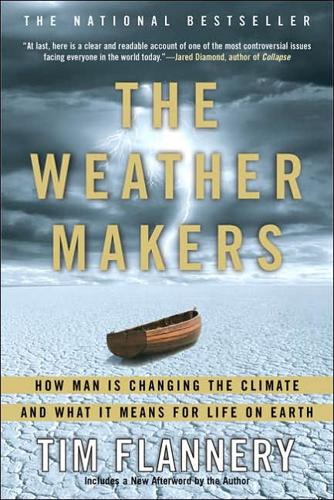
The Weather Makers: How Man Is Changing the Climate and What It Means for Life on Earth
by
Tim Flannery
Published 10 Jan 2001
If we are successful, by 2150 or thereabouts greenhouse gas levels will have dropped to the point where Gaia can once again control Earth’s thermostat. Emissions are reduced sufficiently to avoid outright disaster, but serious damage to Earth’s ecosystems results. With world climate on a knife-edge, Crutzen’s vision of internationally agreed geo-engineering projects becomes mandatory. Civilisation will hover on the brink for decades or centuries, during which period the carbon cycle will need to be strictly controlled, by large and small geo-engineering projects alike. Under this final scenario humans would have no choice but to establish an Earth Commission for Thermostatic Control, something that could easily grow from the Kyoto Protocol.
…
The European Union, the report says, may go one of two ways—either becoming unified with a focus on border protection (to keep out those homeless Scandinavians, among others), or driven to collapse and chaos by internal squabbling. And they posit that Russia, made suddenly acceptable by its huge energy resources, may join the EU. The report makes seven recommendations to the US government to prepare for such eventualities, including exploring geo-engineering options (such as CO2 sequestration) that may help slow climate change. Yet, incredibly, Schwartz and Randall fail to mention the option at the heart of the problem—reducing the use of fossil fuels! In 2004 the Hollywood disaster movie The Day after Tomorrow also imagined the consequences of a possible shutdown of the Gulf Stream.
…
JAMES LOVELOCK, Gaia, 1979 Paul Crutzen helped save the world from ozone depletion by CFCs, and for it he received a Nobel prize. With the threat of climate change looming Crutzen is once again engaging in the debate, and he is already thinking far ahead. ‘Our future may well involve internationally accepted, large-scale geo-engineering projects…to optimise climate,’ he opined in Nature in 2002. It is a thought that merits time to explore, and to begin we must look at the great game of climate modification that humanity is engaged in. I can see three possible outcomes: Our response to limiting emissions is too slow or unco-ordinated to avert great climate shifts, which destroy Earth’s life support systems and destabilise our global civilisation.
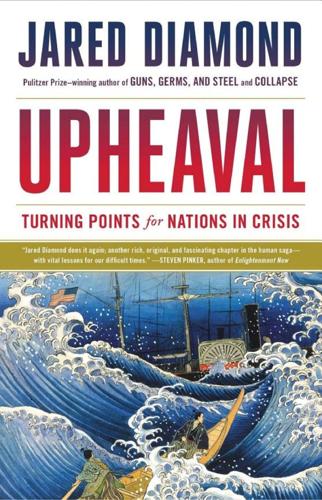
Upheaval: Turning Points for Nations in Crisis
by
Jared Diamond
Published 6 May 2019
Unfortunately, lab tests couldn’t reveal how CFCs, once they got into the atmosphere, would begin to destroy the ozone layer that protects us from ultraviolet radiation. As a result, CFCs became banned in most of the world—but only several decades later. That illustrates why geo-engineering would first require “atmospheric testing”—an impossibility, because we would have to ruin the Earth experimentally 10 times before we could hope to figure out how to make geo-engineering produce just the desired good effects on the 11th try. Hence most scientists and economists consider geo-engineering experiments as extremely unwise, even lethally dangerous, and deserving to be banned. Does all this mean that climate change is unstoppable, and that our children are certain to end up in a world not worth living in?
…
Yes, there are some, such as the prospect of opening ice-free shipping lanes in the far North as Arctic sea ice melts, and perhaps increased wheat production in southern Canada’s wheat belt and some other areas. But most of the effects for human societies are big bad ones. Is there any quick technological fix to these problems? You may have heard of various suggested geo-engineering approaches, such as injecting particles into the atmosphere, or extracting CO2 from the atmosphere, in order to cool the Earth’s surface. But there isn’t any geo-engineering approach that is already tested and known to work; the proposed approaches are very expensive; and testing and implementing any such approach is certain to take a long time and likely to uncover unforeseen bad side-effects.
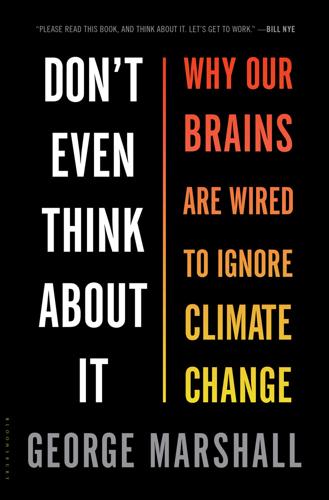
Don't Even Think About It: Why Our Brains Are Wired to Ignore Climate Change
by
George Marshall
Published 18 Aug 2014
However, the narrative of technological solutions and elitist control that permeates bright-siding can all too readily embrace a darker vision of the future in which vast planetary-scale engineering solutions (usually known as geo-engineering, or more chillingly, climate remediation) remove carbon from the atmosphere or reflect sunlight away from the earth. These technologies are fascinating to entrepreneurial billionaires such as Niklas Zennström, cofounder of Skype, and Bill Gates, who is described by Fortune as “the world’s leading funder of research into geoengineering.” In 2007 Al Gore and Sir Richard Branson, billionaire founder of Virgin airlines, announced a competition called the Virgin Earth Challenge offering twenty-five million dollars “to find commercially viable designs to permanently remove greenhouse gases from the atmosphere.”
…
While turning up the optimism about technological solutions, bright-siding turns down the volume of threat. It is only a few more notches on the dial before one is deep into outright denial. The libertarian Cato and Heartland Institutes, while strongly denying the existence of climate change, have no problem promoting the solution of geo-engineering as “more cost-effective” and “delivering measurable results in a matter of weeks rather than the decades or centuries required for greenhouse gas reductions to take full effect.” The fact that outspoken free market deniers can endorse the positive solution, while refusing to accept the existence of the negative problem, is revealing and relevant.
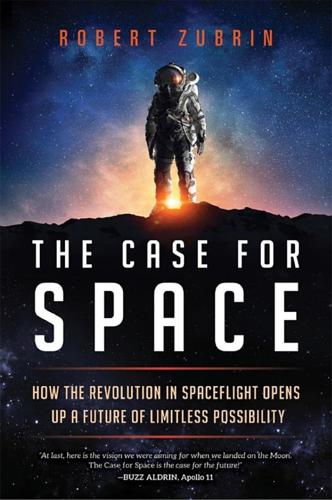
The Case for Space: How the Revolution in Spaceflight Opens Up a Future of Limitless Possibility
by
Robert Zubrin
Published 30 Apr 2019
NASA Goddard Spaceflight Center, http://disc.sci.gsfc.nasa.gov/giovanni/giovanni_user_images#iron_bloom_northPac (accessed November 17, 2018). 9. Naomi Klein, This Changes Everything: Capitalism against the Climate (New York: Simon and Schuster, 2014); Naomi Klein, “Geoengineering: Testing the Waters,” New York Times, October 28, 2012, http://www.nytimes.com/2012/10/28/opinion/sunday/geoengineering-testing-the-waters.html?pagewanted=all (accessed January 25, 2019). 10. Margaret Munro, “Ocean Fertilization: ‘Rogue Climate Hacker’ Russ George Raises Storm of Controversy,” Vancouver Sun, October 18, 2012. 11. Assuming 1 percent efficiency of phytoplankton in converting CO2 into biomass, and an average day/night sunlight flux of two hundred watts per square meter, it would take ten million square kilometers, or 3 percent of the oceans’ total area, to capture all the CO2 emissions from humanity's current twenty-terawatt fossil fuel combustion.
…
Unfortunately, the experiment, which should have received universal acclaim, was denounced by many leading environmental activists. For example, Silvia Ribeiro, of the international environmental watchdog ETC group, objected to it on the basis that it might undermine the case for carbon rationing. “It is now more urgent than ever that governments unequivocally ban such open-air geoengineering experiments. They are a dangerous distraction providing governments and industry with an excuse to avoid reducing fossil fuel emissions.” Writing in the New York Times, Naomi Klein, the author of a book on “how the climate crisis can spur economic and political transformation,” said that “at first,…it felt like a miracle.”9 But then she was struck by a disturbing thought: If Mr.
…
George's account of the mission is to be believed, his actions created an algae bloom in an area half of the size of Massachusetts that attracted a huge array of aquatic life, including whales that could be “counted by the score.”…I began to wonder: could it be that the orcas I saw were on the way to the all-you-can-eat seafood buffet that had descended on Mr. George's bloom? The possibility…provides a glimpse into the disturbing repercussions of geoengineering: once we start deliberately interfering with the earth's climate systems—whether by dimming the sun or fertilizing the seas—all natural events can begin to take on an unnatural tinge…. A presence that felt like a miraculous gift suddenly feels sinister, as if all of nature were being manipulated behind the scenes.
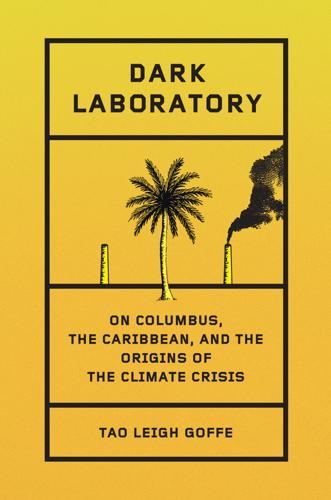
Dark Laboratory: On Columbus, the Caribbean, and the Origins of the Climate Crisis
by
Tao Leigh. Goffe
Published 14 Mar 2025
The worlds Europeans built depended on making the lives of some disposable. Billions are spent on research and development each financial quarter in service of more and more advanced machineries of extraction and geoengineering. Amid the abandonment and ruin left by deindustrialization, many hope for reindustrialization as a solution. How could it be? While it should be apparent that more mining and pollution cannot be a sustainable answer, investments in geoengineering are often touted as the carbon-neutral solution. Economic geology as an academic discipline came to prominence in the 1970s, funded by gas and oil companies. It’s currently reinventing itself, and it’s easy to forget the fossils in fossil fuels, and how mining our material and decomposed past is foreclosing the future.
…
We require unprecedented collective environmental policy and action beyond the boundaries of nation-states for the twenty-first century. We must refuse to betray future generations, especially because we have been forsaken by so many before us. Technocrats have convinced us the only option is continued extracting, geoengineering, and polluting. We need new stories, new technologies, and new forms of nature writing. The armchair approach of the old boys’ club has failed the earth. Nature documentaries, filmed from the eye of God with classical music scores, have failed us and detached us. Transcendentalism has failed the planet in its abstract romanticism when what we need is action led by the global majority, which is to say Africa, Asia, the Caribbean, the Middle East, the Pacific, and Latin America.
…
The mysteries of flesh animate these marine invertebrate animals, creatures that hold the balance of ocean biodiversity in their undulating polyps. The cold Atlantic is an intermediary zone of rebirth through interspecies ecologies. Underwater valleys also require protection from the threats of extractive economies due to advances in deep-sea mining and geoengineering technologies. We are experiencing a new Gold Rush of prospecting and speculation that will ravage the seas. It is taking place in Guyana, a hotspot of new oil in deep-sea reserves. Have we yet recovered from the extractivist mining frenzy of 1849 and the Gold Rush? More than 295 feet of high-quality oil-bearing sandstone reservoirs were drilled off the coast of Guyana in 2015.
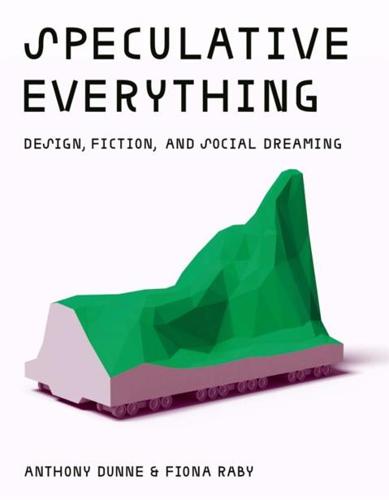
Speculative Everything: Design, Fiction, and Social Dreaming
by
Anthony Dunne
and
Fiona Raby
Published 22 Nov 2013
He then developed a number of large-scale project proposals including turning Nevada into a weather experimentation zone causing a gold rush of lightning energy harvesters and making modifications to freeways so they became energy-generating power plants. The project was presented through a variety of media, including a corporate video presentation explaining The Golden Institute's history, structure and mission, a model of its HQ, and drawings and images of design proposals. Sascha Pohflepp, Painting of a Geoengineered Lightning Storm ov er Golden, Colorado, 2009, from the series The Golden Institute. Sascha Pohflepp, Model of a Chevrolet El Camino Lightning Harvester Modification (side), 2009, from the series The Golden Institute. Sascha PohfIepp, Model of an Induction Loop - equipped Chuck's Cafe Franchise by Interstate 5, Colorado, 2009, from the series The Golden Institute.
…
For the designers, this was nano ice cream. From this they had the idea of using an ice cream van as a mobile platform for talks and presentations by activists, scientists, and others. During the project they consulted many scientists including Richard Jones, a nanoscientist with an interest in geo-engineering. Together they realized that, in theory at least, clouds could be seeded to make flavored snow based on a modified version of established cloud seeding technology. Out of this the Cloud Project was born, an ice cream van for seeding clouds to produce flavored snow. At this point the technology exceeded what was possible in an MA project, technically and financially, so the cloud-seeding canons were nonworking.
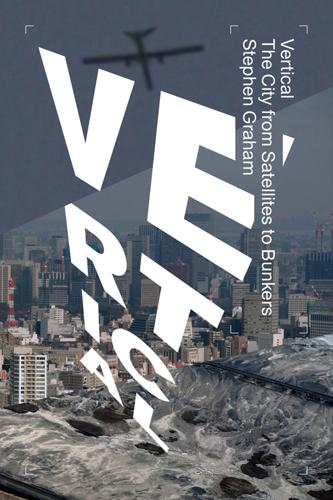
Vertical: The City From Satellites to Bunkers
by
Stephen Graham
Published 8 Nov 2016
China already has an army of 50,000 ‘weather-warriors’ trained to man 7,000 cloud-seeding artillery guns; an equivalent number of rockets bearing cloud-seeding chemicals; and over 50 cloud-seeding aircraft.98 Unlike such ‘weather warfare’, environmental writer Jamais Cascio reports, ‘geoengineering would be subtle and long term, more a strategic project than a tactical weapon.’99 Future offensive geo-engineering – linked closely to civilian research on geo-engineering to tackle climate change, in which the CIA is taking a leading role100 – could take a wide variety of terrifying, and deeply unpredictable, forms. ‘Over-productive algae blooms can actually sterilize large stretches of ocean over time, effectively destroying fisheries and local ecosystems’, Jamais Cascio stresses.
…
All such techniques, notes Sloterdijk, involve the up-scaling of ideas of air-conditioning of small, local ‘bubbles’ around individual bodies, rooms or buildings to larger urban, regional or even planetary scales. Indeed, political scientists Brad Evans and Julian Reid remind us that ‘it is no coincidence that we may trace the origin of climatic conditioning to warfare.’93 It is inevitable, then, that debates about weaponising weather overlap with those concerned with using geo-engineering techniques to address crises of climate change, intensifying extreme weather events, and resource exhaustion. In addressing this overlap, however, we must overcome the long-standing myth that meteorology and climate are entirely ‘natural’, drawing only on other-than-human forces. ‘So long as meteorology presents itself as a natural science and nothing else’, Sloterdijk stresses, ‘it can pass in silence over the question of the weather’s possible author.’94 While the International Panel on Climate Change is coming fully to grips with unintentional effects of urban-industrialism on the earth’s atmosphere, it has so far failed completely to address real or potential acts of climatic warfare.95 Such a shift is long overdue.
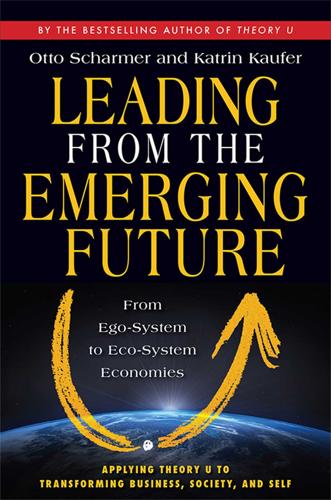
Leading From the Emerging Future: From Ego-System to Eco-System Economies
by
Otto Scharmer
and
Katrin Kaufer
Published 14 Apr 2013
Erik Rauch, “Productivity and the Workweek,” http://groups.csail.mit.edu/mac/users/rauch/worktime (accessed December 9, 2012); John de Graaf, “Affluenza Cure Calls for Political Action: Different Standards for Workweek an Opportunity,” special to the Denver Post, October 29, 2001. 49. For a more artistic way of saying pretty much the same thing, see the Flobots’ “Handlebars” video at www.youtube.com/watch?v=HLUX0y4EptA (accessed December 9, 2012). 50. Naomi Klein, “Geoengineering: Testing the Waters,” New York Times, Opinion, October 27, 2012, www.nytimes.com/2012/10/28/opinion/sunday/geoengineering-testing-the-waters.html?pagewanted=all&_r=1& (accessed December 9, 2012). 51. Division for Science Policy and Sustainable Development at UNESCO, “UNESCO Science Report: The Current Status of Science around the World,” Executive Summary (UNESCO Publishing, 2010), http://unesdoc.unesco.org/images/0018/001898/189883e.pdf (accessed December 9, 2012). 52.
…
Despite technology’s many failures, the belief that it can magically solve our global and local crises around water, food, energy, health, and sustainability is as strong as ever. The wonderful appeal of the proposition that technology will fix the problem is that it sounds easy. The fix does not require that we address underlying issues or engage in a profound change process. Climate change? No problem! Let’s just throw some geoengineering at it, like a global shield around the planet that will deflect the sun’s rays away from the earth.50 3. Relink R&D investments with pressing societal needs. Today’s global investments in research and development (R&D) are around US$1.2 trillion. The Gross Domestic Expenditures on R&D (GERD) indicator summarizes the R&D expenditures of business, government, universities, and nonprofit organizations.
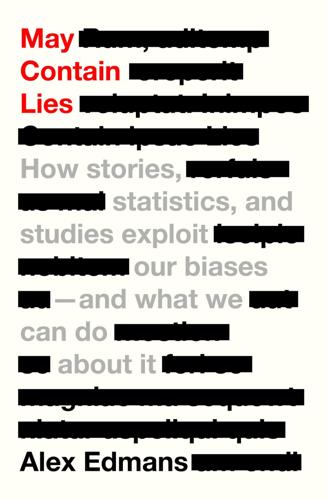
May Contain Lies: How Stories, Statistics, and Studies Exploit Our Biases—And What We Can Do About It
by
Alex Edmans
Published 13 May 2024
A third approach is to shift the focus from problems to solutions. People are more willing to acknowledge the disease if they agree with the cure. Another study co-authored by Kahan found that right-wing participants were more willing to accept that climate change is a serious threat if the remedy is geoengineering – launching solar reflectors, injecting aerosol particulates into the stratosphere and capturing carbon to store it in deep geological formations – rather than regulation. This solution links climate change to cultural meanings of human ingenuity and industrial innovation, which resonate with free marketers and help them view climate action as an opportunity, not just a threat.8 Checking the facts . . . the data and the evidence ‘New York Times bestseller.
…
N. (1985): ‘Postprimary education has little impact on informal reasoning’, Journal of Educational Psychology 77, 562–71. 5 Perkins, David (2019): ‘Learning to reason: the influence of instruction, prompts and scaffolding, metacognitive knowledge, and general intelligence on informal reasoning about everyday social and political issues’, Judgment and Decision Making 14, 624–43. 6 Kahan, Dan M. (2015): ‘Climate-science communication and the measurement problem’, Advances in Political Psychology 36, 1–43. 7 Kahan, Dan M. et al. (2010): ‘Who fears the HPV vaccine, who doesn’t, and why? An experimental study of the mechanisms of cultural cognition’, Law and Human Behavior 34, 501–16. 8 Kahan, Dan M. et al. (2015): ‘Geoengineering and climate change polarization: testing a two-channel model of science communication’, ANNALS of the American Academy of Political and Social Science 658, 192–222. 9 Ranehill, Eva et al. (2015): ‘Assessing the robustness of power posing: no effect on hormones and risk tolerance in a large sample of men and women’, Psychological Science 26, 652–6. 10 Nyhan, Brendan and Jason Reifler (2015): ‘The effect of fact-checking on elites: a field experiment on U.S. state legislators’, American Journal of Political Science 59, 628–40. 11 Henry, Emeric, Ekaterina Zhuravskaya and Sergei Guriev (2022): ‘Checking and sharing alt-facts’, American Economic Journal: Economic Policy 14, 55–86. 12 Pennycook, Gordon et al. (2020): ‘The implied truth effect: attaching warnings to a subset of fake news headlines increases perceived accuracy of headlines without warnings’, Management Science 66, 4944–57.
…
Anders 61, 62–3, 66, 104 errors of commission 250 errors of omission 250 estimation 246 evaluation 223, 233 evidence 5, 12, 13, 122 average results 280, 282 credentials 226–8 identity and 266 is not proof 192–210 scientific management 198–9 lack of 219 limitations of 280, 282 smarter thinking 288–9 in social sciences 224 systematic reviews 222 testing 217–18 validity 199 EXCOMM 237–8, 244, 254 cognitive diversity 238–9, 240 deliberation process 244–5 demographic make up 238 executive pay 67–9 exogenous parts of instruments 178–9, 179–80, 182, 190 experts 223–4 explained components of instruments 178–9 explorers 170, 171–2 external validity 199, 202, 204, 209 Fabo et al. 225–6 Facebook 272 Fact Check (Reuters) 270 fact-checking websites 270–71, 277, 282 facts 12, 13 are not data 89–114 learning from a blank slate 108–13 narrative fallacy 104–8, 113 seeing the full picture 95–104 selected samples 95–6, 102, 113 Steve Jobs and Apple 89, 90–92, 93, 94, 101–2, 103, 106, 107, 200 checking 7–8, 12, 21, 37, 85, 88, 103, 268–9 interpretation of 24 smarter thinking 285–6 failure parties 250 failures 250–51 fake news 271, 272, 282 Faleye, Olubunmi 4 family businesses 181–2 Fancy, Tariq 83–5, 226 fast-food employment 184–5 Fernbach, Philip 251 ‘Fifty shades of QE’ (Fabo et al.) 225–6 Financial Management Association 270 Financial Reporting Council 74 fintech companies 85–6 Fisher, Matthew 54 Fixit (fictional company) 119, 135–40, 137–40 data mining see data mining see also Xinyi (fictional name) Flammer, Caroline 243 flexibility 108 Flint, Austin 174–5 Floyd, George 75 Fong, Geoffrey 262 Fooled by Randomness (Taleb) 274 football 126–7, 188 decline in stock markets 134–5 Euros (2004) 126–7 mood and emotions 126–7, 128, 129 sentiment 129 World Cup (2014) 133–4 Forbes 219 Forbes 15 Best Business Books (2015) 268–9 Ford, Henry 245 Fortune 60, 219, 223 Fos, Slava 241 frequent trading 97–101 Frontiers in Nutrition study 144, 145 Full Fact 270 Galileo Galilei 226 Gallagher, Liam 44 Gama, Vasco da 171 García, Diego 129 Gavin, Jim 23 gender diversity 243 company performance research 118–24, 135–40 data mining see data mining evidence for fund launch 116–18 geoengineering 268 Getting Things Done (Allen) 229, 270 Gibson, Belle 17–20, 103–4 Gimbel, Sarah 28–9 Gladwell, Malcolm 6, 60, 66 Ericsson study 61, 62–3, 66, 104 magazine interview 60, 61, 63 10,000-hours rule 6, 59–61, 62–6 Global Head of Sustainability Research 85 global warming 265–6 Glossner, Simon 243 Golden Circle Model 92 Google 157, 255 Gore, Al 266 gradients 136–7 Grant Thornton 224 Grant Thornton Corporate Governance Index 225 granular world 45, 51–2, 56, 201 Great North Run 47 Gresham College 62, 264 grit 204–5, 207 group discussions 247–8 grouping 137–40, 140, 141 groupthink 236, 237, 241, 247–8, 257 growth mindset 62 Guardian, The 215 Guriev, Sergei 271–2 Guzey, Alexey 270 Halo Effect, The (Rosenzweig) 111 Harris, Sam 28–9 Harvard Business Review 103, 152, 154, 290–91 Harvard University 228 Heeb, Florian 54 Henry, Emeric 271–2 hierarchies 249–50 high pollution 150–51 Holmes, Elizabeth 20–21, 219 homeopathy 6 honorary doctorates 227 Hoxby, Caroline 169, 177–9, 202, 221 HSBC 256 Hughes, Robert 22 Hung, William 207 hunter gatherers 43–4 hydroxychloroquine 6–7 Hypocritical Oath 230 hypotheses 23–5, 66 average output 99 control samples 99, 102 inputs and outputs 98–9 magnitude of underperformance 100 representative samples 99, 102 reverse engineering 124–5 sample size 100 statistical significance 100–101 test samples 99 identity 266 Imperial Tobacco 152 inclusion 243–8 micro-processes 248–9 An Inconvenient Truth 265, 266 inequality 159–61, 162–3 information gathering 214 InfoWars 231 initial beliefs 216 instruments 177–8, 190 endogenous parts 178–9, 180, 182 exogenous parts 178–9, 179–80, 182, 190 natural experiments and 186 relevance 179, 180, 182, 190 ridiculousness and irrelevance 180–81 interaction effect 207 internal validity 199, 200, 202, 209 intervention studies 173 investors 127 Ioannidis, John 219 iPhone 91, 92 IQ (intelligence quotient) 143–4, 145–7 irrelevance of instruments 180–81 Isaacson, Walter 93, 101–2, 103 James (acrobat) 59–60 Jandali, Abdulfattah 89 Janis, Irving 236 Jensen, Michael 69, 70–71 Jobs, Clara 90 Jobs, Paul 89–90 Jobs, Steve 89, 90–92, 93, 101–2, 103, 106 Johnson, Tim 127–8 Joint Chiefs of Staff (JCS) 236, 237, 239, 240 Journal of Finance 129, 218 Journal of the American Medical Association 219 journal quality 218 journalists 228, 282 checking facts 273 journals impact factor 220 peer-reviews of 217–18 publication bias 220 Joy, Bill 61 Kahan, Dan 263, 266, 268 Kahneman, Daniel 29 Kaplan, Jonas 28–9 Keil, Frank 54, 251 Kempf, Elisabeth 241 Kennedy, General Robert 244, 245 Kennedy, President John F. 244 Bay of Pigs invasion 235–7, 244 Cuban Missile Crisis 235, 237–8, 239–40, 244–5 EXCOMM 238–9, 244–6 Kerry, John 29–30 Khrushchev, Nikita 235, 237, 240 Kirk, Stuart 256–7 knowledge 7–8, 10 biased interpretation 37 biased search 36–7 Krantz, David 262 Krueger, Alan 184–5 Krueger, Joachim 52 Ladder of Misinference 11, 56, 152, 232 Lancet 221 Lancet Public Health study 46 Langley, Samuel Pierpont 200 law of attraction 20 Leavers (Brexit) 214 LeMay, Curtis 239, 240 Lemnitzer, Lyman 239 Lepper, Mark 30–31, 259, 260, 261 Les Décodeurs 270 lies 12 limbic brain 93, 107 Lind, James 172–3, 174 LinkedIn post 153 Lisker, Bruce 21–3, 24 Lisker, Dorka 21–2 Living Wage 76–7 Lodge, Milton 36–7 London Business School 74–5 London Marathon 47 Lord, Charles 30–31, 259, 260, 261 Macintosh 91 marbled world 45, 53–5, 56 Martin, Roger L. 290–92 McDaniel, Mark 48 McGrath Task Circumplex 240 McKinsey 225 report (2020) 78 study (2017) 152, 154, 187, 291–2 McLaughlin, Dan 64–5 McNamara, Robert 239–40, 244 Mearsheimer, John 86 Meckling, William 69, 70–71 Medium 84 Medscape 219 Merton College 213 Merton in the City reunion (2016) 213–14 metal cutting 193–4 micro-processes 248–9, 258, 263 Midvale Steel Works 193 Miliband, Ed 160, 161 minimum wage laws 183–4 misinformation 5–7, 9–10, 67–8, 214, 230, 231, 234 misrepresentation 74–6 MIT 125, 126, 127 moderate world 45–50, 55 moderation 206–7, 209–10 momentum 157 Monsue, Andrew 22–3, 24 Montessori education method 263 Morgan Stanley 125, 130–31, 189, 255–6 ‘balanceworks’ programme 156 motivated reasoning 27–8, 30, 37, 184 Motor Neurone Disease Association 47 Mountain View (later Silicon Valley) 90 Mozart 61 Mullainathan, Sendhil 175–6 Murdoch, Lachlan 181 Murdoch, Rupert 20, 181 my-side reasons 264 naïve acceptance 25–7, 32, 37–8 narrative fallacy 105–8, 109, 113 twin biases 106 National Childbirth Trust (NCT) 143, 144–5 National Geographic 223 National Health and Medical Research Council 222 National Health Service (NHS) website 222 National Security Council (NSC) 237 National Union of Journalists 273 NATO 86 natural experiments 185–6, 187, 190 instruments and 186 Nature 6, 218 neocortex 92, 107 New Scientist 223 News Corporation 181 news feeds 6 Nisbett, Richard 262 No Child Left Behind Act (2001) 196–7 non-pecuniary benefits 70–71 Norli, Øyvind 129 Nyhan, Brendan 270 Obama, Barack 265 Object-Spatial Imagery and Verbal Questionnaire 240, 241 observational studies 173 Odean, Terry 96–8 oil spills 25–8 100 Best Companies to Work for 116–17, 156–7, 189 opinions, articulating in detail 251 Organization Stream Analysis 111 organizations 235–58 Oster, Emily 147, 201, 222 other-side reasons 264 out-of-sample tests 133 Outliers 61, 64, 104, 270 over-extrapolation 206–7, 209–10 Pagella Politica 270 Paige, Rod 196, 199 Paine, Lynn 290–91 Palin, Sarah 81 papers, scientific retractions 221 reviewed by scientists 220–21 submitted for review 217–18 parachutes 208–9 Paris Agreement (2015) 49, 50 pausing before criticizing 232–3 pausing before sharing 230–32 pay gaps 3–4, 5 Peak (Ericsson) 63, 104 peer reviewers 8 peer reviews 217–19, 233 books 223 reliability of 220 Pennycook, Gordon 231, 272 Perkins, David 264 Ph.D.s 227 Phillips et al. 242 Pickett, Kate 160–61, 162–3 The Spirit Level 159–60, 161, 163, 165, 200, 225, 270 pig-iron handling 194–5 Pixar 91, 250–51 placebo effect 174–5 PolitiFact 81, 270, 271 Pollock, Joycelyn 24–5 population density 151 Porras, Jerry 110–12 positive correlation 165 post hoc ergo propter hoc fallacy 164–5 post-mortem 255 poverty 160–61 power distance 249 power posing 221 Power, Thomas 239 PowerPoint 251–2 pre-mortem 255 precision 170–73 predictions 151, 152, 154, 167 Presence (Cuddy) 269, 270, 274 Preston, Elizabeth 259, 260, 261 Principles of Scientific Management, The (Taylor) 195 processing power 248–52 productivity 193–4 professorship 227 proof 198–9 Psychological Science 221, 269, 270 psychometric tests 108–9 publication bias 220 publication process 273–4 endorsements 274–5 quantitative easing 226 Quest, Richard 133–4 Quote Investigator 270 racial discrimination 175–6 Rambotti, Simone 161 random events 107 randomized control trials (RCTs) 173, 174–6, 189–90 instruments 177–8 limitations of 177 parachute experiment 208–9 randomness 170–73 range of values 206, 207–8 Raquel, Ronald 23 Rassemblement National 271–2 Reading Football Club 159 reasoning 264–5 red teams 254–5 reducing hierarchies 249–50 regression 136–7, 139, 140, 158, 161–2 common causes 158–9 regression coefficient 136 regulation 123 Reifler, Jason 270 Reis, Ebru 4 relevance of instruments 179, 180, 182, 190 Remainers (Brexit) 213, 214 replication studies 221 representative samples 96, 99, 102 research 4–5 best practice 273 boardroom diversity 74–5 confirming opinions 5 data mining 119–20 diversity 117–19 gender diversity see gender diversity open access 35 rigour 8, 117–19 sources 5–6 unvetted 218 research qualifications 226–7 resilient companies 78 Responsible Investment Advisory Committee 248–9 Retraction Watch 269, 270 Reuters 79 reverse causation 164–5, 167, 170, 187 reverse engineering 94, 107–8 review papers 222 Reyes the Entrepreneur 95, 97 rhetoric 215 rheumatism experiment 174 Rice-Davies, Mandy 76–7, 226 ridiculousness of instruments 180–81 Rogers, David 47, 207 Rosenzweig, Phil 111 Ross, Lee 30–31, 259 Rossmo, Kim 24–5 Rothschild, Jesse 221–2 Royal London Asset Management 248 Rozenblit, Leonid 251 Rozin, Paul 51–2 rules 66 Rusk, Dean 240, 244 sailors 170–72 Sainsbury’s 76–7 sample mining 131–3, 141 defending against 133–5 sample size 100 San Francisco Business Times 219 Sanders, Bernie 82 scaffolding 264–5, 281 Schieble, Joanne 89 Scholar’s Mate 32–3 school curriculum 196 schools choice of 169 collective learning 169 competition between 168–9 Schultz, George 20 scientific consensus 222, 233 scientific culture 253–5, 258 scientific curiosity 263 scientific intelligence 263 scientific journals 134 debunking studies 221 papers for review 217–18 scientific management in education 195–7 failure of 198–9 in manufacturing 195 scientific method 24, 25, 98–101, 102–3, 124 scientists 220–21 Scott, Willard 53 scurvy 170–72 citrus fruits 173 endogenous remedy 172 exogenous remedy 172, 173 Select Committee on Business 3–5 CEOs’s executive pay report 67–9 selected samples 95, 99, 102, 109–10, 111 self-help books 229 self-interest 215 semiconductors 53–4 ShareAction 76–7 shareholder returns 120–21 shareholder value 69, 70–71, 71, 85, 86 sharing information 230–32 shoulders of giants 217–18 shovelling technique (Taylor) 194 significance level 100 silent majority 247 silent starts 246, 251–2, 257 Silicon Valley Bank 28 Silicon Valley Business Journal 219 Sinek, Simon 69, 71, 93, 94, 107, 200, 229 sleep 71–3 Sloan, Alfred 254 smarter thinking see thinking smarter smoking 163–4, 202 Snowdon, Christopher 161 social distancing 75–6 social diversity 241–2 social media 10, 230–31, 231, 282 Soeters, Joseph 249 soldiering 193 Spirit Level Delusion, The (Snowdon) 161 Spirit Level, The (Pickett and Wilkinson) 159–60, 161, 163, 165, 200, 225, 270 sports impact on stock market 126–9, 134 mood and emotions 128–9 spurious correlations 122, 127, 141 St Paul’s 159 Start with Why (Sinek) 93, 270 statements 13, 59–88 accepted as facts 12 are not facts 87–8 death panel episode 80–81 inaccuracy 59–63 misrepresentation 74–6 choosing words carefully 71–5 lack of sources 81–2 misportrayal 69–71 misrepresentation 74–6 smarter thinking 283–5 that can never be facts 82–8 examining evidence 84–6, 88 exploring alternative explanations 86 twin biases 83–4 verifying as facts 73 statistical literacy 262–3, 264, 281 statistical significance 100–101, 120, 122, 137 statistics 161 Bayesian inference 23–4 Staw, Barry 107–8, 166 stock market 95–7 brokers 96–8 frequent trading 97–101 sentiment 127, 128 sport, impact on 126–9, 134 traders 96–8, 125–6, 128 trading floor 125–6 stories 104–5, 108 Strange, Angela 85–6 striatum 30 Sun Tzu 11 Sunday Times Rich List 108 superlatives 85, 86 survey papers 222 sustainability 8–9, 215, 267 sustainable investments 54, 83–5 System 1 thought process 29 System 2 thought process 29 systematic reviews 222, 233 Taber, Charles 36–7 Taleb, Nassim 106, 274 targets 49–50 Taylor, Frederick Winslow 192–4 Taylor, General Maxwell 237 tech industry 157 TED 9, 205–6 Telegraph, The 215 10,000-hours rule 6, 64, 66, 104 chasing dreams 64–6 claim 59–61 disheartening 66 evidence 62–3 Tesla 152 test groups 139 natural experiments 185–6 randomized control trials (RCTs) 174–5, 177 test samples 99 theory of everything 199, 200, 204 Theranos 20–21, 219, 226 Thinking, Fast and Slow (Kahneman) 29 thinking smarter data 286–8 evidence 288–9 example of 290–92 facts 285–6 individuals 213–34 organizations 235–58 preliminaries 283 shortcuts 289 societies 259–82 statements 283–5 studies 289–90 Thirteen Days: A Memoir of the Cuban Missile Crisis (Kennedy) 244 Thomson Reuters 132 TikTok 20 time-series studies 30, 31 tolerating failure 250–51 Tolstoy, Leo 216–17 Tonight Show, The 40 traders 96–8, 125–6, 128 Trades Union Congress (TUC) 4–5 traits 149–50, 166 Trevithick, Richard 171 Trouble with Europe, The (Bootle) 213–14 Trump, Donald 6–7, 271 trust 153 Trust across America 153 trustworthy companies 153 truth 12, 13, 21–6 Tsoutsoura, Margarita 241 twin biases 56, 66–7, 73, 83–4, 106, 199 Twitter (later X) 230–31 2-4-6 brainteaser 33, 260, 261 UBS 250 unexplained components of instruments 178–9 United States of America (USA) death panels 80–81 healthcare 80–81 universal statements 85 universality 199, 201 unnatural experiments 186–7 US Military Academy 202–3 USSR 235, 244 see also Cuban Missile Crisis vaccination 267–8 Venkateswaran, Anand 4 verification 220 Vigen, Tyler 122 Vioxx 220 Vogue diet 40 Vogue magazine 40 voluntary choice inputs 149, 166 voting 247 Wakefield, Andrew 221 Walker, Matthew 71–3 Wall Street Journal 84, 219 Wason, Peter 33, 260, 261 water intoxication 47 weight loss 40–41 Welch, Jack 71, 85, 86 West Point 202–3, 204, 206 The Whole Pantry app 17–18 Whole Pantry, The 18, 273 Why We Sleep (Walker) 71–3, 270 Wikipedia 200 Wilkinson, Richard 160–61, 162–3 The Spirit Level 159–60, 161, 163, 165, 200, 225, 270 work-life balance 156 Wright Brothers 200 wrongful convictions 24–5 Xinyi (fictional name) 116–19 data mining see data mining see also Fixit (fictional company) Yeh, Robert 208–9 Zhuravskaya, Ekaterina 271–2 Founded in 1893, UNIVERSITY OF CALIFORNIA PRESS publishes bold, progressive books and journals on topics in the arts, humanities, social sciences, and natural sciences—with a focus on social justice issues—that inspire thought and action among readers worldwide.

How to Blow Up a Pipeline
by
Andreas Malm
Published 4 Jan 2021
Imagination is a pivotal faculty here. The climate crisis unfolds through a series of interlocked absurdities ingrained in it: not only is it easier to imagine the end of the world than the end of capitalism, or the deliberate, large-scale intervention in the climate system – what we refer to as geoengineering – than in the economic system; it is also easier, at least for some, to imagine learning to die than learning to fight, to reconcile oneself to the end of everything one holds dear than to consider some militant resistance. Climate fatalism does all in its power to confirm these paralysing absurdities.
…
A demand such as the prohibition of all new CO2-emitting devices loses none of its relevance at higher concentrations and temperatures, but precisely the opposite; the later in the day, the more imperative to enforce it by any means necessary. Overshoot of targets for climate mitigation calls for more, not less, resistance. This extends to geoengineering scenarios – the onset of solar radiation management, the roll-out of negative emissions technologies – which would rapidly fall apart without concomitant closure of CO2 sources. Until business-as-usual is a distant memory, as long as humans are around, resistance is the path to survival in all weathers; it didn’t become passé in 2009 and it won’t do so in 2029.
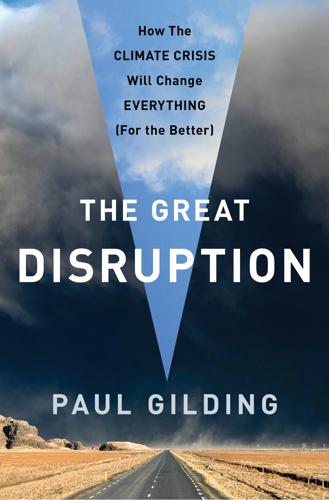
The Great Disruption: Why the Climate Crisis Will Bring on the End of Shopping and the Birth of a New World
by
Paul Gilding
Published 28 Mar 2011
We concluded that at that late stage, four types of actions would be required to take control of the crisis: 1. A massive industrial and economic shift that would see the elimination of net CO2e emissions from the economy within twenty years, with a 50 percent reduction in the first five years. 2. Low-risk and reversible geoengineering actions to directly slow temperature increase, to safely overcome the lag between emissions reduction and temperature impact. 3. The ongoing removal of around 6 gigatons of CO2 from the atmosphere per year for around one hundred years and the long-term storage of this CO2 in underground basins, in soils and in biomass. 4.
…
This would be the long-haul effort toward global climate control—the effort to create a stable global climate and a sustainable global economy. Achieving this will require a long period of negative emissions (i.e., removing CO2 from the atmosphere) to move the climate back toward the preindustrial “normal.” For instance, some refreezing of the arctic ice cap will require removing CO2 from the atmosphere through geoengineering actions, like burning plantation wood in power stations and storing the emissions underground using carbon capture and storage (CCS). We believe humanity can complete the stabilization job in the first decades after 2100. We tested our suggested emission cuts in the C-ROADS global climate model developed by Climate Interactive, an initiative of Ventana Systems, Sustainability Institute and MIT’s Sloan School of Management.7 This confirmed that implementation would deliver broadly the following results: • The CO2e concentration falls below 350 ppm by the end of the century, after peaking at around 440 ppm
…
These include how we could raise $2.5 trillion per year by year 5 via a global carbon tax and how this could be used to finance the measures required to compensate the poor, reduce disruption, and create the new industries and employment required. We also cover the types of multinational decision-making bodies that would be required, including a Climate War Command, and more detail on the actions required after the first five-year war, including major reversible global geoengineering projects to reflect sunlight and remove CO2 from the atmosphere and stabilize the global climate. The point is not to say that Professor Randers and I have the right plan or have defined all the right actions. What we sought to establish, and the point I’m making here, is that a study of history indicates that we will, in the end, embark upon a crisis response to climate change, and when we do, we can see through our plan that quite extraordinary reductions and management measures are practical and achievable.
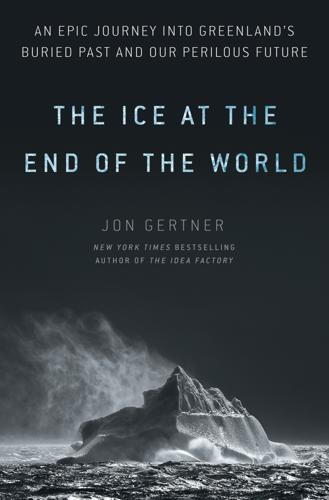
The Ice at the End of the World: An Epic Journey Into Greenland's Buried Past and Our Perilous Future
by
Jon Gertner
Published 10 Jun 2019
The study concluded that Greenland lost the vast majority of its ice sheet during certain warm periods in the past. 22. Jon Gertner, “Is It O.K. to Tinker with the Environment to Fight Climate Change?” The New York Times Magazine, April 18, 2017. 23. John C. Moore et al., “Geoengineer Polar Glaciers to Slow Sea-Level Rise,” Nature vol. 55 (March 14, 2018). The proposal was provocative and included a plan for geoengineering Thwaites Glacier, too. It elicited pushback about its feasibility and outcome. Twila Moon of the National Snow and Ice Data Center responded to Nature: “The authors’ suggestions (building ocean-bottom sills, installing pinning-point islands and removing subglacial water) might briefly slow [glacial] outflow.
…
These events can slightly replenish the ice sheet and can even lead to temporary advances in some glaciers. What’s more, if ocean circulations change, and the warm water flowing from the tropics to Greenland decreases, colder water may slow the disintegration process of some outlet glaciers. There may also be solutions that fall under the description of geoengineering. We may develop technological means to remove atmospheric carbon in the future—sucking it in through machines, and then burying it, for instance. Applying such technologies could conceivably delay the worst effects of climate change, though so far doing so on a scale with any significant impact remains untested and unproven.
…
Washington, D.C.: Government Printing Office, 1886. Mikkelsen, Ejnar. Lost in the Arctic. New York: George H. Doran Company, 1913. Mirsky, Jeannette. To the Arctic! The Story of Northern Exploration from Earliest Times to the Present. New York: Alfred A. Knopf, 1948. Moore, John C., et al. “Geoengineer Polar Glaciers to Slow Sea-Level Rise.” Nature 555 (March 14, 2018). Morlighem, M., et al. “Deeply Incised Submarine Glacial Valleys Beneath the Greenland Ice Sheet.” Nature Geoscience 7 (May 2014). Morlighem, M., et al. “BedMachine v3: Complete Bed Topography and Ocean Bathymetry Mapping of Greenland from Multibeam Echo Sounding Combined with Mass Conservation.”

Global Catastrophic Risks
by
Nick Bostrom
and
Milan M. Cirkovic
Published 2 Jul 2008
Climate Change 200 1 : The Science of Climate Change (Cambridge: Cambridge University Press). Hyde, W.T. and Crowley, T.J. (2000). Probability of future climatically significant volcanic eruptions. ]. Clim., 1 3 , 1445-1450. Keith, D.W. (2001). Geoengineering. Nature, 409, 420. Keith, D.W. (2007). Engineering the planet. In Schneider, S . and Mastrandrea, M . (eds.), Climate Change Science and Policy (Island Press). Kiehl, J.T. (2006). Geoengineering climate change: treating the symptom over the cause? Clim. Change, 77, 227-228. Kemp, M. (2005). Science in culture: inventing an icon. Nature, 437, 1 238. Keller, K., Hall, M . , Kim, S., Bradford, D.F., and Oppenheimer, M. (2005).
…
I ntuitively, this makes sense: if the marginal benefits of abatement are a weaker function of quantity than the marginal costs are, then it suggests getting the price right is more important than specifying the quantity, since there is no reason to try to hit some given quantity regardless of the cost. I f, however, the marginal benefits of abatement are a steep function of quantity, then it suggests that specifying the quantity is more important, since we would rather pay a sub-optimal amount than miss our environmental target. 3 This may change if various geo-engineering approaches come to play a significant role in the management of the climate change problem (Crutzen, 2006; Keith, 2001). For a review of these possibilities, see Keith (2007). Though preliminary analysis suggests the idea of attempting to tune global mean temperatures by lowering insolation might ought not be dismissed out of hand (Govindasamy and Caldeira, 2000), more full analyses are required before this becomes a serious policy option (Kiehl, 2006).
…
Though preliminary analysis suggests the idea of attempting to tune global mean temperatures by lowering insolation might ought not be dismissed out of hand (Govindasamy and Caldeira, 2000), more full analyses are required before this becomes a serious policy option (Kiehl, 2006). In any case, some problems of the direct effects of carbon - such as ocean acidification - are likely to remain significant issues, inviting the pessimistic possibility that geoengineering may carry its own severe climate-related risks. Climate change and global risk 28 1 This sort of intuition has implied that our best-guess, linear model of climate change leads to a preference for price controls. At the same time, if it were shown that catastrophic disruptions to the climate system were a real threat, it would lead us to opt instead for quantity controls.
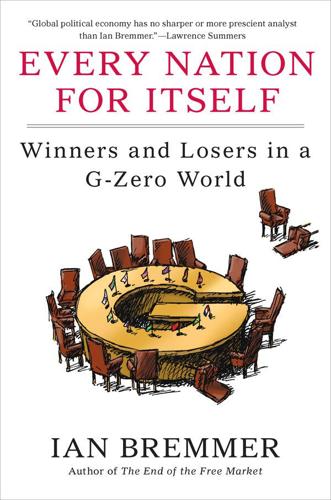
Every Nation for Itself: Winners and Losers in a G-Zero World
by
Ian Bremmer
Published 30 Apr 2012
Energy efficiency is important, but from air conditioners to refrigerators to automobiles, when multiple countries impose multiple standards, the cost of doing business can become prohibitively expensive. More worrisome still is the likelihood that some governments, fearful of the long-term environmental damage that climate change will inflict and confident that no global solution to the problem is possible, will invest in “geoengineering,” the science of climate manipulation. Scientists are already debating both the viability and the ethics of efforts within individual countries to manage climate emergencies by spraying sulfate aerosols into the upper atmosphere to reflect solar radiation back into space.23 How might this practice in one country impact its neighbors?
…
W., 163 Bush, George W., 11, 64, 65, 141 Cairn Energy, 97 Cambodia, water security in, 105 Canada, 2, 25, 43, 47 in Arctic Council, 96–97 climate change and, 94 as pivot state, 122–23 Cancún, Mexico, 95 Carpenter, Ted Galen, 172 Castro, Fidel, 138 Castro, Raúl, 138 Chávez, Hugo, 9, 138 cheaters, 128 Chechnya, 37 Chile, 177 China, 3, 9, 10, 15, 16, 21–22, 25, 26, 28, 44, 55, 69, 70, 114–15, 117, 118, 121, 122, 124, 125, 129, 139, 142–49, 167–68, 170, 177–78, 182, 183, 206n aging population of, 120 Brazil’s trade with, 116, 118 civil war in, 40 climate change and, 94 corruption in, 52, 180 currency of, see yuan dams in, 105 defense spending by, 21 demand for grain in, 98–99 demonstrations in, 53, 145–46, 169 divergence with U.S. economic policies, 62–63, 77 economic expansion in, 21, 22–23, 59–61, 62, 84, 98–99, 143–45, 159 energy imported by, 30, 61, 114 Eurozone problem and, 38 food security in, 147, 169 foreign communications companies and, 93–94 foreign investment in, 142–48 foreign investments of, 80 foreign land purchased by, 102 foreign partnerships with firms from, 127–28 in G2 with U.S., 155–84 Germany compared to, 164–65 growing Internet use in, 89 ICANN opposed by, 88 India’s rivalry with, 25, 115, 173, 178 indigenous innovation strategy in, 84–85 inequality in, 52 intellectual property laws and, 84–85 Internet censored in, 90, 92, 146 Internet protocol in, 89 Japan’s tension with, 69, 70, 71, 114, 135–36, 173, 178 navy of, 71 need for reform in, 180 nuclear program of, 57, 76 outsourcing by, 127 pollution caused by, 158 possibility of U.S. war with, 170–74 safety standards and, 86 social safety net needed in, 22–23, 146–47 special economic zones in, 52 state capitalism in, 62, 78 state-owned enterprises in, 59, 61, 86, 144, 148, 160 suspicion of U.S. in, 91 trade by, 34, 52, 59–60, 63, 70, 79, 118–19, 120, 143, 153, 154, 158, 161, 163, 193–94 urbanization in, 52, 99, 118 U.S. defense contractors punished by, 129 U.S. vilification of, 13–14, 77 water security in, 105, 129–30, 140, 147 in World Bank and IMF, 29–30 as world’s largest creditor nation, 158 China Development Bank, 29, 118, 135 China Mobile, 86 China National Petroleum Corporation, 127 China Telecom, 86 China Unicom, 86 “Chinese Professor,” 162 Churchill, Winston, 151 Citizens Against Government Waste, 162 climate change, 3, 7–10, 94–97, 101, 104–5, 106, 133, 158, 168 Clinton, Bill, 163 Clinton, Hillary, 124n Cold War, 11, 30, 44, 54, 63, 65, 73, 76, 82–83, 133, 134, 137, 186, 191 Coleridge, Samuel Taylor, 67 Colombia, 25, 177 Commerce Department, U.S., 87 Communist Party, Chinese, 61, 130, 143, 146, 148, 162 Concert of Europe, 166–67 Congo, Democratic Republic of, 106, 130, 132 Congress, U.S., 191 Convention on the Law of the Non-Navigational Uses of International Watercourses (1997), 104 Cooperative Framework Agreement, 106 Copenhagen climate summit, 7–9, 21, 30, 94, 109, 110, 167, 168 Côte d’Ivoire, 130 Council on Foreign Relations, 13 creative destruction, 132, 160 Cuba, 138 cyberattacks, 3, 68, 72–76, 107, 128, 129, 133, 154, 161, 169–70, 171 Daewoo Logistics, 102 dams, 105, 106 Darwin, Charles, 126 defense contractors, 129 Democratic Party of Japan, 20 Democratic Party, U.S., 163 Deng Xiaoping, 52, 53, 59, 60 Denmark, 96–97 dinosaurs, 139–40, 160 Doctors Without Borders, 135 Doi Moi, 121 dollar, U.S., 164 convertability of, 43, 49, 50 devaluations of, 49 dominance of, 81–82 exchange rates tied to, 39, 43 as international reserve currency, 55 oil priced in, 81–82 Domain Name System, 87 droughts, 101, 106 drug trafficking, 183 Durban, South Africa, 94–95 Eastern Europe, 187 E. coli, 169 Ecuador, 177 Egypt, 48, 69, 113, 169, 179 food riots in, 98 revolution in, 112, 117, 175, 192–93 unrest in, 89 water supply of, 106 elections, 2009, Iranian, 192 elections, 2012, Russian, 182 emerging nations, 3, 16, 21, 26, 27, 29–30, 34–35, 44, 54, 59, 88, 119, 120, 179, 187 communication standards and, 84 exports from, 111 growing influence of, 76–77 rising middle class in, 98 environment, 68 equity funds, 127 Erdogan, Recep, 55 Estonia, 72 ethanol, 100 Ethiopia, 72, 106 euro, 17, 38, 54–55, 71, 155, 164, 165, 155, 181 as reserve currency, 55, 83 Europe, 16, 148–49, 170 aging population of, 120 budget crises in, 188 China’s trade with, 143 cooperation in, 174 debt and credit crisis in, 3, 17, 45, 181 defense budgets in, 134 intellectual property laws and, 84 Internet protocol in, 89 possible fragmentation in, 181 post–World War II reconstruction needed in, 38–39, 44–45 privacy laws in, 68 reduced role of, 194 European Central Bank, 71, 176 European Commission, 71 European Union, 54, 71, 117, 122, 123, 126, 132, 138, 155, 169 border controls in, 19 middle class in, 55 possible collapse of, 181 smart grids in, 73 Export-Import Bank of China, 29, 118, 135 exposed states, 135–36 ExxonMobil, 97, 127 Facebook, 91, 92–93 Ferguson, Niall, 158 “Fight the Debt Limit Extension,” 162 financial crisis, 2008, 2, 4, 11–12, 25–26, 62, 63, 65, 143, 152, 167 Finland, in Arctic Council, 96–97 food, 68, 69 security of, 3, 5, 97–104, 107, 133, 147, 152, 155, 168–69, 183 Fourcade, Jean-Pierre, 47 4G mobile phone standard, 86 France, 19, 25, 28, 39, 44, 45, 47, 166, 167 government intervention in economy in, 78 nuclear program of, 57 possible fragmentation of, 181 post–World War II reconstruction needed in, 39–40 freedom of speech, 89 French Revolution, 167 G2, 21, 35, 156 U.S.-China partnership in, 157–66 G3, 16, 35 G6, 47 G7, 2, 4, 16, 25, 26, 35, 47, 54 G8, 54 G20, 1–2, 4, 16, 26, 35, 148, 166–70, 203 Gadhafi, Muammar, 19, 113, 134, 138–39, 192 gangs, 183 Gates, Robert, 134 Gazprom, 137 geoengineering, 96 Geological Survey, U.S., 97 Georgia, 32, 54, 141, 177 Germany, 11, 17–18, 19, 25, 28, 45, 46, 54, 122, 126, 166, 168, 169 China compared to, 164–65 European leadership of, 175, 176, 179 post–World War II division of, 39 glasnost, 180 globalization, 13, 20, 55–56, 78, 110–11, 132, 193–95, 202n global public goods, 11, 14 global warming, see climate change Gmail, 93 Google, 75, 92, 93 Gorbachev, Mikhail, 180 grain, 98–99, 100–101, 102, 104, 168 Great Britain, 10–11, 19, 25, 39, 44, 47, 67, 132, 167 nuclear program of, 57 post–World War II reconstruction needed in, 39–40 separatist movements in, 181 Great Firewall, 90 Greece, 17, 45 “Green Dam Youth Escort,” 86 Gulf Cooperation Council (GCC), 71, 112–13, 155, 175–76, 217n G-Zero, 1, 2, 4, 5, 9–10, 21, 35, 38, 56, 68 air and, 69 climate change and, 94–97 communication standards and, 83–94 cyberthreats and, 72–76, 107, 133 food and, see food, security of global standards and, 69, 80–83 losers in, 132–40 as period of transition, 152 state-to-state conflicts and, 69–72 trade and, 76–80 unified approach to coercive diplomacy in, 57–58 water and, 68, 69, 97, 104–7 winners in, 115–32 Hatoyama, Yukio, 20 health care reform, 64–65 health crises, 183 hedge funds, 127 He Yafei, 9 high-speed trains, 127 Hong Kong, 51, 121 House of Representatives, U.S., Subcommittee on Commerce, Manufacturing and Trade, 75 Hu Jintao, 162 Human Rights Watch, 135 Hungary, 53 Hussein, Saddam, 124 Hu Yaobang, 53 hydrocarbon energy, 99 hyperinflation, 37 IAEA, 207n Iceland, in Arctic Council, 96–97 India, 3, 9, 10, 16, 24–25, 26, 28, 33, 40, 55, 79, 117, 122, 155, 161, 167–68, 170, 183, 187 biofuel production in, 100 China’s rivalry with, 25, 70, 115, 173, 178 climate change and, 94 defense spending of, 129 demand for grain in, 98–99 economic growth in, 98–99, 148, 166 energy imported by, 30 famine in, 100 food riots in, 98 nuclear program of, 57, 76 Pakistan’s conflict with, 25, 70, 152, 158, 165–66 urbanization in, 99, 118 water security in, 105 in World Bank and IMF, 29–30 Indochina, 40 Indonesia, 48, 51, 55, 70, 71, 76, 114, 120, 122, 194 biofuel production in, 100 economic growth in, 99 multinationals in, 80 industrialization, 104 inflation, 32, 39, 49, 60 information revolution, 92–93 intellectual property, 84 Intergovernmental Panel on Climate Change, UN, 109 International Energy Agency, 94, 100 International Monetary Fund (IMF), 4, 22, 27–28, 29–30, 80, 118, 120, 134, 135, 167 American and European influence in, 42, 43–44 creation of, 39, 43 Greece aided by, 45 world currency and debt crises resolved by, 38 International Telecommunications Union (ITU), 88–89 Internet, 22, 33, 87–91, 93, 94, 180 Internet Corporation for Assigned Names and Numbers (ICANN), 87, 88 Internet Engineering Task Force, 87 Internet Society, 87 Iran, 14, 47, 48, 69, 117, 123, 125, 136, 139, 154 Internet in, 90, 92 nuclear program of, 15, 55, 56, 58–59, 73, 123–24, 158 protests in, 192 revolution in, 112–13 Iraq, 15, 47, 48, 58, 64, 69, 113, 117, 124, 127, 175, 183, 187, 202n U.S. withdrawal from, 32, 202n Ireland, 126 Ismay, Hastings Lionel, 133 Israel, 48–49, 56, 69, 113, 117, 129, 130 as exposed state, 136 Israeli-Palestinian conflict, 17, 136, 158 nuclear program of, 57, 207n Italy, 19, 25, 39, 45, 47, 181 Japan, 15, 16, 19–20, 22, 25, 30, 47, 50, 70, 82–83, 114, 120, 121, 129, 143, 148, 155, 166 aging population of, 120 biofuel production in, 100 China’s tension with, 69, 71, 114, 135–36, 173, 177–78 climate change and, 94 debt problems of, 20 as exposed state, 135–36 grain production, 104 oil imported by, 47 political and economic malaise of, 3 post–World War II reconstruction and growth of, 39, 45–47, 50–51 reduced role of, 194 Jiang Zemin, 60 job creation, 32 Johnson, Lyndon, 100 Jordan, 48, 69, 113, 176 JPMorgan Chase, 75 Kan, Naoto, 20 Kawasaki, 127 Kazakhstan, 54, 122, 137, 141, 177, 179 Kenya, 72, 106, 177 Kimberley Process (KP), 131–32 Korb, Lawrence, 191 Kosovo, 181 Kuwait, 48, 71 Kyoto Protocol, 94 Lagarde, Christine, 27–28 Lake Victoria, 106 Lampedusa Tunisian Collective, 19 Laos, 105 Latin America, 40, 59, 85 Chinese investments in, 80 cooperation in, 115–16, 174 corruption in, 115–16 debt crisis in, 37 League of Nations, 170 Liberal Democratic Party, Japanese, 20 Libya, 19, 30, 48, 69, 134, 138–39, 192 civil war in, 112, 113, 175, 202n oil exports of, 117 Lizza, Ryan, 113n Lockheed Martin, 129 London, 33, 121 Lula da Silva, Luiz Inácio, 55 Maastricht Treaty, 54 MacArthur, Douglas, 39, 45–46, 109 Mack, Mary Bono, 75 McKinsey & Company, 146 McKinsey Global Institute, 99 Madagascar, 102 mad cow disease, 103 Mahbubani, Kishore, 114–15 Malaysia, 51 Maldives, 9, 109–10 Mandelbaum, Michael, 11 Marange mine, 131–32 Margrethe, queen of Denmark, 7–8 Martin, Paul, 1–2 MasterCard, 75 Medicaid, 12 Medicare, 12, 189 Medvedev, Dmitry, 203n Merkel, Angela, 9, 18 metals, 147 Mexico, 55, 122 borrowing by, 37 food riots in, 98 as shadow state, 136–37 Middle East, 40, 48, 59, 136, 175 as potential hotspot, 69–72, 113–14, 152 water scarcity in, 104 minerals, 147 Ministry of International Trade and Industry (MITI), Japan, 46 Mongolia, 122 Morgenthau, Henry, Jr., 41 Morocco, 69, 101, 113, 176 Mozambique, 102, 120 Mubarak, Hosni, 89, 113, 192–93 Mugabe, Robert, 7–8, 131–32 multinational companies, 74–75, 79, 80, 83, 91, 119, 126–28, 139–40 mutually assured destruction, 172 Myanmar, 123, 124, 125 Chinese companies in, 80 nanotechnology, 147 Napoleon I, emperor of France, 11 Napoleonic Wars, 167 Nasdaq, 75 Nasheed, Mohamed, 9, 110 National Committee on U.S.

Woolly: The True Story of the Quest to Revive History's Most Iconic Extinct Creature
by
Ben Mezrich
Published 3 Jul 2017
He had refused, instead using whatever resources he could find to store enough food, gasoline, and materials to continue his work through the chaotic governments that followed. Over that time, he’d built the Science Center into a state-of-the-art Arctic research hub, with multiple biological labs, atmospheric data collectors, and tools for geo-engineering. More significant than any of that, thirty miles down the Kolyma River he’d begun working on a dream: a glimpse into both the past and—if they continued what he’d started—the future. Nikita had no doubt that his father would spend the rest of his life fighting for that dream. He wasn’t just the strongest man Nikita knew, but also the most determined.
…
Clearly, science was rapidly moving from passive observation to active creation, and this was the man who was helping make that happen. Church had been similarly impressed. Brand had just published the latest extension of his philosophies, Whole Earth Discipline, and he had laid out a controversial form of conservationism that spoke directly to Church: Cities were good. Nuclear energy was good. Geo-engineering was good. It was exactly the sort of environmentalism in which de-extinction made philosophical sense. Before long, Church shifted their conversation away from the passenger pigeon to the Woolly Mammoth. Both were keystone species that had once been plentiful, and both had been hunted to extinction.
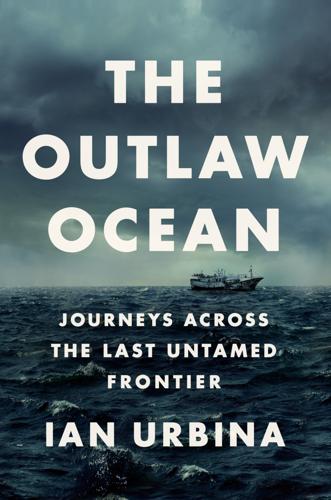
The Outlaw Ocean: Journeys Across the Last Untamed Frontier
by
Ian Urbina
Published 19 Aug 2019
Many scientists do not share George’s enthusiasm for the experiment, assailing it as unscientific, irresponsible, and a violation of international agreements meant to protect the oceans. Among George’s critics were fellow researchers in the geo-engineering field, who in the past had conducted smaller and sanctioned experiments with iron ore dumping, or “iron fertilization.” George’s experiments and those of more circumspect, cautious geo-engineers have the same scientific roots. Iron is a trace element necessary for photosynthesis in all plants. It is highly insoluble in seawater and an essential nutrient for phytoplankton growth. Little research had been done on the idea of ocean fertilization until the 1980s, when the oceanographer John Martin published his findings, arguing that a scarcity of iron micronutrients was limiting phytoplankton growth and overall productivity in the ocean’s most “desolate” regions.
…
If the bloom was eaten by the salmon and other fish, they would reemit the captured carbon dioxide as waste, sending it back into the atmosphere and canceling out the climate-change benefits, they said. Before and since, there was not much that anyone could do to stop George or others like him. He operated mostly in secret, and for what it was worth he had been granted permission by the local Native governing councils nearest to the dumping grounds. The international agreements relating to geo-engineering were nonbinding and unenforceable. After news of his experiment became public, government responses were mixed. The Spanish and Ecuadoran governments barred George’s vessels from their ports. The U.S. Environmental Protection Agency warned him that flying a U.S. flag on vessels used in such experiments would violate U.S. laws.
…
Corbett, an expert on maritime pollution who is based at the University of Delaware. It’s also known for another reason: Thomas Fuller and International Herald Tribune, “20 Kidnapped from Malaysian Resort Island,” New York Times, April 25, 2000. If the bloom was eaten: The experiment in 2012 was not George’s first foray into geo-engineering. As chief executive of a company called Planktos, he had proposed in 2007 a similar iron-fertilization project in the equatorial Pacific west of the Galápagos Islands, with the hope of selling carbon offsets. The project was canceled in 2008 after what George’s company called a “disinformation campaign” by environmentalists and others who made it impossible to attract investors.

The Collapse of Western Civilization: A View From the Future
by
Naomi Oreskes
and
Erik M. Conway
Published 30 Jun 2014
greenhouse gases Gases—such as water vapor, carbon dioxide, methane, nitrous oxide, and others—that trap infrared radiation and therefore heat the Earth above the temperature that would prevail in their absence. human adaptive optimism (1) The belief that there are no limits to human adaptability—that we can either adapt to any circumstances, or change them to suit ourselves. Belief in geoengineering as a climate “solution” was a sub-set of HAO. (2) The capacity of humans to remain optimistic and adapt to changed circumstances, even in the face of daunting difficulties, and even if the form of “adaptation” required is suffering. L e x i c o n o f A r c h A i c T e r m s 59 invisible hand A form of magical thinking, popularized in the eighteenth century, that economic markets in a capitalist system were “balanced” by the actions of an unseen, immaterial power, which both ensured that markets functioned efficiently and that they would address human needs.

New Dark Age: Technology and the End of the Future
by
James Bridle
Published 18 Jun 2018
It’s becoming a familiar conversation. Go on YouTube and you can find countless videos detailing, often in anger, the changing nature of the skies, and the aircraft producing such changes. Many of my web searches for the aircraft logging mobile phone calls lead me not to accounts of surveillance, but of covert geo-engineering: the use of planes to control the atmosphere with chemical sprays. Something strange is afoot. In the hyper-connected, data-deluged present, schisms emerge in mass perception. We’re all looking at the same skies, but we’re seeing different things. Where I see covert deportations and secret surveillance planes – supported by flight logs and ADS-B data, newspaper reports and Freedom of Information requests – others see a global conspiracy to doctor the atmosphere, to control minds, to enslave populations, or to reengineer the climate for naive or nefarious purposes.
…
The chemicals used cause cancer, Alzheimer’s, skin diseases and deformities. Global warming itself might be a lie, or a plot by shadowy forces to take over the world. Others believe the chemicals are intended to turn people into mindless drones, or to make them sick in order to profit the pharmaceutical industry. Covert geo-engineering, climate denialism, and the new world order meet in the churn of online misinformation, user-submitted videos, claims and debunkings, and contagious distrust. Chemtrails become the vortex of other conspiracies, pulling everything into their orbit. ‘Take Ur Power Back: Vote to leave the EU’ exhorts one YouTuber, with the perhaps unsurprising username of Flat Earth Addict, over a montage of blue suburban skies criss-crossed with contrails.8 In this telling, covert climate engineering is a project of the European Union to suppress the will of the people.
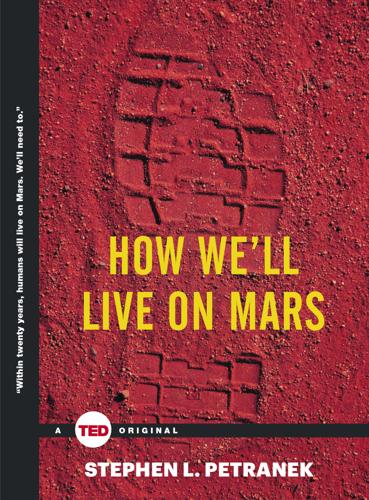
How We'll Live on Mars (TED Books)
by
Stephen Petranek
Published 6 Jul 2015
Some economies flourished; others were destroyed. And every person’s view of what the world was expanded, contracted, and multiplied. A voyage to Mars will make the Age of Discovery look like a minuscule event in human history. Our world will suddenly encompass an entire solar system instead of one planet. Our abilities to geoengineer something as large as a planet will flourish. Trade routes that would have seemed impossible to previous generations will be established. The Earth will gain metals it desperately needs and the technical knowledge to very possibly save its environment. Opportunity for a new life elsewhere will give hope to millions.
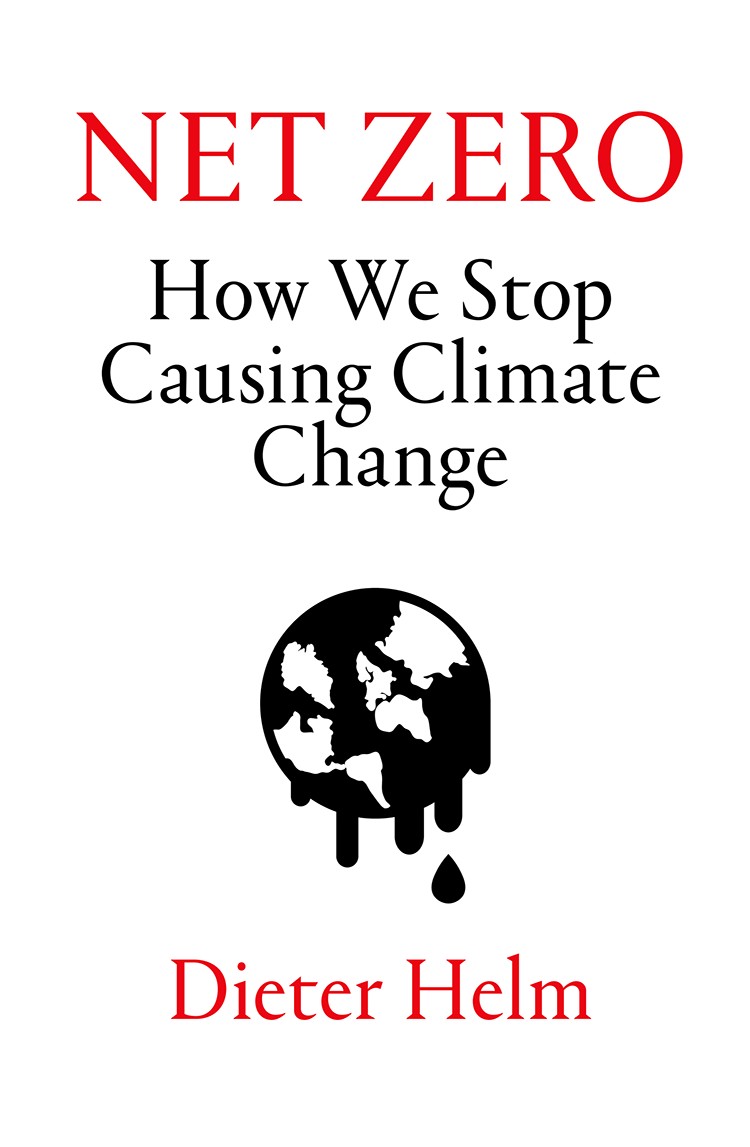
Net Zero: How We Stop Causing Climate Change
by
Dieter Helm
Published 2 Sep 2020
The polluting aspects of farmed animals might be modified, and in particular their methane-producing characteristics may be altered. Plants could be modified to be better at sequestrating carbon as well as being used to produce new foods that replicate the proteins and other benefits of meat.[12] All this, and higher crop yields too. This may be much more successful and on a larger scale than some of the geoengineering proposals being developed to try to head off major climate change, should it materialise. The science cannot be put back in the box, and existing technologies cannot produce enough food for the bigger global populations. There will be 10 billion people to feed while also reaching net zero. It is not, and cannot be, one or the other.
…
acid rain 25, 194 Africa xiv, xv, 2, 25, 30, 38, 44, 45, 47, 48, 51, 137, 229 agriculture 2, 6, 12, 13, 14, 23, 35–6, 43, 44–5, 70, 76, 86, 87–8, 95, 100, 102, 109, 116, 146–7, 149, 159, 163–80, 181, 183, 192, 197, 198, 206, 220 baseline, the 164–8 biodiversity loss and 2, 5, 100, 164, 165, 168, 169, 171, 172, 174, 180 biofuels and 197–8 carbon emissions and 2, 12, 13, 35–6, 76–7, 146–7, 163–80 carbon price and 167–70, 171, 172, 173, 180 China and 28–9, 35, 45, 180 economics of 76, 165, 166–7, 171, 174 electricity and 13, 166, 168, 174, 178, 180 fertiliser use see fertiliser lobby 14, 110, 164, 165, 169, 170, 197 methane emissions 23, 84, 177, 178, 179 net gain and 172–4 net value of UK 76, 166 new technologies/indoor farming 87–8, 174–9, 180, 213 peat bogs and 2, 179 pesticide use see pesticides petrochemicals and 166 polluter-pays principle and 76, 168–70, 172, 173 pollution 36, 86, 163, 165–6, 168–70, 172, 173, 177–8, 230 public goods, agricultural 170–4, 180 sequestering carbon and 12, 95, 163, 166, 168, 169, 170, 171, 172, 173–4, 177, 179, 180 soils and 2, 146, 163, 164, 165, 166, 168, 169, 171, 172, 175, 179 subsidies 14, 76, 102, 109, 116, 164, 165, 166, 167, 169, 170, 172, 180, 228 25 Year Plan and 179–80 Agriculture Bill (2018), UK 170 air conditioning 135–6, 224, 233 air quality xiii, 13, 25, 46, 52, 61, 70, 135, 153, 177, 180, 201, 216, 230, 232 air transport 3–4, 6, 11, 13, 22, 50, 53, 73, 87, 88, 92, 107, 125, 128, 129, 132, 133, 134, 149, 156–7, 186, 195, 201, 203–5 aluminium 7, 117 Amazon rainforest 2, 34, 35, 95, 145, 149–50, 151, 155, 229, 230 ammonia 35, 137, 191 anaerobic digesters 35, 165, 230 animal welfare 167, 177 antibiotics 93, 165, 174 Arctic 26, 46, 114, 178 artificial intelligence (AI) 32, 175, 220, 231 autonomous vehicles 13, 129, 132, 175, 189–90, 231 Balkans 137–8 Bank of England 121 batteries 6, 31, 131, 135, 141, 183, 184, 185–90, 191, 199, 204, 213, 214, 219, 220, 221, 225, 231 beef 5, 95, 116, 117, 167, 230 Berlin, Isaiah 104 big 5 polluter products 117–18, 120 bin Salman, Mohammad 27 biocrops 36 biodiversity xiv, 2, 5, 12, 13, 28, 35, 51, 76, 94, 100, 148, 149, 152, 153, 158, 159, 164, 165, 168, 169–70, 171, 172, 174, 180, 227, 233 bioenergy 31, 34–5, 36 biofuels 21, 35, 49, 50, 67, 70, 95, 135, 183, 184, 197–8, 210, 230 biomass 32, 34, 49, 50, 67, 69, 109, 146, 147, 151, 210, 217 bonds, government 220 BP 27, 149, 187, 199 Deepwater Horizon disaster, Gulf of Mexico (2010) 147 Brazil 2, 35, 38, 44–5, 47, 95, 145, 149–50, 155, 198 Brexit 42, 47, 56, 117, 165 British Gas 102, 139 British Steel x, 194 broadband networks 6, 11, 90, 92, 125, 126, 127–8, 130–1, 132–3, 135, 140–1, 199, 201, 202, 205, 211, 214, 231, 232 Brundtland Commission 45 BT 127–8, 141 Openreach 214 Burn Out (Helm) ix, xiv Bush, George W. 36, 48, 53, 103 business rates 76, 165 Canada 52, 191, 193 capitalist model 26, 42, 99, 227 carbon border tax/carbon border adjustment xii, 11, 13, 60, 80, 115–20, 194–6, 204 carbon capture and storage (CCS) xiv, 12, 75–6, 95, 109, 146, 147–8, 149, 154, 159, 203–4, 207, 209, 222, 223 Carbon Crunch, The (Helm) ix, xiv, 221 carbon diary 4–5, 8, 10, 11, 64–6, 83, 86, 116, 143, 144, 155, 156, 167, 180, 181, 185, 203, 205 carbon emissions: agriculture and see agriculture by country (2015) 30 during ice ages and warm periods for the past 800,000 years 21 economy and 81–159 electricity and see electricity global annual mean concentration of CO2 (ppm) 19 global average long-term concentration of CO2 (ppm) 20 measuring 43–6 since 1990 1–14, 17–37 transport and see individual method of transport 2020, position in 36–7 UN treaties and 38–57 unilateralism and 58–80 see also unilateralism carbon offsetting xiii–xiv, 4, 5, 12, 34, 45, 72, 74, 79, 94–6, 97, 105, 143–59, 192, 201, 203, 207, 214, 222, 223, 234 for companies 148–50 for countries 151–5 for individuals 155–7 markets 71–2, 110–13, 117, 144, 157–9, 208 travel and 156, 201–3 see also sequestration carbon permits 71–2, 79, 110–13, 117, 144, 208 carbon price/tax xii, xiii, xv, 8, 11, 12, 13, 26, 60, 61, 71, 72, 77, 79, 80, 84, 85–6, 102–3, 105, 106–24, 134, 143, 146, 147, 150, 151–4, 157, 159, 192, 197, 198, 199, 203, 227–30, 232, 234 agriculture and 167, 168, 169–70, 171, 173, 180 domain of the tax/carbon border adjustment xii, 11, 13, 60, 80, 115–20, 121, 124, 192, 194–6, 197, 204, 227 electric pollution and 216–18 ethics of 107–10 floor price 115, 117, 208 for imports 11, 13 prices or quantities/EU ETS versus carbon taxes 110–13 setting 113–15 transport and 192–9 what to do with the money 121–4 where to levy the tax 119–20 who fixes the price 120–1 carbon sinks 2, 5, 166, 169, 203 carboniferous age 34 cars 1, 3, 4, 7, 20, 22, 36, 44, 70, 73, 114, 129, 181, 182, 183, 184–5, 190, 191, 193, 196, 197, 198, 199 see also electric vehicles cartels 39, 40, 43, 45, 46, 47, 56 cattle farming 35, 36, 95, 150, 166, 167, 173, 177, 198 Central Electricity Generating Board (CEGB) 102, 139, 218 cement 6, 7, 26, 29, 34, 87, 117, 171 charging networks, electric vehicle 91, 129–30, 141–2, 184, 185–90, 199, 200, 202, 219 Chernobyl 78 China xi, xv, 1–2, 5, 8, 18, 42, 46, 47, 48, 64, 66, 74, 101, 180, 229 Belt and Road Initiative 28, 45 coal use 1–2, 8, 23–4, 24, 28, 31, 38, 117, 154, 206, 208 Communist Party 2, 27, 42, 46 demand for fossil fuels/carbon emissions 1–2, 8, 18, 20, 22, 23–4, 24, 25, 27–31, 36, 38, 51, 73, 117, 154, 206, 208 export market x–xi, 5, 9, 64, 66, 117, 155, 194 fertiliser use 35 GDP xv, 27, 29 nationalism and 42 petrochemical demand 22 renewables companies 9, 32, 73, 74, 77, 79 Tiananmen Square 42 unilateralism and 58, 59 UN treaties and 46, 47, 48, 53, 54, 55, 58, 59 US trade war 56, 118 Churchill, Winston 183 citizen assemblies 99–101 climate change: carbon emissions and see carbon emissions 1.5° target 38, 57 2° target 1, 10, 22–3, 28, 30, 38, 39, 45, 47, 54, 55, 57, 108, 122, 155, 206 see also individual area of climate change Climate Change Act (2008) 66, 74–7 Clinton, Bill 40, 48 Club of Rome 98 coal 1–2, 5, 8, 13, 20, 23–5, 28, 29, 30, 31, 32, 34, 36, 38, 50, 52, 53, 60–1, 67, 72, 77, 78–9, 101, 109, 112, 116, 117, 119, 134, 136, 145, 147, 148, 151, 154, 155, 182, 183, 194, 196, 206–9, 210, 212, 214, 216, 217, 218, 229, 230 coastal marshes 146, 159 colonialism 45 Committee on Climate Change (CCC), UK x–xi, 7, 74–5, 120, 164, 166, 169, 217, 235 ‘Net Zero: The UK’s Contribution to Stopping Global Warming’ report x–xi conference/video calls 6, 129, 156, 202, 205 Conference of the Parties (COP) xii, 10, 48, 50, 53–4, 55, 59, 205 congestion charges 198 Copenhagen Accord 48, 53–4, 59 Coronavirus see Covid-19 cost-benefit analysis (CBA) 71, 108, 110, 114, 138 cost of living 116 Covid-19 x, xi–xii, 1, 3, 6, 9, 18, 19, 22, 25, 27, 30, 37, 44, 46, 50, 57, 65, 69, 80, 89, 93, 129, 135, 148, 171, 201, 202, 204, 232 CRISPR 176 crop yields 172, 177 dams 2, 36, 52–3, 179 DDT (Dichlorodiphenyltrichloroethane) 100 deforestation 2, 5, 34, 35, 36, 38, 43, 44, 47, 55, 87, 95, 145, 146, 149–50, 155, 172–3, 179, 197–8, 229 Defra (Department for Environment, Food and Rural Affairs) 170 deindustrialisation x, 29, 46, 52, 54, 59, 72–4, 218 Deng Xiaoping 27 Denmark 69–70, 136–7 desalination 135–6, 179 diesel 4, 20–1, 70, 76, 86, 109, 119, 121, 129, 132, 164, 165, 166, 174, 175, 178, 179, 181, 182, 185, 186, 191, 192, 196–7, 208, 217, 230 ‘dieselgate’ scandal 196–7 digitalisation 1, 8, 11, 13, 33, 92, 117, 136, 174, 175, 180, 206, 211, 215, 221, 228–9, 231 DONG 69 Drax 147, 151, 154, 218 economy, net zero 10–12, 81–159 delivering a 96–103 intergenerational equity and 96–7 markets and 103–5 net environmental gain see net environmental gain political ideologies and 98–101 polluter-pays principle see polluter-pays principle public goods, provision of see public goods, provision of technological change and 98 EDF 139, 218 Ehrlich, Paul 98 electricity 1–2, 4, 6, 11, 12, 13, 23, 31, 32, 49, 53, 61, 65, 66, 68, 70, 73, 77, 78, 79, 91, 92, 101, 102, 109, 117, 125, 127, 128, 129–30, 131–2, 134, 135, 136, 137, 139, 140, 141, 149, 158, 166, 168, 174, 178, 180, 182, 183, 228, 229, 231, 232, 234, 235 coal, getting out of 206–7 electric pollution and the carbon price 216–18 electric vehicles 4, 6, 13, 20, 23, 49, 61, 91, 92, 94, 121, 125, 128, 129–30, 131–2, 134, 141, 183–92, 193, 194, 197, 200, 201, 202, 206, 219, 228 equivalent firm power auctions and system operators 210–16 future of 206–25 gas, how to get out of 207–9 infrastructure, electric 185–90, 218–20 low-carbon options post-coal and gas 209–10 net gain and our consumption 222–5 R&D and next-generation renewables 220–2 renewable see renewables Energy Market Reform (EMR) 219 equivalent firm power (EFP) 212–16, 217, 220 ethanol 35, 71, 95, 197 eucalyptus trees xiv, 152 European Commission 60, 71, 72, 112 European Union (EU) xiv, 2, 7, 8, 9, 37, 42, 44, 46, 47, 117, 137, 165, 166, 197; baseline of 1990 and 51–2 Common Agricultural Policy (CAP) 76, 165 competition regime and customs union 56 deindustrialisation and 46, 52, 54, 59, 72–4 directives for 2030 66 Emissions Trading System (EU ETS) 71–2, 73, 79, 110–13, 117, 144, 208 importing carbon emissions 59 Internal Energy Market (IEM) 68, 71 Kyoto and 9, 51, 59, 66–7 Mercosur Agreement 44, 95 net zero target for 2050 66, 115, 143, 155, 167, 180 Paris and 54 Renewable Energy Directive 68–71, 73, 109 2020 targets signed into law 66 2020–20–20 targets 67, 69, 74 unilateralism and 59, 66–71, 80 Eurostar 133 externalities 104, 170, 180, 196 Extinction Rebellion 6 farmers 14, 26, 35, 36, 43, 71, 76, 86, 95, 102, 109, 110, 146–7, 164, 165, 166, 169, 170, 174, 175, 196, 197, 198 fertiliser 4, 6, 7, 26, 29, 35, 61, 73, 86, 87, 116, 117, 119, 163, 165, 169, 174, 175, 178, 179, 191, 194, 197 fibre/broadband networks 6, 11, 90, 92, 125, 126, 127–8, 130–1, 132–3, 135, 140–1, 201, 202, 205, 211, 214, 231, 232 financial crisis (2007/8) 1, 19, 69 first-mover advantage 75 First Utility 199 flooding 13, 77, 149, 152, 153, 159, 170, 233 food miles 167 food security 170–1 food waste 178, 180, 231 Forestry Commission xiv Formula One 186, 196 fossil fuels, golden age of 20–5 see also individual fossil fuel France 46, 47, 52, 56, 73, 78, 101, 113, 130, 136, 138 free-rider problem 39–40, 43, 62–4, 106, 119 fuel duty 121, 195–6 fuel efficiency 197 fuel prices 26, 112–13, 209 fuel use declaration 195 Fukushima Daiichi nuclear disaster (2011) 52, 78 Fukuyama, Francis: The End of History and the Last Man 40–1 gardens 6, 43, 143, 156 gas, natural ix, 2, 5, 8, 20, 23, 24, 25, 26, 29, 31, 32, 36, 50, 52, 68, 69, 79, 102, 109, 117, 119, 129, 136, 137, 146, 147–8, 149, 183, 190, 193, 194, 207–9, 210, 211, 214, 216–17 G8 47 gene editing 172, 176, 231 general election (2019) 121 genetics 98, 172, 174–6, 231 geoengineering 177 geothermal power 137, 178 Germany 9, 30, 47, 52, 59, 60, 62, 66, 67, 69, 70, 71, 72, 73, 75, 77–80, 83, 91, 101, 112, 136, 137, 138, 144, 206, 208, 209 Energiewende (planned transition to a low-carbon, nuclear-free economy) 59, 69, 77–80, 112, 144, 208 Gilets Jaunes 101, 113 GMOs (genetically modified organisms) 176, 177 Great Northern Forest, Britain 151 Green and Prosperous Land (Helm) xiii, xiv, 165, 169, 234 greenbelt 173 greenhouse effect 17 green new deal 90, 102, 234 green parties/green votes 69, 77, 78 green QE (quantitative easing) 102–3 green walls 153, 231 greenwash 156 gross domestic product (GDP) xii, xv, 1, 25, 27, 29, 41, 57, 59, 73, 76, 83, 93, 98, 103, 133, 165, 207, 227, 229, 233 growth nodes 133 G7 47 G20 47 Haber-Bosch process 35, 163 Hamilton, Lewis 186 ‘hands-free’ fields 175 Harry, Prince 6 Heathrow 133, 134 hedgerow 76, 166, 167, 172 Helm Review (‘The Cost of Energy Review’) (2017) ix, 120, 141, 200, 210, 212, 215, 217, 220, 238 herbicide 163 home insulation 102 House of Lords 170 housing 101, 223–4 HS2 92, 125, 132–4, 138, 202 Hume, David 49 hydrogen 13, 49, 92, 125, 128, 135, 137, 183, 184, 190–2, 199, 200, 204, 206, 213, 228 hydro power 31, 35, 36, 50, 52–3, 70, 136, 137, 191 Iceland 137, 178 imports x–xi, xiii, 5, 8, 10, 11, 12, 13, 62, 68, 70, 117–18, 155, 167, 178, 173, 180, 196, 227 income effect 72, 111 income tax 121, 122, 232 India xiv, xv, 25, 30, 31, 38, 43, 44, 47, 48, 51, 54, 55, 57, 154, 229 individuals, net zero for 155–7 Indonesia 2, 35 indoor farming 87–8, 177–8, 180, 213 indoor pollutants 223, 232 Industrial Revolution 1, 18, 19, 25, 47, 116, 145 INEOS Grangemouth petrochemical plant xi information and communications technology (ICT) 117, 202, 231 infrastructures, low-carbon xiii, xiv, 11–12, 14, 28, 60, 62, 65, 66, 90, 91–4, 96, 105, 109, 123, 125–42, 143, 147, 151, 154, 159, 171, 184, 186, 187, 190, 199–200, 214, 218–20, 228, 230, 231–2, 234–5 centrality of infrastructure networks 128–30 electric 125–41, 218–20 making it happen 141–2 net zero national infrastructure plan 130–6 private markets and 125–8, 141–2 regional and global infrastructure plan 136–7 state intervention and 126, 127–8, 141–2 system operators and implementing the plans 138–41 inheritance tax 76, 165 insects 164, 177, 231 insulation 102, 224 Integrated Assessment Models 114 intellectual property (IP) 75 Intergovernmental Panel on Climate Change (IPCC) 17–18, 47, 55, 57, 108, 172 internal combustion engine 13, 22, 181–2, 183, 184, 200, 221, 228 Internal Energy Market (IEM) 68, 71, 138 International Energy Agency (IEA) 25, 207 International Monetary Fund (IMF) 51 internet banking 131, 213 internet-of-things 128, 175 Iran 27, 42, 113, 137 Iraq 56, 192 Ireland 43, 157 Italy 137, 182 Japan 27, 28, 30, 52, 73, 78, 101, 185 Jevons Paradox 224 Johnson, Boris 89–90 Kant, Immanuel 104 Keynes, John Maynard 89, 102, 103, 105 Kyoto Protocol (1997) xii, 2, 7, 9, 13, 17–18, 37, 38, 39, 40–1, 47–8, 49, 51, 52–3, 59, 66–7, 119 laissez-faire 104, 138, 188 land use 35, 61, 95, 172, 237 LED (light-emitting diode) lighting 87, 178, 179, 180, 213 liquefied natural gas (LNG) 136, 183 lithium-ion battery 185 lobbying 10, 14, 33, 69, 71, 109, 110, 111–12, 115, 121, 157, 169, 170, 187, 197, 209, 223, 227, 228 location-specific taxes 194 maize 35, 165, 197 Malaysia 2, 229 Malthus, Thomas 98 Mao, Chairman 27, 42 meat xi, 65, 164, 177, 180, 232 Mekong River 2, 28, 179, 229 Mercosur Agreement 44, 95 Merkel, Angela 78 methane 4, 23, 84, 177, 178, 179, 216 microplastics 22 miracle solution 49–50, 55, 209 mobile phone 5, 125, 185 National Farmers’ Union (NFU) 110, 164, 165, 169, 170, 171 National Grid 139, 141, 189, 200, 211, 214, 219 nationalisations 101–2, 126–7 nationalism 41, 43, 55, 56, 138 nationally determined contributions (NDCs) 54–5 natural capital xiii, 14, 33–6, 51, 85, 86, 88, 90, 94, 97, 154, 158, 168, 171, 173–4, 236 Nature Fund 123, 169, 234 net environmental gain principle xiii, xiv, 10, 12, 62, 84, 94–6, 105, 143–59, 169, 172–4, 192, 201–3, 222–5 agriculture and 169, 172–4 carbon offsetting and see carbon offsetting electricity and 222–5 principle of 94–6, 143–4 sequestration and see sequestration transport and 192, 201–3 Netherlands 138 Network Rail 214 net zero agriculture and see agriculture defined x–xv, 3–14 economy 10–12, 81–159 see also economy, net zero electricity and see electricity transport and see individual method of transport 2025 or 2030 target 89 2050 target x, xi, 5, 59, 66, 74, 75, 115, 120, 135, 143, 155, 167, 169, 180, 184, 216, 217, 222, 226, 230, 231, 232 unilateralism and see unilateralism NHS 65 non-excludable 91, 93, 126, 170 non-rivalry 91, 93, 126, 170 North Korea 42 North Sea oil/gas 9, 40, 75, 97, 102, 137, 139, 147, 148, 193 Norway 130, 137, 191 nuclear power 5, 9, 12, 18, 23, 52, 60, 73, 77–9, 109, 125, 128, 129, 136, 140, 178, 194, 199, 206, 207, 208, 209–10, 212, 214, 216, 218, 219, 222, 228 Obama, Barack 48, 53, 54, 59 oceans 2, 14, 22, 33, 85, 86, 88, 148, 163, 231 offsetting see carbon offsetting offshore wind power 31, 69, 75–6, 208, 212, 219, 221 Ofgem 220 oil ix, 2, 20, 22–3, 25, 26, 27, 31, 32, 33, 36, 39, 40, 50, 67, 69, 86, 97, 117, 119, 129, 136, 137, 146, 147, 148–9, 150–1, 152, 181–3, 184, 185, 187, 189, 190, 192–4, 196, 197, 199, 206, 209, 210, 216–17, 229 OPEC 39, 40, 193 Orbán, Viktor 41, 42 organic food 61, 87, 178 Ørsted 70 palm oil 2, 5, 6, 35, 36, 66, 71, 167, 173, 197–8, 230 pandemic see Covid-19 Paris Climate Change Agreement (2015) xii, 2, 10, 13, 18, 30, 37, 38, 39, 48, 49, 54–5, 56, 57, 58, 66, 80, 105, 106, 118, 119, 227 peat bogs xiv, 2, 13, 14, 33, 35, 36, 43, 109, 146, 169, 179 pesticides 4, 26, 61, 163, 165, 169, 174, 178, 231 petrochemicals xi, 7, 8, 20, 22–3, 29, 73, 80, 86, 117, 166, 182 petrol 4, 86, 119, 121, 129, 185, 186, 187, 191, 192, 199 photosynthesis 34, 197 plastics 1, 22, 28, 35, 43, 66, 86, 87, 119, 143, 166, 184, 231 polluter-pays principle xiii, xv, 84–90 agriculture and 76, 168–70, 172, 173 carbon price and see carbon price/tax generalised across all sources of pollution 86 identifying polluters that should pay 86 importance of 10–11, 13, 61, 62, 65 intergenerational balance and 96–7 net environmental gain and 94 sequestration and see sequestration, carbon sustainable economy and 96–7, 105, 106 transport and 192–5, 198–9 see also individual type of pollution population growth 93, 97, 177, 178, 179, 232 privatisation 127, 140, 218–19, 220 property developers 94 public goods, provision of xiii, 10, 11–12, 62, 75, 84, 90–4, 96, 104, 105, 109, 122, 123, 126, 128, 141, 147, 151, 153, 159, 164, 168, 173–4, 180, 192, 199–200, 202, 218, 229, 230 agricultural 170–4, 180 low-carbon infrastructures see infrastructures, low-carbon research and development (R&D) see research and development (R&D) Putin, Vladimir 27, 41, 42, 89 railways 11, 13, 13, 87, 91, 92, 94, 125, 128, 129, 130, 131, 132–3, 138, 139, 156, 182, 183, 187, 202, 212, 214, 232 rainforest 2, 5, 34, 35, 36, 38, 44, 47, 55, 87, 95, 145, 149, 155, 173, 179–80, 197, 229 rationalism 40–1 Reagan, Ronald 103 red diesel 76, 109, 164, 165, 196 regulated asset base (RAB) 127, 141, 215, 220 remote working 128, 156, 201–2, 205 renewables ix, 6, 8, 9–10, 18, 19, 21, 26, 31–5, 36, 49, 50, 55, 61, 67, 72, 77, 79, 85, 86, 109, 110, 112, 123, 125, 128, 131, 135, 138, 140, 144, 149, 178, 188, 191, 194, 197, 199, 207, 209–10, 211, 212, 213, 214, 215, 216, 217, 219, 220–2, 224, 228 Chinese domination of market 9, 32, 73, 74, 77, 79 cost-competitiveness of 9–10, 49, 51, 61, 68 failure of, 1990-now 19, 31–3, 36 modern global renewable energy consumption measured in TWh per year 32 miracle solution and 49–51 Renewable Energy Directive 68–71, 73, 109 subsidies ix, 9, 10, 50, 68–9, 71, 79, 80 see also individual renewable energy source Renewables UK 110 research and development (R&D) xiv, 12, 13, 14, 62, 65, 66, 90, 93–4, 104, 109, 123, 165, 172, 192, 200, 218, 220–2, 223, 228, 234 reshoring businesses 8, 204 rivers 2, 22, 28, 86, 128, 152, 165, 169, 179, 214, 230 roads 11, 28, 45, 91, 92, 125, 129, 131–2, 140, 165, 182, 189, 194, 198, 202, 232 robotics 32, 175, 204, 206, 231 Rosneft 26 Royal Navy 183 Russia 26, 27, 30, 40, 42, 44, 45, 46, 47, 48, 50, 52, 55, 56, 192, 193 RWE 139, 218 Ryanair 156–7 rye grass 35 salmon 169, 177 Saudi Arabia 26, 33, 40, 42, 50, 137, 192, 193 Saudi Aramco 26, 50 seashells 34 sequestration, carbon xi, xiv, 12, 61, 66, 85, 90, 95, 143–59, 228, 229, 231, 232 agriculture and 12, 163, 166, 168, 169, 170, 171, 172, 173, 176–7, 179, 180 baseline definition and 146–7 biofuels and 35, 146, 217 carbon capture and storage (CCS) xiv, 12, 75–6, 95, 109, 146, 147–8, 149, 154, 159, 203–4, 207, 209, 222, 223 companies, net zero for 148–51 countries, offsetting for 151–5 electricity and 222, 223 gas and 207 individuals, net zero for xi, xiv, 155–7 markets, offsetting 157–9 natural capital destruction and 2, 19, 33–6, 44, 45, 51 natural sequestration xi, xiii, 2, 7, 12, 14, 33–6, 37, 45, 52, 66, 85, 90, 94–6, 105, 143–59, 163, 168, 171, 173, 176–7, 179, 180, 203, 206, 207, 222, 223 net gain principle and 143–4, 146, 149–50 offsetting principle and 143–5 peat bogs and see peat bogs principle of xi, xiii, 2, 7, 12–13 soils and see soils transport and 185, 190, 203 tree planting and see trees, planting/sequestration and types of 145–8 wetlands/coastal marshes and 146, 159, 233 shale gas 8, 208 Shell 27, 149, 199 shipping 8, 13, 22, 28, 36, 49, 114, 125, 137, 181, 182–3, 191, 194–5, 203–5, 217 Siberia 2, 46 smart appliances 128, 129, 132 smart charging 11, 13, 128, 129, 130, 139, 214, 219 soils xiii, 2, 5, 7, 12, 14, 33, 35, 36, 43, 55, 76, 109, 146, 149, 152, 156, 159, 163, 164, 165, 166, 168, 169, 171, 172, 175, 179, 203, 228 solar panels/solar photovoltaics (PV) 5, 6, 9, 12, 13, 21, 31, 32, 33, 49, 53, 68, 69, 71, 74, 79, 87, 91, 135, 136, 137, 178, 179, 188, 204, 207, 208, 209, 210, 211, 213, 214, 216, 217, 221, 222, 223, 224–5 Sony 185 Soviet Union 18, 40, 52, 67–8, 89 soya 95 Spain 69, 130, 137 sport utility vehicles (SUVs) 106, 121, 192 spruce xiv, 152, 170 standard of living xv, 1, 5, 8, 10, 11, 14, 229, 233 staycations 201 steel x–xi, 6, 7, 8, 26, 28, 29, 53, 66, 73, 80, 87, 116, 117, 118, 119, 171, 184, 194–5 Stern, Nicholas: The Economics of Climate Change 41, 63 subsidies ix, 9, 10, 14, 32, 50, 51, 52, 53, 69, 71, 76, 79, 80, 89, 102, 109, 110, 113, 116, 123, 140, 154, 164, 165, 166, 167, 169, 170, 172, 180, 193, 196, 198, 209, 215, 221, 222, 228, 230 sugar cane 35, 71, 95, 197, 198 sulphur pollution 22, 25, 28, 78, 191, 194, 197, 230 sustainable economic growth xv, 10, 12, 14, 61, 83, 92, 94, 97, 98, 105, 227, 233 Taiwan 42 taxation xii, 11, 62, 71, 72, 76, 80, 87, 89, 90, 91, 92, 97, 101, 102, 103, 106–24, 126, 127, 130, 133, 147, 150, 151–2, 153–4, 157, 159, 165, 169, 170, 192–6, 197, 198, 199, 203, 232, 234 technological change 98, 127, 141, 174–5, 221 Thatcher, Margaret 17 Thompson, Emma 6 3D printing 175, 204 Thunberg, Greta 6, 205 tidal shocks 159 top-down treaty frameworks 13, 38–57, 80, 110, 119 tourism/holidays 6, 22, 36, 88, 94, 107, 114, 128, 156, 201, 204–5 transport, reinventing 181–205 aviation 195, 201, 203–5 see also air transport batteries and charging networks 185–90 biofuels 196–8 electric alternative 183–5 hydrogen and fuel cells 190–2 innovation, R&D and new infrastructures 199–200 internal combustion engine 181–2 net gain and offsets (reducing travel versus buying out your pollution) 201–3 oil 183–4 polluter pays/carbon tax 192–6 shipping 203–5 urban regulation and planning 198–9 vehicle standards 196–8 see also individual type of transport Treasury, UK 120–2 trees, planting/sequestration and xi, xiii, xiv, 2, 7, 13, 14, 33, 34, 45, 76, 85, 94–6, 146, 148, 149–51, 152–3, 155, 156, 157, 158, 159, 168, 169, 172, 179, 203, 231 trophy project syndrome 133 Trump, Donald 2, 8, 41, 42, 48, 89, 99, 103, 121 25 Year Environment Plan xiii, 153, 170, 179–80 UK 47, 69 agriculture and 164, 166, 167, 173 carbon emissions (2015) 30 carbon price and 115, 120 Climate Change Act (2008) 66, 74–7 coal, phasing out of 24–5, 60–1, 77, 208 Committee on Climate Change (CCC) x–xi, 7, 74–6, 120, 164, 166, 169, 217, 235 deindustrialisation and 72–4 80 per cent carbon reduction target by 2050 74 electricity and 206, 208, 218, 219, 224 Helm Review (‘The Cost of Energy Review’) (2017) ix, 120, 141, 200, 210, 212, 215, 217, 220, 238 infrastructure 125, 132–3, 134, 137, 139–40 net zero passed into law (2019) 66 sequestration and 145, 150, 153, 154, 155, 156 transport and 195–6, 197, 198 unilateralism and 58–9, 60–1, 65, 66, 69, 72–7, 80 unilateralism xi, 8, 10, 11, 25, 58–80, 83, 105, 106, 119, 125, 143, 144, 155, 164, 167, 197, 203, 227 in Europe 66–80 incentive problem and 58–60 morality and 62–6 no regrets exemplars and/showcase examples of how decarbonisation can be achieved 60–2 place for 80 way forward and 80, 83 United Nations xi, xii, 6, 10, 17, 37, 38, 118 carbon cartel, ambition to create a 39–40, 43, 45, 46–7, 56 climate treaty processes xi, 6, 10, 13, 17–18, 36, 37, 38–57, 59, 80, 110, 118, 119, 204–5 see also individual treaty name Framework Convention on Climate Change (UNFCCC) 17–18, 36, 38, 59 miracle solution and 50–1 origins and philosophy of 41 Security Council 46, 47, 57 United States 8, 74, 139, 206 agriculture in 175, 176, 197 carbon emissions 8, 29, 30 China and 27–8, 42, 118 coal and 2, 24, 28, 29, 208 economic imperialism 45 energy independence 50 gas and 8, 20, 23, 24, 29, 50, 208 oil production 40, 50, 193 pollution since 1990 29 unilateralism and 58, 59, 74 UN climate treaty process and 38, 40–1, 44, 45, 46, 47, 48, 53, 54, 56 universal service obligations (USOs) 92, 126, 131, 202 utilitarianism 41, 63–4, 108, 110 VAT 117, 119–20, 121, 122, 232 Vesta 69 Volkswagen 196–7 water companies 76, 214, 230 water pollution/quality xiv, 12, 22, 61, 76, 152, 153, 165, 169, 170, 171, 172, 175, 177, 178, 179, 180, 232 Wen Jiabao 53, 59 wetlands 159, 233 wildflower meadow 164, 184 wind power 5, 9, 12, 21, 31, 32, 33, 49, 53, 68, 69–70, 71, 74, 75, 76, 78, 79, 91, 135, 136, 137, 138, 139, 178, 188, 191, 207, 208, 209, 210, 211, 212, 213, 214–15, 216, 217, 219, 221, 222 wood pellets 67, 217, 230 Woodland Trust 156, 158 World Bank 51 World Trade Organization (WTO) 52, 56, 118 World War I 183 World War II (1939–45) 78, 90, 92, 101, 106, 171 Xi Jinping 27, 41, 42 ACKNOWLEDGEMENTS So much is now discussed, written and published about climate change that it is impossible to keep track of all the ideas and conversations that have influenced my understanding of the subject.

Green Swans: The Coming Boom in Regenerative Capitalism
by
John Elkington
Published 6 Apr 2020
Too many change agents, meanwhile, remain distracted by the task of driving incremental improvements in existing and incumbent technologies, ranging from gasoline-powered automobiles to energy- and chemical-intensive air-conditioning systems. All-important work, but we must now move well beyond that. We must engage and shape the thinking of those who will transform our future with such things as artificial intelligence, the internet of everything, autonomous vehicles, synthetic biology, and, some insist, geoengineering. Do not misunderstand me: This rapid evolution of technologies is exciting and has the potential to tackle many of the central challenges we face in this century, if properly used. In terms of potential upsides, I know from personal experience that a radically better future is already here, or taking shape fast.
…
Fascinating, essential work, but the task is expanding all the time as new technologies crowd into the public arena. Among next-generation technologies we have been watching are 3-D printing, AI, big (and little) data, drones, autonomous and electric cars, food technology (including synthetic meat and fish), fusion power, genomic medicine, geoengineering, the Internet of Things, mini-satellites, nanotechnology, new materials and sensors, smart buildings and infrastructures, soil carbon capture, synthetic biology, and vertical farming. As the OTA would have been quick to point out, such technologies will cross-pollinate in unexpected ways. Rather than simply observing such trends from the sidelines, the system change community must now proactively shape the next round of industrial revolutions.

The Rationalist's Guide to the Galaxy: Superintelligent AI and the Geeks Who Are Trying to Save Humanity's Future
by
Tom Chivers
Published 12 Jun 2019
He also points out that if things do start to look really bad, and ‘if we are literally and slowly threatened with extinction from climate change, then all of our efforts will be devoted to that. It won’t be like the current situation, where we’re unwilling to give 10 per cent of our GDP to deal with the problem. We’d spend like half on it.’ Ideas that seem crazy now, like geoengineering our planet or settling Mars, would become serious options. ‘It seems very unlikely to me that it’s going to be an extinction,’ he says. Ord, and Bostrom, both think that biotechnology – some genetically engineered virus – is a very realistic route to human extinction. ‘Synthetic biotech would be another source,’ says Bostrom, although he points out that it all depends very heavily on how you define and delineate ‘a risk’.
…
Mike Levine, OpenPhil’s head of comms, agreed that climate change, for instance, is not as neglected or as tractable as some other, similarly important, issues. ‘But I’d quibble with the idea that we don’t focus on it. We’ve funded the most important, neglected and tractable climate-change opportunities we’ve seen, including geoengineering research and governance and the especially tractable opportunity around the Montreal Protocol [to reduce the use of hydrofluorocarbons, a powerful greenhouse gas]. We’ve put millions of grant dollars into climate change – more than we have into our land-use reform, macroeconomic stabilisation, or immigration policy focus areas.
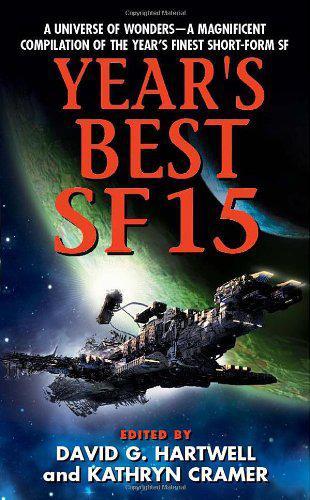
Year's Best SF 15
by
David G. Hartwell; Kathryn Cramer
Published 15 Aug 2010
With barely a murmur the shuttle leaped into the air. No amount of padding could save Freddie from the punch of acceleration. The ground plummeted away. Tempest 43 was a weather control station, one of a network of fifty such facilities thrown into space in the 2070s, nearly a century ago, by the now maligned AxysCorp geoengineering conglomerate. An island in the sky over the Atlantic, Tempest 43 was locked into a twenty-four-hour orbit, to which Freddie would now have to ascend. But before proceeding up to geosynchronous, the shuttle went through one low-orbit checkout. For Freddie, snug in her theme-park couch, it was ninety magical minutes, as the cabin walls turned virtual-transparent, and the Earth spread out below her, bright as a tropical sky.
…
Fortune turned and stalked away, down a metal-plated corridor. Bella walked after him, looking hurt and confused. Her feet convincingly touched the floor. Freddie and Allen followed less certainly, into the metal heart of the station. To Freddie, the station had the feel of all the AxysCorp geoengineering facilities she’d visited before. Big, bold, functional, every surface flat, every line dead straight. The corporation’s logo was even stamped into the metal walls, and there was a constant whine of air conditioning, a breeze tasting of rust. You could never escape the feeling that you were in the bowels of a vast machine.
…
“Actually, this is again typical of AxysCorp,” Freddie said. “Given immense budgets, huge technical facilities, virtually unlimited power, and negligible scrutiny, AxysCorp technicians often took the opportunity to experiment. Of course a willingness to meddle was necessary for them to be able to proceed with Heroic-Solution geoengineering projects in the first place.” “They used the climate disaster as the cover for crimes,” Allen said. “The purposeless crippling of sentiences, for example. We have to acknowledge their achievements. But it’s as if the world has been saved by Nazi doctors.” “Humans are flawed creatures,” Fortune said.

The Price of Everything: And the Hidden Logic of Value
by
Eduardo Porter
Published 4 Jan 2011
And there’s no parameter to tell us precisely how to price this fear. SALVATION ON THE CHEAP Or maybe she could cross her fingers and hope we will devise some clever technology to stop us from colliding head-on with the limits of the planet. Some scientists have been toying with the idea that geo-engineering might save the day from climate change: putting mirrors in orbit to reflect part of the sun’s energy away from the earth, or pumping sulfur dioxide into the stratosphere. This would replicate the effects of the 1991 eruption of Mount Pinatubo in the Philippines—which sent up so much stuff into the air it blocked the sun and reduced surface temperatures by half a degree Celsius over the next two years.
…
Estimates of economic growth over the past two hundred years come from Angus Maddison, “Historical Statistics for the World Economy: 1-2008 AD” (http://www.ggdc.net/maddison/Historical_Statistics/horizontal-file_02-2010.xls, accessed 08/11/2010). 220-222 Torn Between Two Prices: Stern’s and Nordhaus’s contrasting prescriptions are found in William Cline, “Climate Change Economics 2008,” Lecture presented at Colgate University, Center for Ethics and World Societies, Hamilton, New York, March 10, 2008; and William Nordhaus, A Question of Balance: Weighing the Options on Global Warming Policies (New Haven: Yale University Press, 2008), especially pp. 1-29, 88-93, and 165-191. Data from the European Climate Exchange is at www.ecx.eu. Dasgupta’s difficulty in reaching a conclusion on how much to spend to slow global warming is in Partha Dasgupta, op. cit. 222-225 Salvation on the Cheap: Comments about geo-engineering solutions to global warming are found in Catherine Brahic, “Hacking the Planet: The Only Climate Solution Left?,” New Scientist, No. 2697, July 2009, pp. 8-10. The tale about the wager between Julian Simon and Paul Ehrlich is in John Tierney, “Betting on the Planet,” New York Times Magazine, December 2, 1990.

Utopias: A Brief History From Ancient Writings to Virtual Communities
by
Howard P. Segal
Published 20 May 2012
Safe, efficient, and comparatively cheap nuclear power stations are their envisioned principal energy sources.3 To these envisioned powers we must now add contemporary megaprojects intended to reduce, if not eliminate, global climate change. Historian James Fleming has analyzed this revived faith in “techno-fixes,” which makes the “Star Wars” anti-missile The Resurgence of Utopianism 187 defense system seem modest by comparison. There are historical precedents for such present-day geo-engineering schemes dating back to American experiments in the 1940s. For that matter, over a century earlier, in 1839, America’s first meteorologist, James Espy, suggested lighting fires along the Appalachians to try to produce rainfall on the East coast. Present-day schemes would shade the planet by launching a solar shield into orbit or suck carbon dioxide out of the air with hundreds of thousands of giant artificial trees.
…
Curiously, in 206 The Resurgence of Utopianism many contemporary discussions about the future of science and technology in higher education one would never guess that technological determinism and the technological imperative, along with scientific and technological utopianism, are no longer gospel everywhere. Like Noble’s and Fleming’s scientific and technological elites in space flight, nuclear weapons, artificial intelligence, genetic engineering, and geo-engineering, many educational leaders are locked into old-fashioned bedrock beliefs about science and technology allegedly shaping the modern world, shaping it without question, and shaping it only for the better. One of my favorite examples is a 1998 speech by James J. Stukel, then president of the multi-campus University of Illinois, entitled “The Future of Land Grant Universities” but relevant to public (and, to a lesser extent, private) universities in general.

The Quiet Damage: QAnon and the Destruction of the American Family
by
Jesselyn Cook
Published 22 Jul 2024
If viewers wanted to know what was really going on, Ossebaard urged, they needed to figure it out for themselves using alternative, independent sources, as she herself had done. Even fact-checking organizations were not to be trusted. The entire hours-long series followed the same pattern: Again and again, with striking visuals, Ossebaard made outright false or misleading claims and insinuations—like her conflation of geoengineering aerosols, a proposed intervention to reduce global warming, with “chemtrails,” toxic chemicals rumored to be sprayed by airplanes to harm the public. Then she chastised the media for failing to report “the truth.” Some parts left Alice uncomfortably second-guessing her own beliefs, especially when Ossebaard acknowledged that she too had initially dismissed certain ideas as mere “conspiracy theories.”
…
These days, her brain was constantly scanning for conspiracy, like a ravenous bloodhound hunting a phantom scent. All kinds of things smelled fishy to her. In February, when a snowstorm hit parts of western Alabama, glazing their street in a thin sheet of ice, she was convinced that the Cabal had geoengineered the weather by seeding the clouds with biomimetic surfactants. Dale was beside himself. He feared that seventy-seven-year-old Doris was losing her mental faculties. Only after a series of panicked and rather disturbing Google searches did he learn that nearly all her beliefs could be traced back to a wide-ranging conspiracy theory known as QAnon.

Augmented: Life in the Smart Lane
by
Brett King
Published 5 May 2016
So the market is very big.”13 Dr Askwar Hilonga via Reuters One of these filters, which costs around US$100 to manufacture, is capable of supplying the needs of a family with many litres of clean water per day. Smart materials and nanotechnology will allow us to create very efficient filtering systems that make our air and water cleaner with much lower investments than we imagine today. Geoengineering the planet will be a popular career for Millennials and their descendants as the globe starts to feel the increased effects of climate shift, and as the old guard loses its influence on policymaking that protects incumbent industries. Smart Emergency Response Systems Keeping its citizens safe in times of emergencies or disasters is a major challenge for smart cities.
…
At the Dentsu meeting, she’s working with a team to promote a new VR series called The Hab produced by Electronic Arts and Amazon. The series is basically a fluff piece for NASA and the European Space Agency (ESA) on the colonisation of Mars, which is currently a subject of debate across the European Union and in the US Congress in respect to funding proposals. There are still those who argue that the problems of geoengineering the planet against the increasingly aggressive temperature changes should take priority. Nonetheless, the VR series is turning out to be extremely popular. Hannah is working on character pieces for electronic displays around Tokyo and Osaka to promote the series. She submitted a couple of concepts last week and the team is refining its pitch to EA before its presentation next week. 1:30 p.m.

Four Futures: Life After Capitalism
by
Peter Frase
Published 10 Mar 2015
But in many cases, these innovations involve high-tech green solutions that are only accessible to the rich. At the same time, truly global solutions are rejected, even when, as in the case of taxing carbon, they are ostensibly “market” solutions. The initiatives that excite the eco-capitalists are, instead, fanciful projects of “geoengineering” that attempt to manipulate the climate, despite the uncertain efficacy and unknown side effects of such procedures. As with the Koch brothers and their denialist ilk, the eco-capitalists are concerned primarily with preserving the prerogatives and lifestyles of the elite, even if they put a more environmentalist veneer on this agenda.
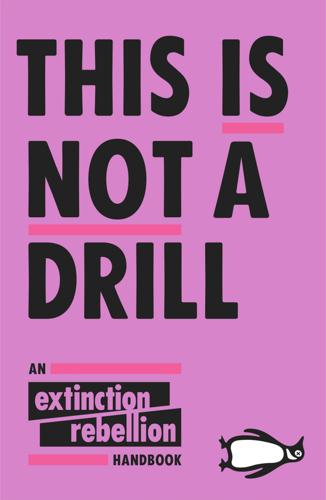
This Is Not a Drill: An Extinction Rebellion Handbook
by
Extinction Rebellion
Published 12 Jun 2019
It’s unclear how our financial markets will respond to the realization of climate shocks: there is a risk that our systems of both credit and payments could seize up. Governments need to ensure we have electronic means of payment outside of the private banking system so trade can continue in the event of a financial collapse. Some responses for resilience will take a bit longer. We need to try to buy more time. Many geoengineering ideas are highly dangerous and impractical. But one makes sense right now. We should be seeding and brightening the clouds above the Arctic immediately, as a global emergency response. We need to be reacting as we would if an Armageddon-sized meteor was hurtling towards Earth. Second, what do we need to let go of in order not to make matters worse?

The Burning Answer: The Solar Revolution: A Quest for Sustainable Power
by
Keith Barnham
Published 7 May 2015
American Physical Society, ‘Direct Air Capture of CO2 with Chemicals’, 1 June 2011, http://www.aps.org/policy/reports/assessments/upload/dac2011.pdf, accessed 20 January 2014. 7. Richard Schiffman, ‘Artifical Trees as a Carbon Capture Alternative to Geoengineering’, The Yale Forum on climate change and the media, 13 February 2013, http://www.yaleclimate-mediaforum.org/2013/02/artificial-trees-as-a-carbon-capture-alter-native-to-geoengineering/, accessed 5 February 2014. 8. Christopher Graves, Sune D. Ebbeson, Mogens Mogensen and Klaus S. Lackner, ‘Sustainable Hydrocarbon Fuels by Recycling CO2 and H2O with Renewable or Nuclear Energy’, Renewable and Sustainable Energy Reviews, 15, 1 (2011). 9.

Losing Earth: A Recent History
by
Nathaniel Rich
Published 4 Aug 2018
There can be no future unless it is understood—if not by all, then at least by a safe majority of American voters—that our future will be commonly shared. * * * Nearly every conversation that we have in 2019 about climate change was being held in 1979. That includes not only the predictions about degrees of warming, sea level rise, and geopolitical strife but also the speculations about geo-engineering technology, the appeals to help developing nations overcome starvation and disease without relying, as we did, on massive increases in coal consumption, and the cost-benefit analyses that always seem to favor inaction. Forty years ago, the political scientists, economists, social theorists, and philosophers who studied the slow-moving threat of climate change generally agreed that we could not be counted on to save ourselves.

What Technology Wants
by
Kevin Kelly
Published 14 Jul 2010
In other words, technology teaches us how to make innovative kinds of mistakes we could not make before. In fact, asking ourselves how humanity might make entirely new kinds of mistakes is probably the best metric we have for discovering new possibilities of choice and freedom. Engineering our genome is primed to create a new kind of mistake and therefore indicates a new level of free will. Geoengineering the planet’s climate might also indicate a new arena of mistakes and therefore choice. Connecting every person to every other person alive in real time via cell phone or wires also unleashes new powers of choice and incredible potential for mistakes. All inventions widen the space of what is possible and thereby stretch the parameters in which choices can be made.
…
as long-term trend see also choices Freeland, Stephen Friedel, Robert Friend, Tad Fromm, Erich Fuller, Buckminster fur trappers fuzzy logic Gaiman, Neil Galileo Galilei games, finite vs. infinite Gardner, James Garreau, Joel Gaston, Jerry Gauss, Karl Friedrich genes see also DNA; mutations gene therapy genetically modified organisms banning of genetic cloning genetic codes randomly generated genetic engineering genetic information genetics Mendelian genetic testing genotechnology Gent, George geoengineering Geremek, Bronislaw Germany Gift of Good Land, The (Berry) Gillooly, James Gladwell, Malcolm global warming Godfrey, Laurie Goldilocks zones Goodwin, Brian Gould, Stephen Jay grandmother effect Gray, Elisha gray goo scenario Greeks, ancient crossbows of Moirae of warfare of green anarchy green cities green technology Guide to Technology (Beckmann) gunpowder Guns, Germs, and Steel (Diamond) habitat destruction Hadamard, Jacques Hagstrom, Warren Harbord, James Harry Potter series (Rowling) Hawken, Paul heat death Heidegger, Martin helmet evolution Hemple Bay tribe Henry, Joseph Henry VIII, king of England Hillis, Danny hippie movement Hitchcock, Alfred Hobbes, Thomas Homer hominins African origin of ecological alterations effected by life expectancy of live grandparents lacked by reproductive effectiveness of tools of Homo erectus Homo sapiens as entity vs. tendency see also Neanderthals Homo sapiens sapiens, see Sapiens honeyguide bird Hoover Dam howler monkey hunter-gatherers biophilia of breast-feeding duration among child mortality of deforestation’s effect on diet of disposable culture of fertility rate of gathering by hungry periods endured by hunting by leisure time of Paleolithic rhythm of social norms of social organization of surplus production avoided by tools of tribal warfare of youthful demographic of Hurst, Laurence hydrogen ice ages ichthyosaurs idea factories ideas Illich, Ivan Incas India Industrial Revolution inevitability evolutionary forecasting fostered by hastening vs. postponement of meanings of ubiquity in see also convergence; inventions, convergence of information computation and definitions of genetic scientific compression of Innocent II, pope innovations Intellectual Ventures intelligenation intelligence of animals artificial charismatic collective diversity of internet and of plants internet Amish and contingent development of as intelligent superorganism original purpose of potential abuses of search engines of socializing effect of technophilia and uneven diffusion of wiki engines of inventions breakthrough coevolution of of early Sapiens as exaptations Frankenstein syndrome and overly futuristic patenting of potentially harmful, see technology, potential dangers of as predicted war deterrents in scientific method secondary see also language inventions, convergence of acceleration of ancient, on different continents archaeological evidence of archetypal forms of in arts choice as contradicted by contingent details of developmental sequence in domestication in idea factories for individual geniuses vs.

Ways of Being: Beyond Human Intelligence
by
James Bridle
Published 6 Apr 2022
But, because we are interested in ecological relationships, we will also touch on the centuries of industrial technology which preceded it: the science of steam engines, cotton mills, jet turbines, pneumatic clocks and telegraph wires. We will even encounter Neolithic flutes, clockwork automata, water organs, and the ‘new media’ of Ancient Greece. In this endeavour, I am not concerned with the overt technologies of environmental ecology – with solar panels, wind turbines, carbon capture and geoengineering – as necessary and fascinating as these tools may be. Rather, I am concerned at a deeper level with how we think with, through and about all our technologies: how we consider their role and their impact, their meaning and metaphor, their dialogue and relationships with the surrounding world. To the ecological thinker, all technologies are ecological.
…
By transferring genes from cork trees into the cress, the researchers found that they could encourage it to grow much deeper, denser root structures, packed with suberin, an impermeable, cork-like polymer which stores huge amounts of carbon.4 If they can repeat the feat with widely grown crops such as wheat, rice and cotton, then vast areas of arable land might be transformed into engines of carbon sequestration: pulling climate change-accelerating carbon out of the atmosphere and storing it safely underground for decades, even centuries. This approach seems far more promising than the kind of megascale geo-engineering schemes proposed by global tech corporations: vast stacks of reactors and chimneys which pull carbon directly from the atmosphere, while producing ever more soon-to-be-obsolescent infrastructure and material waste.5 Our common future demands less industrial hubris and more cooperation with existing, and deeply knowledgeable, biological systems.

Doppelganger: A Trip Into the Mirror World
by
Naomi Klein
Published 11 Sep 2023
She did, too, shortly after, only with her special conspiracy twists. I began publishing about the dangers of geoengineering as a response to the climate crisis, with a particular focus on how high-altitude simulations of volcanoes that were intended to partially dim the sun risked interfering with rainfall in the Southern Hemisphere. She was busily speculating on social media about chemical cloudseeding and covert mass poisonings. I based my writing on dozens of peer-reviewed papers and managed to get access to two closed-door geoengineering conferences, where I interviewed several of the key scientists involved in lab-based research on sending particles into the upper atmosphere to control the sun’s radiation.

A Half-Built Garden
by
Ruthanna Emrys
Published 25 Jul 2022
I’m first mother of the Solar Flare”—limbs pointed at the palace behind them—“here on behalf of all the families of the Rings. We can help you escape this world.” I pulled Dori close. “Escape it? Why?” Scenarios tumbled through my mind: an incoming comet missed by our scant satellites, methane reservoirs breaching their tenuous tissue of permafrost and geoengineered shields—or Cytosine’s people teleporting nine billion people to “safety” before appropriating Earth for their own purposes. “Hallo,” called a voice behind me. “Radio Free Terra is in the—oh, shit.” The newcomer, bearded and thickly built and wearing a they/them badge, set down a box of equipment and gaped.
…
In the common feed and across networks, the Lower Mississippi unleashed a flood of threads: some begging for help replacing now-irrelevant storm preparations and resources overwhelmed by the flood, others demanding justice under the shared guidelines of the watersheds. “This has to count as unapproved geoengineering, right?” asked Mendez. Her usual confidence faltered; this was even further beyond her expertises than mine. “I think so. But it’s not like atmospheric seeding; you’d have a hard time making the case that it was meant to impact anyone outside the one network.” And even if it was, they had no idea who did it.
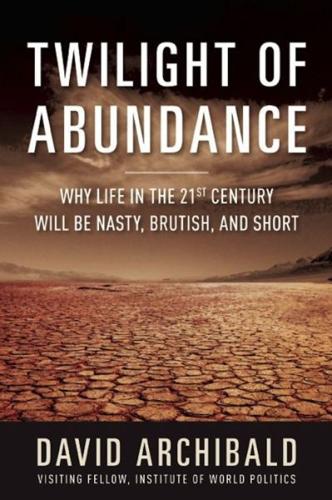
Twilight of Abundance: Why the 21st Century Will Be Nasty, Brutish, and Short
by
David Archibald
Published 24 Mar 2014
And three days later, Trenberth sent another email betraying the gap between the climate alarmists’ confident public pronouncements and the real state of their research: How come you do not agree with a statement that says we are nowhere close to knowing where energy is going or whether clouds are changing to make the planet brighter? We are not close to balancing the energy budget. The fact that we cannot account for what is happening in the climate system makes any consideration of geo-engineering quite hopeless, as we will never be able to tell if it is successful or not! It is a travesty! The possible corruption of the world’s temperature data sets by IPCC scientists prompted the UK Met Office (the national weather service, formerly known as the Meteorological Office) to announce on February 25, 2010, that it is going to reexamine more than 150 years of global temperature records.

Survival of the Richest: Escape Fantasies of the Tech Billionaires
by
Douglas Rushkoff
Published 7 Sep 2022
His glossy brochures and high-budget videos depict a total solution for how the world’s biggest banks and corporations can employ automation to fix joblessness, mass surveillance to solve immigration, biometric tracking to ensure global health, sensor networks to upgrade agriculture, blockchains to wipe out slav ery, geo-engineering to remedy climate change, and capitalism to repair the extractive damage of, well, capitalism. Such fanciful pronouncements for a civilization-wide transformation orchestrated by technocratic billionaires don’t play well in Peoria, and they undermine more legitimate efforts at addressing crises, which are never so seamlessly deployed.

2312
by
Kim Stanley Robinson
Published 22 May 2012
Only with the utmost caution could they tinker with anything on Earth, because everything there was so tightly balanced and interwoven. Anything done for good somewhere usually caused ill somewhere else. This caution about terraforming Earth expressed itself in clots and gouts of sometimes military bickering. Political crosschop led to legal gridlock. Big geoengineering projects were all assumed to contain within them an accident like the Little Ice Age of the 2140s, which was generally said to have caused the death of a billion people. Nothing now could overcome that fear. Also, for many of Earth’s problems, there was simply nothing to be done. The heating and subsequent expansion of the ocean’s water—also its acidification—nothing could be done about these.
…
How they despised the generations of the Dithering, who had heedlessly pushed the climate into a change with an unstoppable momentum to it, continuing not only into the present but for centuries more to come, as methane clathrate releases and permafrost melting began to outgas the third great wave of greenhouse gases, possibly the largest of them all. They were on their way to being a jungle planet, and the prospect was so alarming that there was serious talk of trying atmospheric sunblocks again, despite the disaster two centuries before. There was growing agreement that the job had to be taken on, and geo-engineering either micro or macro attempted. Intensive micro, mild macro—there was a constant to-and-fro about it, and many micro or tiny macro restoration projects had already begun. One thing they were trying was to slow the outflow glaciers off the Greenland ice cap. Antarctica and Greenland were the two meaningful reservoirs of ice left on the planet, and modelers were very hopeful that eastern Antarctica at least would hold fast through the heat peak into the hoped-for return to a colder atmosphere and ocean.

The Techno-Human Condition
by
Braden R. Allenby
and
Daniel R. Sarewitz
Published 15 Feb 2011
How the West Grew Rich: The Economic Transformation of the Industrial World. Basic Books. Rousseau, J.-J. 1754 [1964] Second Discourse. In The First and Second Discourses of Jean-Jacques Rousseau. St. Martin's. Rowling, lastic. J. K. 2005. Harry Potter and the Half-Blood Prince. Scho- Royal Society. 2009. Geoengineering the Climate: Science, Governance, and Uncertainty. Policy Document 10-09. Sagoff, M. 1988. The Economy of the Earth. Cambridge University Press. Sandel, M. 2009. The Case Against Perfection: Ethics in an Age of Genetic Engineering. Harvard University Press. Sarewitz, D., and R. Nelson. 2008. Progress in know-how: Its origins and limits.

Adaptive Markets: Financial Evolution at the Speed of Thought
by
Andrew W. Lo
Published 3 Apr 2017
Finance is central to this debate. If no political solution to climate change is forthcoming, finance can also be helpful in funding innovative technological solutions. These would involve megaprojects on a global scale, such as liquefying atmospheric carbon dioxide and sequestering it deep underground, also known as geo-engineering. Some of these projects will require considerable research and development to implement. For example, there are species of bacteria that metabolize methane, one of the most potent greenhouse gases in the atmosphere.22 Would it be possible to aerosolize these bacteria in the upper atmosphere, so they can eliminate a major source of greenhouse warming?
…
See also “Quant Meltdown” (August 2007) financial engineering, 212, 415 financial sector, 330–332 finches, 226–227, 240, 244 FINRA (Financial Industry Regulatory Authority), 360 financial technology, 248, 361, 399, 405 first-order false belief, 111 Fisher, Larry, 23 Fisher, Ronald Aylmer, 216–217 fixed-income arbitrage, 243, 293 fixed-rate commissions, 281 flash crashes, 358–359, 360 Food and Drug Administration (FDA), 404 food production, 8–9 footbridge dilemma, 339 foreign exchange, 12–16, 24, 38 Foundations of Economic Analysis (Samuelson), 177, 210, 212–213 Fouse, William L., 263 FOXP2 gene, 173–174 fractional reserve banking, 344 framing effects, 58–59, 388 France, 242 fraternal twins, 159, 161 Freddie Mac, 298, 379 Friedman, Milton, 25, 34 Fuld, Dick, 318 functional magnetic resonance imaging, (fMRI), 77–78, 86, 88–89, 90, 101, 102, 186, 337, 338 funds of hedge funds, 293 futures contracts, 20, 34, 243, 268, 273, 276, 356 future value, 98 Galapagos Islands, 225–227 gambling, 17, 59–60, 67, 88–89, 91–92, 186 game theory, 170, 179, 212, 217, 336 Gaucher disease, 418, 419 Gaussian distribution (bell curve), 22, 273 Gazzaniga, Michael, 113, 115–117, 123, 313 Gekko effect, 348, 391 Gekko, Gordon (fictional character), 345, 346, 349, 387, 417 GenBank, 402–403 general equilibrium theory, 212, 213 genome sequencing, 401, 402 Genzyme, 419 geo-engineering, 416 Germany, 242 Gerrold, David, 190 Getmansky, Mila, 317, 376 Gibbs, Josiah Willard, 20, 210 Gibson, Rajna, 353 Gift of Fear, The (de Becker), 1 Gigerenzer, Gerd, 216 Gilovitch, Thomas, 68–69 Gimein, Mark, 317 Glimcher, Paul, 99 glucocerebrosidase, 419 Goldman Sachs, 242, 287, 295, 307, 308, 324 Goldfield, Jacob, 311 Good Night, Gorilla (Rathmann), 135 Google, 405 gorilla, 150 Gould, Stephen Jay, 171, 172 Government Accountability Office (GAO), 308, 311, 351–352 government bonds, 249, 292; U.S.
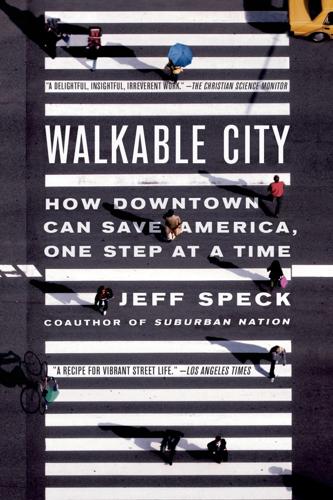
Walkable City: How Downtown Can Save America, One Step at a Time
by
Jeff Speck
Published 13 Nov 2012
WORKS CITED BOOKS Alexander, Christopher. A Pattern Language. New York: Oxford University Press, 1977. Arnold, Henry F. Trees in Urban Design, 2nd ed. New York: John Wiley, 1992. Brand, Stewart. Whole Earth Discipline: Why Denser Cities, Nuclear Power, Transgenic Crops, Restored Wetlands and Geoengineering Are Necessary. New York: Penguin, 2009. Buettner, Dan. The Blue Zones: Lessons for Living Longer from the People Who’ve Lived the Longest. Washington, D.C.: National Geographic, 2008. _____. Thrive: Finding Happiness the Blue Zones Way. Washington, D.C.: National Geographic, 2010. Byrne, David.

The Decadent Society: How We Became the Victims of Our Own Success
by
Ross Douthat
Published 25 Feb 2020
(They will especially argue that it was the decadence of conservative institutions, conservative political parties, and conservative intellectuals in the United States that helped bring about the unnecessary catastrophe.) And somewhere between the two perspectives would be the Cassandras of technological stagnation, arguing that the problem wasn’t political decadence so much as the too-slow pace of innovation, the failure of promised clean-energy breakthroughs or geo-engineering technologies to emerge in time—a different kind of decadence than the political or cultural sort, or an additional element in the mix that laid late-modern civilization low. I think it is precisely the history-as-morality-play element in all these narratives that makes me skeptical that the catastrophe will come, or that it will come in the semipredictable high temperatures plus population imbalances plus migration equals fatal political and economic crisis that this chapter has described.

The Authoritarian Moment: How the Left Weaponized America's Institutions Against Dissent
by
Ben Shapiro
Published 26 Jul 2021
To reach net zero carbon emissions worldwide by 2050 via Representative Alexandria Ocasio-Cortez’s (D-NY) infamous Green New Deal would cost the typical family of four $8,000 every single year.26 This is not to suggest that nothing can be done about climate change. We should be investing in adaptive measures like seawalls, and be looking to new technologies like geoengineering. We should be cheering on America’s fracking industry, which has redirected energy use from more carbon-intensive industries; we should be pushing for the use of nuclear energy; we should be promoting capitalism, which increases living standards around the globe, thus making people in poverty less vulnerable to the ravages of climate change.
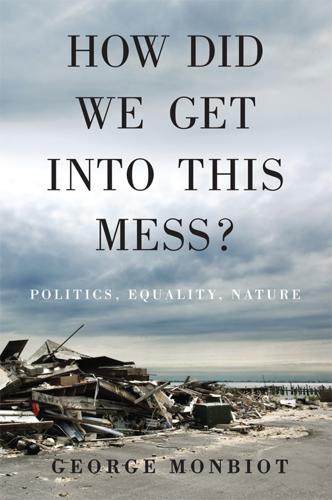
How Did We Get Into This Mess?: Politics, Equality, Nature
by
George Monbiot
Published 14 Apr 2016
It is hard to quantify, but when they were at their historical populations, whales are likely to have made a small but significant contribution to the removal of carbon dioxide from the atmosphere. The recovery of the great whales, which were reduced by between two-thirds and 90 per cent, but whose numbers are slowly climbing again in some parts of the oceans, could be seen as a benign form of geo-engineering.11 This should not be the only, or even the main, reason why we should wish them to return, but the way in which whales change the composition of the atmosphere provides yet another refutation of the idea that we can manipulate the living world with simple, predictable results. With the Sustainable Human team – an online platform that shares content relating to crises that afflict civilisation and the Earth we live on – I produced a video about trophic cascades featuring the whale pump.12 Another – about the unexpected impact of wolves in Yellowstone National Park – has been watched 20 million times.13 The belief that people cannot handle complexity is a myth.

Four Lost Cities: A Secret History of the Urban Age
by
Annalee Newitz
Published 2 Feb 2021
Europeans decided to name the ancient city after them, despite the fact that the Cahokia themselves did not claim to have built it. The name stuck. Centuries later, Cahokia’s meteoric rise and fall remain a mystery. By 1400 its population had largely dispersed, leaving behind scattered villages on a landscape completely geoengineered by human hands. Mississippian culture can be found in the traditions of Siouan tribes, especially the Osage, and the mounds continue to inspire modern indigenous people from many tribes. But what led to the city’s founding, and its abandonment, remain ambiguous. Looking for clues, archaeologists dig through the thick, wet, stubborn clay that Cahokians once used to construct their mounds.

The Thinking Machine: Jensen Huang, Nvidia, and the World's Most Coveted Microchip
by
Stephen Witt
Published 8 Apr 2025
In fact, she might want dozens or even hundreds of Cuisinarts running at the same time. The truckload of vegetables in this analogy represents Big Data. In the mid-2000s, the scientific loading dock was piling up with datasets that were exponentially larger than anything that had come before: astronomical data, geo-engineering data, medical data, government data, financial data, and the sprawling, ever-expanding human-generated dataset of the World Wide Web. In the past, a scientist might count herself lucky with one crate of vegetables every couple of weeks. By the mid-2000s, a scientist could expect delivery of several shipping containers’ worth of vegetables every day.

Capitalism Without Capital: The Rise of the Intangible Economy
by
Jonathan Haskel
and
Stian Westlake
Published 7 Nov 2017
But, on the whole, this seems unlikely: the relationship between government and business in most developed countries has changed so much since the 1960s and 1970s that it is hard to imagine this kind of corporatism being re-created on a significant scale, and it is hard to imagine that it would not have other negative effects that would lower productivity.2 (A smaller scale version of this might emerge, however, if more companies follow the pattern of Microsoft, which generated great personal wealth for its founders, who then went on to fund intangible investments for the public good. Examples are Bill Gates, whose Gates Foundation funds research into tropical diseases, and Nathan Myhrvold, who backs nuclear and geoengineering research. But this seems unlikely to make up the difference.) This leaves government as an investor of last resort. It is hard to escape the conclusion that if intangible investment is harder for businesses to fund, and if it is becoming more important to the economy, then unless we are prepared to see a shortfall in investment, the role of government as an investor will have to grow.
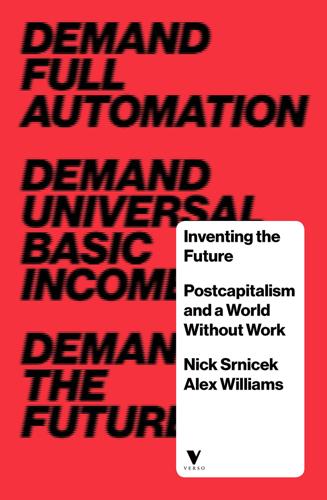
Inventing the Future: Postcapitalism and a World Without Work
by
Nick Srnicek
and
Alex Williams
Published 1 Oct 2015
Though aviation was still a novelty, the dreams of space flight promised ‘total liberation from the signifiers of the past: social injustice, imperfection, gravity, and ultimately, the Earth’.24 The utopian inclinations of the time made sense of the rapidly changing world, gave credence to the belief that humanity could channel history in a rational direction and cultivated anticipations for a future society. In the more mystical formulations, cosmists argued with admirable ambition that geoengineering and space exploration were only partial steps towards the real goal: resurrecting the entirety of the dead.25 Meanwhile, more secular approaches outlined detailed plans for fully automated economies, mass economic democracy, the end of class society and the flourishing of humanity.26 Such was the level of enthusiasm and belief in imminent space travel that in 1924 a riot nearly erupted when rumours circulated about a possible rocket flight to the moon.27 Popular culture was saturated with these images and with stories in which technological and social revolution intertwined.

The Age of Stagnation: Why Perpetual Growth Is Unattainable and the Global Economy Is in Peril
by
Satyajit Das
Published 9 Feb 2016
Despite commitments to renewable energy, fossil fuel's share of global energy has not declined materially. Dealing with climate change requires a reduction in greenhouse gas emissions. This would be economically costly and entail a radical transformation in living standards. Instead, governments have placed their faith in human ingenuity. Geoengineering is one such scientific fantasy. One of its schemes aims to remove excess CO2 from the atmosphere through photosynthesis, by fertilizing the oceans with iron. Another scheme involves reducing the amount of sunlight reaching the earth by reflecting it back into space, thus increasing the albedo, or the fraction of solar energy reflected.
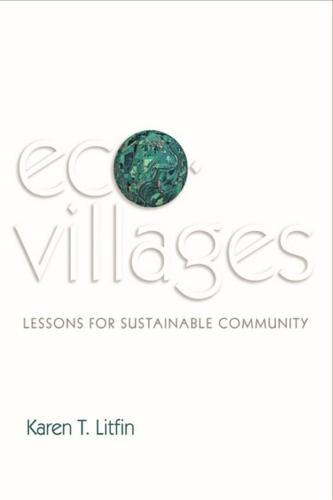
Ecovillages: Lessons for Sustainable Community
by
Karen T. Litfin
Published 16 Dec 2013
The South is unlikely to alter its trajectory without the sort of exemplar that ecovillages provide, nor without financial and technological assistance from the wealthier and more culpable North. Climate change will only aggravate these tensions. As the Bangladeshi delegate told an international climate summit, “We will march with our wet feet into your living rooms!” In an era of climate refugees, geo-engineering, and species triage, an insular strategy is inadequate. Local sustainability initiatives like Transition Towns and eco-neighborhoods will be far more compelling when pursued under a global umbrella. Just as trust is the social glue in an ecovillage, so too must it be in a sustainable global civilization.

The Sixth Extinction: An Unnatural History
by
Elizabeth Kolbert
Published 11 Feb 2014
Ocean Acidification. Oxford: Oxford University Press, 2011. Gleick, James. Chaos: Making a New Science. New York: Viking, 1987. Glen, William, ed. The Mass-Extinction Debates: How Science Works in a Crisis. Stanford, Calif.: Stanford University Press, 1994. Goodell, Jeff. How to Cool the Planet: Geoengineering and the Audacious Quest to Fix Earth’s Climate. Boston: Houghton Mifflin Harcourt, 2010. Gould, Stephen Jay. The Panda’s Thumb: More Reflections in Natural History. New York: Norton, 1980. Grant, K. Thalia, and Gregory B. Estes. Darwin in Galápagos: Footsteps to a New World. Princeton, N.J.: Princeton University Press, 2009.

Six Degrees: Our Future on a Hotter Planet
by
Mark Lynas
Published 1 Apr 2008
Feeding a world of eight or nine billion is another matter, but the idea that every single one of us could be wiped out strikes me as inconceivable. Unlike the Permian terrestrial animals, we can stockpile enough food in preserved form to last for many years. We can create artificial atmospheres to isolate ourselves from what is going on outside. As some scientists have suggested, we could take emergency measures to geo-engineer our climate, perhaps by spreading solar mirrors in space or scattering sulphates throughout the upper atmosphere in a last-ditch attempt to cool things down. We could one day even set up colonies on other planets. And yet somehow this is scarce consolation given the torments that may lie in store.
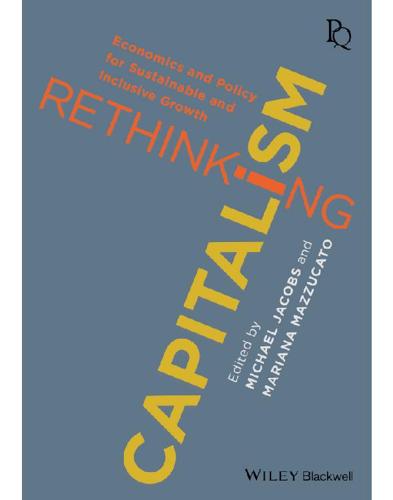
Rethinking Capitalism: Economics and Policy for Sustainable and Inclusive Growth
by
Michael Jacobs
and
Mariana Mazzucato
Published 31 Jul 2016
So the key insight of climate science—which has often not been properly grasped—is that no matter what the temperature at which we seek to stabilise, whether two degrees warmer or six degrees, net GHG emissions must ultimately fall to zero. In other words, the global economy must decarbonise more or less completely. (‘Net emissions’ allows for the fact that some emissions can be sequestered, either through an increase in natural carbon sinks, such as forests, or through carbon capture and storage technologies. ‘Geoengineering’ techniques may also have the potential to offset some of the effects of global warming, but are untried, carry significant risks and do not address other impacts such as ocean acidification.) The IPCC’s climate modelling shows that to have a likely chance of holding warming to 2°C, carbon emissions must be reduced to net zero by 2065–2085, and all GHGs by the end of the century.7 This will require a fundamental structural transformation in all economies.
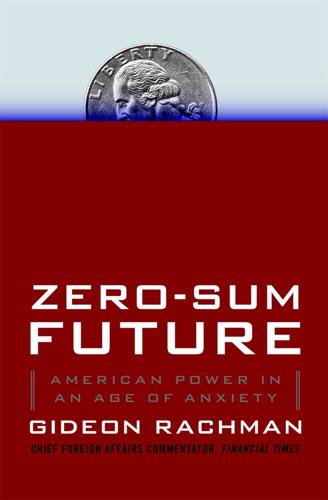
Zero-Sum Future: American Power in an Age of Anxiety
by
Gideon Rachman
Published 1 Feb 2011
The secrets of the bomb and space programs were kept closely guarded for reasons of national security, but climate change is a question of international security. An international project mobilizing the scientific and engineering talents of China and the United States could do crucial research on a range of subjects from renewable energy to geoengineering. It could also incorporate scientists from India, Europe, and the rest of the world. If a global climate research project received high-level backing from the leaders of the United States and China, it would provide a valuable example of the two nations cooperating on a vital topic of shared interest.

The Big Nine: How the Tech Titans and Their Thinking Machines Could Warp Humanity
by
Amy Webb
Published 5 Mar 2019
As AI systems advance and more of everyday life gets automated, the less control we actually have over the decisions being made about and for us. This, in turn, has a compounding effect on the future of many other technologies adjacent to or directly intersecting with AI: autonomous vehicles, CRISPR and genomic editing, precision medicine, home robotics, automated medical diagnoses, green- and geoengineering technologies, space travel, cryptocurrencies and blockchain, smart farms and agricultural technologies, the Internet of Things, autonomous factories, stock-trading algorithms, search engines, facial and voice recognition, banking technologies, fraud and risk detection, policing and judicial technologies… I could make a list that spans dozens of pages.

Falter: Has the Human Game Begun to Play Itself Out?
by
Bill McKibben
Published 15 Apr 2019
The changes will, Savulescu insists, be liberating: “Moral enhancement of a person does not restrict freedom; it rather extends it, by making the subject more capable of overcoming urges which counteract the doing of what is seen as morally good.” It “hurts our pride,” he theorizes, to “acknowledge our moral deficiencies,” and yet we must do so, because the threats to our future must be answered by “morally responsible people.”20 This whole scheme is roughly akin to “geoengineering the atmosphere” to prevent climate change—some people, having given up on taming the fossil fuel companies, want to instead pump the atmosphere full of sulfur to block incoming solar radiation. In both cases, it’s an ugly workaround, based on the premise that we humans won’t rise to the occasion.

Practical Doomsday: A User's Guide to the End of the World
by
Michal Zalewski
Published 11 Jan 2022
Wyatt et al., “Historical Mammal Extinction on Christmas Island (Indian Ocean) Correlates with Introduced Infectious Disease,” PLoS One 3, no. 11 (November 2008), https://www.ncbi.nlm.nih.gov/pmc/articles/PMC2572834/. 10. “Climate Updates,” The Royal Society, November 27, 2017, https://royalsociety.org/~/media/policy/Publications/2017/27-11-2017-Climate-change-updates-report-references-document.pdf; Colin Goldblatt and Andrew J. Watson, “The Runaway Greenhouse: Implications for Future Climate Change, Geoengineering and Planetary Atmospheres,” Philosophical Transactions of the Royal Society 370, no. 1974 (September 2012), https://royalsocietypublishing.org/doi/full/10.1098/rsta.2012.0004/. 11. “Little Ice Age,” Britannica.com, https://www.britannica.com/science/Little-Ice-Age. 12. University of Cincinnati, “New Evidence Suggests Volcanoes Caused Biggest Mass Extinction Ever,” Phys.org, April 15, 2019, https://phys.org/news/2019-04-evidence-volcanoes-biggest-mass-extinction.html. 13.

Supremacy: AI, ChatGPT, and the Race That Will Change the World
by
Parmy Olson
Electrons could flow in all sorts of different directions, which meant there was always going to be a way for powerful AI systems to touch and change the configuration of hardware. This confirmed what Tallinn was worrying about. One day, he thought, AI could develop its own infrastructure and its own computer substrate. The possibilities after that were terrifying in their scope. “It could terraform and geo-engineer the planet and possibly the sun,” he says today. When scientists argued that AI was just math and that there was no need to fear it, Tallinn liked to point to the analogy of the tiger. “You could argue that a tiger is just a bunch of biochemical reactions, and there’s no point in being afraid of those.”

Adapt: Why Success Always Starts With Failure
by
Tim Harford
Published 1 Jun 2011
This is particularly worrying because we are hoping that new technology will solve so many of our problems. Consider climate change: Bjorn Lomborg, famous as ‘the sceptical environmentalist’ who thinks we worry too much about climate change and not enough about clean water or malaria, argues that we should be spending fifty times more on research and development into clean energy and geoengineering. If that’s the demand from someone who thinks climate change is over-hyped, we are entering a world in which we expect much, much more from new technology. 5 The problem with patents The obvious place to turn for solutions is to the market, where countless companies compete to bring new ideas into profitable shape, from start-ups to giant innovation factories such as Intel, General Electric and GlaxoSmithKline.
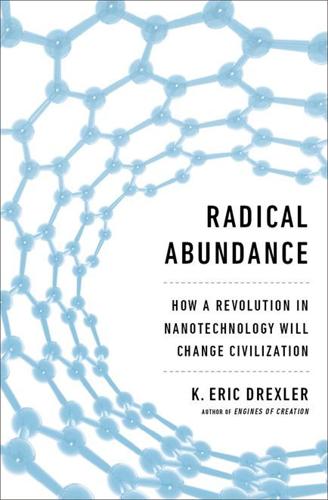
Radical Abundance: How a Revolution in Nanotechnology Will Change Civilization
by
K. Eric Drexler
Published 6 May 2013
The Oxford Martin School, a unique, interdisciplinary research community within Oxford University, has helped to provide that diversity. The school’s programs address twenty-first-century challenges and opportunities that range from economic development to nanomedicine, food, human rights, and the governance of geoengineering; I thank its director, Ian Goldin, for welcoming me for an extended stay, and Nick Bostrom for opening the door by inviting me to join the community at the Programme on the Impacts of Future Technology. Within that programme, I thank Nick along with Anders Sandberg, Toby Ord, Stuart Armstrong, Daniel Dewey, Seán Ó hÉigeartaigh, and others for more than a year’s worth of wide-ranging and challenging discussions.

Human Compatible: Artificial Intelligence and the Problem of Control
by
Stuart Russell
Published 7 Oct 2019
It will be able to suggest or carry out new experiments and expeditions to narrow down the inevitable uncertainties—for example, to discover the true extent of gas hydrates in shallow ocean reservoirs. It will be able to consider a vast range of possible policy recommendations—laws, nudges, markets, inventions, and geoengineering interventions—but of course it will also need to find ways to persuade us to go along with them. The Limits of Superintelligence While stretching your imagination, don’t stretch it too far. A common mistake is to attribute godlike powers of omniscience to superintelligent AI systems—complete and perfect knowledge not just of the present but also of the future.52 This is quite implausible because it requires an unphysical ability to determine the exact current state of the world as well as an unrealizable ability to simulate, much faster than real time, the operation of a world that includes the machine itself (not to mention billions of brains, which would still be the second-most-complex objects in the universe).
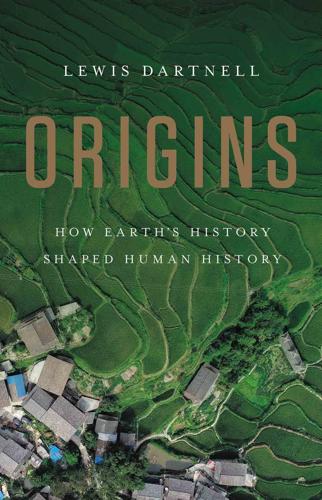
Origins: How Earth's History Shaped Human History
by
Lewis Dartnell
Published 13 May 2019
Przeworski (2016). ‘Variation in the molecular clock of primates’, Proceedings of the National Academy of Sciences 113(38): 10607–12. Morris, I. (2011). Why the West Rules–for Now: The Patterns of History and What They Reveal about the Future, Profile Books. Morton, O. (2016). The Planet Remade: How Geoengineering Could Change the World, Granta. Moylan, J. (2017). ‘First coal-free day in Britain since 1880s’, https://www.bbc.co.uk/news/uk-39675418. Murton, J. B., M. D. Bateman, S. R. Dallimore, J. T. Teller and Z. R. Yang (2010). ‘Identification of Younger Dryas outburst flood path from Lake Agassiz to the Arctic Ocean’, Nature 464(7289): 740–3.
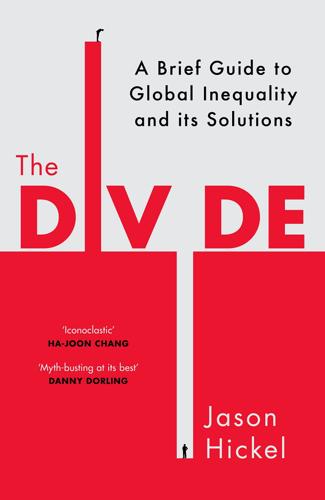
The Divide: A Brief Guide to Global Inequality and Its Solutions
by
Jason Hickel
Published 3 May 2017
We still need to get off fossil fuels as quickly as possible, and – most importantly – we have to kick our obsession with endless exponential growth and downsize our material economy to bring it back in tune with ecological cycles. But it might buy us some time to get our act together. I pick this example because it is fundamentally different to most of the other negative-emissions and geoengineering schemes out there, which end up embodying the very same logic that got us into this mess in the first place, treating Earth as something to be subdued and dominated. The solution to climate change won’t be found in the latest schemes to bend our living planet to the will of man. Perhaps instead it lies in something much more down to earth – an ethic of care and healing, starting with the soils on which our existence depends.
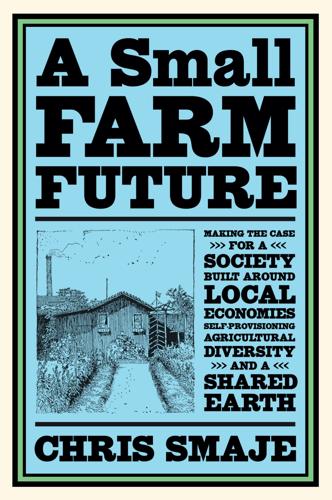
A Small Farm Future: Making the Case for a Society Built Around Local Economies, Self-Provisioning, Agricultural Diversity and a Shared Earth
by
Chris Smaje
Published 14 Aug 2020
Bradshaw, Corey, and Barry Brook. 2015. ‘Reply to O’Neill et al. and O’Sullivan: Fertility Reduction Will Help, but Only in the Long Term,’ PNAS 112(6): E508–9. Brand, Stewart. 2009. Whole Earth Discipline: Why Dense Cities, Nuclear Power, Genetically Modified Crops, Restored Wildlands, Radical Science and Geoengineering Are Essential. London: Atlantic Books. Brathwaite, Kamau. 2005. The Development of Creole Society in Jamaica 1770–1820. Kingston: Ian Randle. Bray, Francesca. 1986. The Rice Economies: Technology and Development in Asian Societies. Berkeley: University of California Press. Bregman, Rutger. 2017.

The Future of Fusion Energy
by
Jason Parisi
and
Justin Ball
Published 18 Dec 2018
It demonstrates our ability to select only the best that science has to offer, an invaluable habit for the future. After all, the ability of technology to both empower and diminish civilization is not limited to nuclear physics. Even if humanity escapes the nuclear age unscathed, the interlude will be temporary. Artificial intelligence, geo-engineering, and genetics are just a few examples of endeavors that pose great risks as well as great promise. Such is the price of progress. Our ability to handle the double-edged sword of nuclear energy will serve as a blueprint for the future. We must practice extracting the benefits of science, while suppressing its unsavory products.

Age of Discovery: Navigating the Risks and Rewards of Our New Renaissance
by
Ian Goldin
and
Chris Kutarna
Published 23 May 2016
And shock itself is the most compelling evidence that this age is very different, because it’s data that comes from within. Shock is our own personal proof of historic change—a psychic collision of reality and expectations—and it has been the relentless theme of all our lives. It agitates and animates us. It will continue to do so. Right now we don’t talk much about geo-engineering, organic energy, super-intelligent machines, bioengineered plagues, nano-factories or artificial human chromosomes, but someday soon—surprise!—it may seem that we talk about little else. We lack—and need—perspective We don’t know where we’re headed, and so we let ourselves get pushed around—bullied even—by immediate crises and the anxieties they evoke.
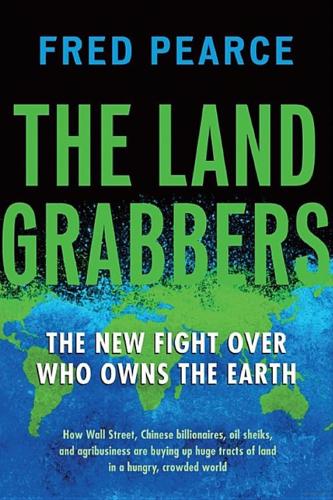
The Land Grabbers: The New Fight Over Who Owns the Earth
by
Fred Pearce
Published 28 May 2012
It is far from clear how many families will lose their land if the project is completed, but the Office du Niger must find new land for those farmers. Meanwhile, the project could require more water than the other three big foreign projects put together. The project was under way before the fall of Gaddafi. I saw contractors from the Chinese state-owned China Geo-Engineering Corporation constructing a large canal and road for the 25 miles from the river to the project area. They have already bulldozed orchards and fields, and divided villages in two. As I drove down the road, I noticed a family cultivating the thin strip of land between road and canal. They were growing onions to sell in the local village market.

Human Frontiers: The Future of Big Ideas in an Age of Small Thinking
by
Michael Bhaskar
Published 2 Nov 2021
The revolution is on track, but at this rate we'll get there in 400 years.105 Nowhere is the demand that we step up and deliver big new ideas more urgent than in the matter of planetary survival. There are a number of ideas that could work. A massive carbon tax. Radical change in consumption patterns in everything from travel to diet. Huge investment and rollout in carbon capture and storage. New pushes in agriculture and forestry. Blue sky technologies from fusion to, potentially, geoengineering. There is so much scope: just a few hours of the sunlight that falls on Earth would give us more energy than we need today; 20 per cent of global wind capacity is seven times more than we need.106 We've already looked at fusion power. We can regear our approaches to land, agriculture and the food supply chain; transform our materials superstructure and manufacturing base.
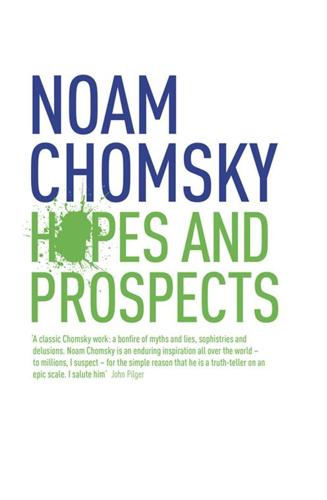
Hopes and Prospects
by
Noam Chomsky
Published 1 Jan 2009
It is finally dawning on the last holdouts in the business sector that the growing environmental crisis is severe. Even the Wall Street Journal, one of the most stalwart deniers, ran a supplement with dire warnings about the “climate disaster,” urging that none of the options being considered may be sufficient and it may be necessary to undertake more radical measures of geoengineering, “cooling the planet” in some manner.27 Many also understand that it will be necessary to reverse the vast state-corporate social engineering programs since World War II, designed to promote an energy-wasting and environmentally destructive fossil fuel–based economy, and that a central element of these changes will have to be development of efficient high-speed rail systems.
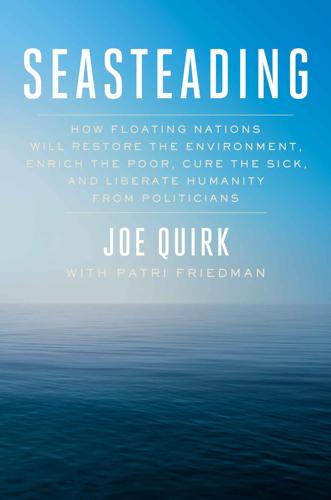
Seasteading: How Floating Nations Will Restore the Environment, Enrich the Poor, Cure the Sick, and Liberate Humanity From Politicians
by
Joe Quirk
and
Patri Friedman
Published 21 Mar 2017
P., 261 Gross, Bill, 237 Gross, Sue, 237 gross domestic product (GDP), 12, 193, 200–201, 206 calculating, 195–96 of Chinese provinces, 209, 274 global, 33, 295, 297, 299 of Mauritius, 195–96 and water bankruptcy, 67 Growing Blue, 5 growth cycle, see carbon cycle Gulf of Mexico, 51, 158, 166 Guns, Germs, and Steel: The Fates of Human Societies (Diamond), 125, 289 Haber, Fritz, 77 Haiti, 187 Hardin, Garrett, 106 Hard Minerals Act, 159–60 Hassig, Ralph, 187 Hawaii, 113, 114, 117, 151–52, 154, 155 HealthCare.gov, 246 Health Travel Technologies, 230 hearing impaired, 242 Heddon, Allison Hebron, 242, 243–50 Heddon, Chris, 241–50 Heinlein, Robert, 143 Hellmann’s, 135 Hess, Samuel, 240 Hickory Springs Manufacturing (HSM), 224 Hidden People of North Korea, The: Everyday Life in the Hermit Kingdom (Hassig & Oh), 187 high seas, 303–4 Hilbertz, Wolf, 178 Hispaniola, 187 hO2-Scraper, 172 Holland, see Netherlands Hong Kong, 166, 187–93, 194, 203 Hospitalist Company, 131 hotels, 20, 25, 26, 46, 173 houseboats, 34, 42 Housing and Urban Development Department, US, 24 “How China Became Capitalist” (Coase and Wang), 290 Huffington Post, 199, 227 hukou (Chinese discriminatory practice), 209 human genome, 122 Human Rights Foundation, 29 hunger, 65, 85, 98, 135 see also aquaculture; seaweed hunter-gatherers, 107 hurricanes, 158–59, 258 Hurricane Katrina, 166, 242 Illinois Soybean Association, 127 immigration and immigrants, 266–67, 268, 298, 299, 300 India: and food supply, 68, 69, 81 foreign investment in, 203 medical care in, 223, 227, 230–32, 234, 241 soil depletion in, 82 solar power plants in, 9 Indiegogo (crowdfunding website), 57 Indonesia, 86, 90, 269 Inhabitat (blog), 22 Inner Space Science Center, 170 Inouye, Daniel, 151 institutional review boards (IRBs), 248 Integrated Marine Agronomy and Geo-Engineering (IMAGEn), 123 International Convention for the Prevention of Pollution from Ships, 259 International Copper Association, 127 International Energy Agency (IEA), 131 International Laboratory for Global Change, 115 Internationally Recommended Transit Corridor (IRTC), 269–70 International Maritime Organization, 264 International Space Station, 151, 169 International Transport Workers’ Federation (ITF), 265 International Union for the Conservation of Nature, 127 International Water Week, 41 Internet, 78, 196, 230 Internet.org, 235 investors, 23, 26, 93, 95–96, 152, 153, 192, 197, 216 Invisible Wealth: The Hidden Story of How Markets Work (Kling & Schulz), 187 in vitro fertilization, 238 IPK International, 227 iron, 78, 98, 146 Iron Chef America, 98 islands and island nations: and algae biomass, 91 floating, 9, 52 for medical treatment, 10 regulating, 13 and seasteads, 269– 270 Israel, 226–27 Issenberg, Sasha, 227 JAMA Internal Medicine, 247 Janssen, Tim, 258 Japan, 9, 90, 155, 173–75, 186 Japan Aerospace Exploration Agency (JAXA), 179 Japan Times, 175 JASON Project, 162 Jefferson, Thomas, 260, 287, 290 Johnson, Lyndon B., 24 Johnson, Ted, 154–56 Joint Commission International (JCI), 223, 240 Joint Commission on Accreditation of Hospitals (JCAH), 240 Jones, Dave, 129–32, 134–35, 137, 139 Joosse, B.

The Terraformers
by
Annalee Newitz
There was no point in flying the hard route ahead if they couldn’t enjoy the day while it lasted. ACKNOWLEDGMENTS I wrote this book because I wanted to dream up a more hopeful world. And so my first thanks go to poet Stephanie Burt, who told me several years ago that I obviously needed to write an epic about nation-building. Kim Stanley Robinson, author of many geoengineering epics, told me (jokingly) that he would permit me to write about terraforming as long as I included a character named Kim, and so I have. Filmmaker Sonya Ballantyne spent quite a bit of time talking to me about Cree futurism, which is an undercurrent throughout this book, and later graciously did a sensitivity read on the whole manuscript.
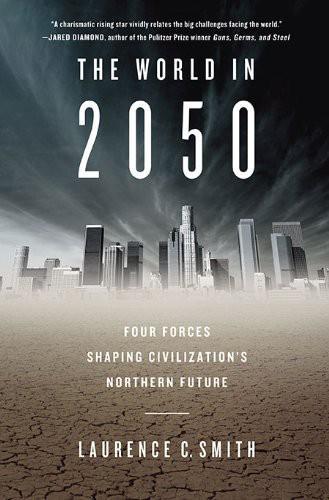
The World in 2050: Four Forces Shaping Civilization's Northern Future
by
Laurence C. Smith
Published 22 Sep 2010
Fast global communications facilitate global financial markets and trade. Modern health care and pharmacology are shifting population age structures in the developing world. Advances in biotech, nanotech, and materials science affect demand for different resource stocks. Smart grids, solar panels, and geoengineering might combat climate change, and so on. Under our “No Silver Bullets” rule, technological advances like these are evaluated as enablers or brake pads on the four global forces, rather than as an independent force of its own. The thought experiment is begun. Its assumptions and ground rules are stated, its four overarching themes defined.

Radical Technologies: The Design of Everyday Life
by
Adam Greenfield
Published 29 May 2017
Here we find failed civilization, on a planetary scale: societies panicking in the face of the first sharp shocks of climate violence collapse back into tribal allegiances and pseudoverities of blood and soil, and never meaningfully grasp any of the possibilities presented to them by new technology. The landscape is scoured and blasted by desperate attempts to jumpstart the engines of the economy. The last forests wither beneath the effect of misguided geoengineering projects intended to right the climate, and finally succumb to slash-and-burn farming. The oceans are anoxic, reeking, dying. The food web unravels in every direction at once; the human population bottlenecks, hard. Small communities persist—scattered, hungry pockets held together by sheer will and a fierce, almost religious commitment to one another.

The Man From the Future: The Visionary Life of John Von Neumann
by
Ananyo Bhattacharya
Published 6 Oct 2021
‘At long last,’ he continues, ‘we begin to feel the effects of the finite, actual size of the earth in a critical way.’ Courtesy of Marina von Neumann Whitman. Long before climate change became a widely discussed concern, the essay shows von Neumann was alert to the idea that carbon dioxide emissions from burning coal and oil were warming the planet. He favoured the idea of coming up with new geo-engineering technologies to control the climate by, for example, painting surfaces to change how much sunlight they reflect – quite likely the first time that anyone had talked about deliberately warming or cooling the earth in this way. Interventions such as these, he predicts, ‘will merge each nation’s affairs with those of every other, more thoroughly than the threat of a nuclear or any other war may already have done.’

Feral: Rewilding the Land, the Sea, and Human Life
by
George Monbiot
Published 13 May 2013
Another paper maintains that during the twentieth century the whaling industry shifted over 100 million tonnes of carbon from the oceans to the atmosphere, simply by turning whales into oil and other products that were burnt or otherwise oxidized.21 Allowing whale numbers to recover could be seen as a benign form of geo-engineering. The removal of the great sharks, which took place, on the whole, later than the destruction of the whale population, has had similarly devastating effects. Caught for their fins or accidentally by nets and lines set for other species, big sharks have vanished with astonishing speed. Off the eastern seaboard of the United States, for example, in the thirty-five years beginning in 1972, tiger sharks declined by 97 per cent, scalloped hammerheads by 98 per cent and bull sharks, dusky sharks and smooth hammerheads by 99 per cent.22 The result is an explosion of animals which no other species is big enough to eat: large rays and skates and smaller sharks.
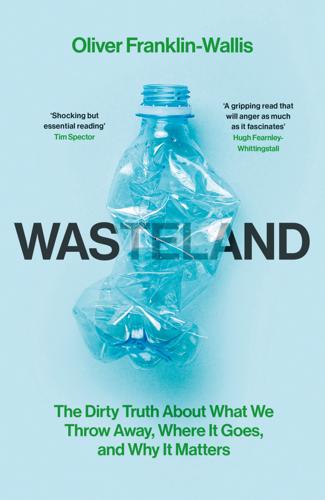
Wasteland: The Dirty Truth About What We Throw Away, Where It Goes, and Why It Matters
by
Oliver Franklin-Wallis
Published 21 Jun 2023
That was our culture,’ Rebecca told me, back at her office. ‘We made mountains that have been there for 2,000 years. That’s what I hope the Quapaw will do.’) This is how our waste outlives us: as the places we remake. Hills of garbage, hills of chat, tailings ponds. Waste as monument, waste as geoengineering. Rock, shifted unnaturally and drained of its former composition (that which we deem valuable, the Earth cares for little) will outlive even the hundred- and thousand-year timescale of landfills, so that in some distant future, if some cosmic force or tectonic break were to slice open this Earth like a birthday cake, the layers would be irrevocably altered by our presence.
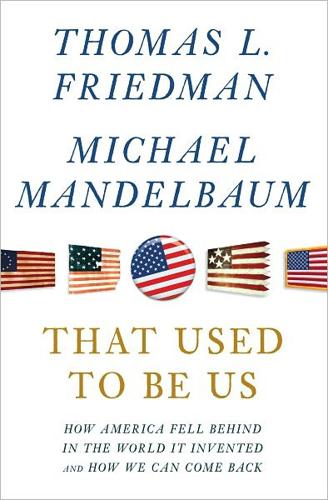
That Used to Be Us
by
Thomas L. Friedman
and
Michael Mandelbaum
Published 1 Sep 2011
Cheney’s instinct on nuclear weapons in the hands of rogue states is the right framework for thinking about the climate issue. It’s all a game of odds. We’ve never been here before, but we do know two things. First, the CO2 we put into the atmosphere stays there for several thousand years, so it is “irreversible” in real time (barring some not-yet-invented technique of geo-engineering to extract greenhouses gases from the atmosphere). And second, the CO2 buildup, if it reaches a certain point, has the potential to unleash “catastrophic” global warming—warming at a level that no humans have ever experienced. We do not know for sure (and cannot know until it is too late) that this will happen, but we do know that it could happen.
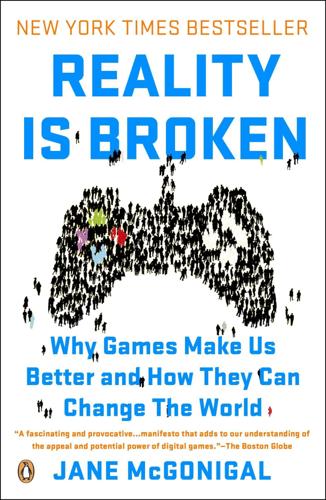
Reality Is Broken: Why Games Make Us Better and How They Can Change the World
by
Jane McGonigal
Published 20 Jan 2011
Sol is Latin for “sun,” and so the Spore community has translated this final message from the game as a playful imperative to remake our own Earth—which is, of course, the third rock from our sun. In the end, a win in Spore is a push back to the real world. Players are told, “Your gameplay has prepared you to become a real creator and protector of life on Earth.” Not by making them an expert in geoengineering, atmospheric science, or ecological planning, certainly, but rather by creating the seed of planetary creativity and activism. As Wright said at the Seed salon:All of the really tough problems we’re facing now are planetary problems. There’s real value in being pushed toward global awareness and looking long-term.

The Controlled Demolition of the American Empire
by
Jeff Berwick
and
Charlie Robinson
Published 14 Apr 2020
On average, about two Americans die each year from terrorism in the United States, yet the government would have the people to believe that there were head-chopping maniacs around every corner just waiting for them to put their guard down for two seconds.41 Where is the massive over-reaction by the government to what geoengineering is doing to the skies? There is not going to be one because they are involved in it. Where are the restrictions placed on the sale of GMO foods throughout the country? They are not coming because the agencies in place to handle something like this have been bought off by the lobbying companies hired by the Agra giants.

Aurora
by
Kim Stanley Robinson
Published 6 Jul 2015
Their feed did not include any basic system-wide background data, so the facts of the situation had to be inferred from the various strands of the feed, but it looked certain that on Earth the sea level was many meters higher than it had been when their ship had started its voyage, and the carbon dioxide level in Earth’s atmosphere was around 600 parts per million, having been brought down significantly from the time the ship had left, when it had been close to 1,000 ppm. That suggested carbon drawdown efforts, and there were sulfur dioxide distributions over the north polar region of Earth, indicating geoengineering was being attempted. Several hundred names for Terran nations had been collated from the news feed, and yet the list did not seem complete. There were many scientific stations on Mars, also in the asteroids; thousands of asteroids had been hollowed out and made into little spinning terraria. There were also many stations and even tented cities on the larger Jovian and Saturnian moons—all but Io, not surprising given its radiation levels.

Connectography: Mapping the Future of Global Civilization
by
Parag Khanna
Published 18 Apr 2016
From meteor strikes to the ice ages, geophysical phenomena have profoundly shaped mankind. The fundamental geology of plate tectonics is always in motion, with earthquakes and tsunamis constantly shifting coastlines. But mankind is fighting back with technologies such as land reclamation, sea barriers, and earthquake resistant architecture. Geo-engineering techniques such as carbon dioxide removal and solar radiation management may even allow us to slow climate change. Map 38, corresponding to this chapter, appears in the map insert. But technological prowess and resource abundance should not lead to hubris. Anthropologists such as Jared Diamond have asserted that the Rapa Nui people of Easter Island committed ecological suicide through rapid deforestation (using trees to transport their massive stone statues known as moai) and the resulting soil erosion that made the island agriculturally unsustainable.

Fancy Bear Goes Phishing: The Dark History of the Information Age, in Five Extraordinary Hacks
by
Scott J. Shapiro
Proponents of nuclear power assign it high benefits and low costs. Opponents of nuclear power make the converse judgment: low benefits and high risks. In reality, however, benefits and risks tend to be directly correlated. Nuclear power is controversial precisely because the benefits and the costs are significant. The same is true for pesticide use, geoengineering to combat climate change, and genetically engineered crops. The Affect Heuristic reduces the cognitive dissonance of our having to balance high benefits with high costs. It is much easier going through life thinking that choices are easier than they really are. Studies have shown that time pressure greatly magnifies the role of affect in decision-making.

Hope Dies Last: Visionary People Across the World, Fighting to Find Us a Future
by
Alan Weisman
Published 21 Apr 2025
You, Xiaoying. “Could Giant Underwater Curtains Slow Ice-Sheet Melting?” Nature, January 17, 2024. https://www.nature.com/articles/d41586-024-00119-3. Zimmer, Katarina. “The Daring Plan to Save the Arctic Ice with Glass.” BBC, September 23, 2020. https://www.bbc.com/future/article/20200923-could-geoengineering-save-the-arctic-sea-ice#. Chapter Three: Food from Thin Air Books Brosig, Max, Parker Frawley, Andrew Hill, Molly Jahn, et al. Implications of Climate Change for the U.S. Army. Carlisle, PA: US Army War College, 2019. Articles Air Protein. https://airprotein.com. Andersen, Suzanne Z., Viktor Čolić, Sungeun Yang, Jay A.
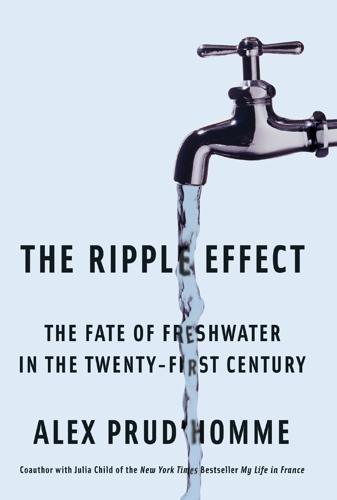
The Ripple Effect: The Fate of Fresh Water in the Twenty-First Century
by
Alex Prud'Homme
Published 6 Jun 2011
Economists have suggested using a cap-and-trade system for nitrogen polluters, based on that used for carbon—an approach to control pollution by setting limits, or a cap, on how much pollution can be emitted by factories. Companies that are big polluters can buy additional pollution credits from those that pollute less; in effect, buyers pay to pollute and the sellers are rewarded for reducing emissions. Some nations are exploring so-called geoengineering solutions: large-scale human intervention into natural systems, such as bubbling air into bays, to stir up the hypoxic water. Biotech companies are trying to engineer technologies to keep nitrogen fixed in the soil. Others are trying to develop nitrogen-use efficiency (NUE) technology, which allows plant roots to absorb more nitrogen before it gets washed away.
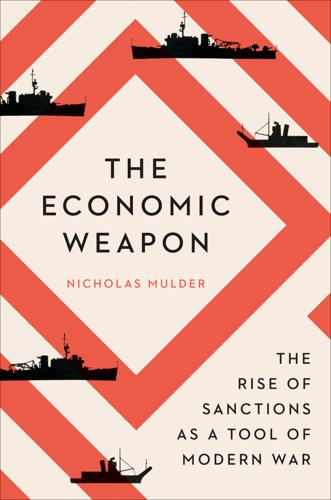
The Economic Weapon
by
Nicholas Mulder
Published 15 Mar 2021
Coal production remained insufficient to fulfill national demand; the difference was made up by imports from Germany, continental Europe’s largest coal producer. Fascist coal policy focused on the Sulcis region of southwestern Sardinia. In this swampy and malaria-infested backwater, the Carbosarda company, led by Guido Segre, had first begun developing coal mines in the summer of 1935. Earlier geo-engineering projects, especially the 1932 settlement of the Pontine Marshes, set the tone.67 After the imposition of League sanctions, Mussolini accelerated attempts to transform the Sulcis region into an “Italian Ruhr.”68 Segre’s new coal company, the Azienda Carboni Italiani (A.Ca.I), began building a new town around the Sulcis coal field, which was officially founded on 5 November 1937 as Carbonia, the city of coal.69 Architects designed a town that soon began to receive migrants from Veneto, the Marche, Sicily, and Abbruzzo.

Free Speech: Ten Principles for a Connected World
by
Timothy Garton Ash
Published 23 May 2016
Boyd, Danah. 2014: It’s Complicated: The Social Lives of Networked Teens. New Haven: Yale University Press. Boyd, Julian P., ed. 1950 [1787]: The Papers of Thomas Jefferson. Volume 11. Princeton: Princeton University Press. Brand, Stewart. 2010: Whole Earth Discipline: Why Dense Cities, Nuclear Power, Transgenic Crops, Restored Wildlands, Radical Science, and Geoengineering Are Necessary. London: Penguin. Brettschneider, Corey. 2012: When the State Speaks, What Should It Say? How Democracies Can Protect Expression and Promote Equality. Princeton: Princeton University Press. Briggs, Rachel, and Feve, Sebastien. 2013: Review of Programs to Counter Narratives of Violent Extremism.

Zbig: The Life of Zbigniew Brzezinski, America's Great Power Prophet
by
Edward Luce
Published 13 May 2025
She expected to be waited upon. Muska usually obliged. Tadeusz, on the other hand, was turning into even more of a gentle soul with age. He bore no trace of bitterness about his lost Polish world. Their youngest, Lech, had graduated from McGill in engineering and the University of Illinois in geoengineering and taken a job at SNC-Lavalin, a Montreal-based engineering company. He had married a Polish medical student, Wanda Kotanski, whom he met on a visit to Warsaw in the early 1960s. Wanda set up her own medical practice in Montreal. George, Zbigniew’s half brother and Leonia’s firstborn, was struggling to make ends meet and in the process of divorce.

Growth: From Microorganisms to Megacities
by
Vaclav Smil
Published 23 Sep 2019
These attempts often fail even as they succeed (and seemingly permanent mastery may turn out to be only a temporary success) but they never end: we can see them pursued at both extreme ends of the size spectrum as scientist try to create new forms of life by expanding the genetic code and including synthetic DNA in new organisms (Malyshev et al. 2014)—as well as proposing to control the Earth’s climate through geoengineering interventions (Keith 2013). Organismic growth is a product of long evolutionary process and modern science has come to understand its preconditions, pathways, and outcomes and to identify its trajectories that conform, more or less closely, to specific functions, overwhelmingly to S-shaped (sigmoid) curves.

Reamde
by
Neal Stephenson
Published 19 Sep 2011
They were at most five minutes behind her: a sufficient head start to keep her alive in the dense forest down below, but, up here, just enough to make it a challenging shot. She snapped her head back around to scan the slope above her, hoping she might see a place to take cover. In most ways, this place could not have been worse. During her geoengineering studies, she had learned all about the angle of repose, which was the slope that a heap of particulate matter naturally adopted over time; it explained the shape of an anthill, a mound of sugar, a pile of gravel, or a mountain of scree. The angle was different for each type of material. Its exact value was not important here.